auch interessant ...
| Tim Bernardes: "Mil Coisas Invisiveis" (Psychic Hotline, Nov. 2022) |
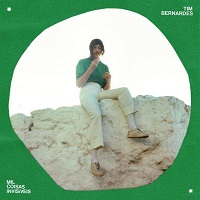

 Mehr ...
Mehr ...
Tim Bernardes, ein fÞr den Latin Grammy nominierter SÃĪnger, Songwriter, Musiker, Komponist und Produzent aus Sao Paulo, Brasilien, hat ein weltweites Publikum mit seiner delikaten Balance zwischen KlÃĪngen, die in der brasilianischen Tradition verwurzelt sind, und zeitgenÃķssischem Indie und Folk in seinen Bann gezogen, die zutiefst warm, intim, emotional und heilend ist.
Er hat mit KÞnstlern wie den Fleet Foxes, Tom ZÃĐ, David Byrne, Gal Costa, Devendra Banhart, Shintaro Sakamoto und vielen anderen zusammengearbeitet. Mil Coisas InvisÃveis ist sein zweites Soloalbum nach seinem 2017 erschienenen DebÞt Recomeçar. Das Album entstand vor allem wÃĪhrend der Tournee mit seiner gefeierten Tropicalia-Indie-Gruppe O Terno und auf dem Weg ins Jahr 2020, als er beschloss, sich vom Touren zurÞckzuziehen und sich auf neue Songs zu konzentrieren. Herausgekommen ist ein Album, das groÃzÞgig und intim ist - eine Reihe von Meditationen Þber metaphysische Transformation im Angesicht groÃer Unsicherheit. ÂŧIch hoffe, dass ich eines Tages nur ein Zehntel so gut singen und Songs schreiben kann wie Tim BernardesÂŦ robin Pecknold, Fleet Foxes ÂŧEin Wunder der Abstimmung, der Dynamikkontrolle, der Raffinesse, der instrumentalen AusfÞhrung und der Freiheit in der Eleganz des BÞhneneinsatzesÂŦ, Caetano Veloso ÂŧBernardes' Stimme ist wahrhaftig vom FeinstenÂŦ.
... Ãhnlich zeitgenÃķssisch geht Tim Bernardes zur Sache. Sein neues Album "Mil Coisas InvisÃveis" (Psychic Hotline) ist so etwas wie die Antipode zum sprudeligen Album von Bala Desejo. Er dreht die "Saudade" der brasilianischen Musik in eine universelle Melancholie, die an die intellektuellen Seiten des Indie-Folk aus dem Norden andockt. Da hat er auch lÃĪngst schon einen guten Stand. Die Fleet Foxes haben ihn schon ins Studio geholt, Devendra Banhart und David Byrne. Auf dem Album hat er fast alles selbst gemacht. Viel Nylonsaiten-Gitarre, Klavier, eine Plektrum-gezupfte Bassgitarre, wie sie Carol Kaye auf den spÃĪten Beach-Boys-Platten spielte, und Orchesterarrangements, die in ihrer Sparsamkeit auf einen ÃĪsthetisch tadellosen Schwebezustand abzielen. Dieser Minimalismus in Perfektion gibt seiner Stimme genau den Raum, den sie braucht fÞr all die Dynamik und EmotionalitÃĪt. Bernardes beherrscht Miles Davis' Credo, dass alles, was man nicht spielt, mindestens so wichtig ist, wie alles, was man spielt. Auch wenn Jazz bei ihm und seinen Zeitgenossen meist nur ein Nachgedanke ist. Aber das war er im Bossa Nova irgendwann auch.
(www.sueddeutsche.de)
|
| Flora Purim: "If You Will" (Strut, April 2022) |
 [Return To Forever |
Open Your Eyes, You Can Fly]
[Return To Forever |
Open Your Eyes, You Can Fly]

 Mehr ...
Mehr ...
Flora Purim, eine der ganz GroÃen des brasilianischen Jazz-Fusion, kehrt mit ihrem ersten Studioalbum seit Þber 15 Jahren zurÞck: ÂŧIf You WillÂŦ, erschienen Þber Strut.
Das Album ist als Feier ihrer Musik und ihrer Zusammenarbeit konzipiert und enthÃĪlt neben neuen Kompositionen auch neue Versionen von Floras persÃķnlichen Lieblingssongs und positiven Texten aus ihrer abwechslungsreichen Karriere.
ÂŧIf You WillÂŦ ist ein weiters Kapitel des Umbruchs in Floras langer, illustrer und abwechslungsreicher Karriere. Neben ihrer gefeierten Partnerschaft mit Airto und ihrer frÞhen Zeit mit dem Quarteto Novo hat Flora mit Stan Getz, Gil Evans, Miriam Makeba, George Duke, Chick Corea (als GrÞndungsmitglied von Return To Forever), Dizzy Gillespies United Nation Orchestra, der uruguayischen Band Opa und vielen anderen zusammengearbeitet. Ihre Soloalben bei Milestone sind echte Jazz-Fusion-Klassiker.
|
| Rodrigo Amarante: "Drama" (Polyvinyl, Juli 2021) |
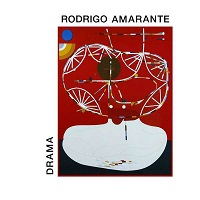 [Cavalo]
[Cavalo]

 Mehr ...
Mehr ...
Zweites Solowerk des brasilianischen Musikers Rodrigo Amarante, bekannt fÞr den Titelsong Tuyo der Netflix-Serie Narcos, als Mitglied von Orquestra Imperial, Los Hermanos, der Rough Trade-Band Little Joy (mit Fab Moretti von The Strokes & Bikini Shapiro), sowie als Komponist fÞr Gal Costa, Norah Jones und Gilberto Gil.
Im Gegensatz zu seinem SolodebÞt Cavalo (2014) ist Drama karikaturistisch, filmisch, parteiisch wie die Erinnerung. Die Songs fliessen im Bogen, spielerisch tÃĪuschend, wie ein MÃĪrchen. Der ominÃķse Opener/Titelsong lÃĪsst erahnen, dass die Dinge vielleicht nicht so sind, was sie zu sein scheinen, und dass sich Hinweise im Verborgenen verstecken.
Since releasing the sublime Cavalo in 2014, Brazilian singer/songwriter Rodrigo Amarante has earned some well-deserved North American hype thanks to the evocative "Tuyo," which he wrote as the theme song for Netflix's drug cartel drama Narcos. A creaky, string-decorated bolero sung in Spanish, it's a typically eclectic offering from an artist who is hard to pin down. Weaving and winding through an array of beguiling rhythms, languages, and tones, Amarante's second album, Drama, moves between flair and subtlety with a casual grace that feels timeless. From the melodramatic strings-meet-laugh track dichotomy of the opening instrumental to its deceptively breezy art-pop counterpart "MarÃĐ," Amarante casts a spell that remains unbroken for the album's duration. The swooning bossa nova of "Tara" gives way to the haunting clamor of "I Can't Wait," one of several English language cuts from the now Los Angeles-based singer. With its growling horn stacks, "Tao" lays down an inescapable groove and represents Drama at its most muscular. More than anything, Amarante feels like a TropicÃĄlia artist for the 21st century, artfully fusing Brazilian and Latin American traditions to progressive songwriting and arrangements that touch on pop, psychedelia, folk, and rock. Like a consummate craftsman he folds unexpected details into the whole without a lot of fanfare, which lends the album an undercurrent of excitement and even tension. Leaving the listener with a sense of sweet melancholia, Amarante wraps up with "The End," a dusty-voiced piano ballad that serves as the closing credits to Drama's captivating journey.
(by Timothy Monger, All Music Guide)
|
| Ricardo Richaid: "Travesseiro Feliz" (Far Out, April 2020) |


 Mehr ...
Mehr ...
Far Out prÃĪsentiert das DebÞtalbum von Ricardo Richaid, Tontechniker und Produzent aus Rio de Janeiro, der mit vielen Brazil-GrÃķÃen (wie Caetano Veloso, Arthur Verocai, Joyce, Ivan Lins, Marcos Valle, Azymuth, Hermeto Pascoal) zusammengearbeitet hat.
Deren musikalische Inspirationen vermengt Ricardo mit Elementen aus Psychedelia, Jazz und Rock zu einem modernen Brazil-Sound, der er mit Top-Musikern wie dem Percussionisten Marcos Suzano (Gilberto Gil), der Experimental-Pop-KÞnstlerin Ana Frango Eletrico und dem Vokalisten und Multiinstrumentalisten Jose Ibarra aufgenommen hat.
|
| Marcos Valle: "Sempre" (Far Out, Juli 2019) |
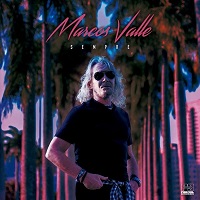

 Mehr ...
Mehr ...
ïŧŋ
Brazil-Legende Marcos Valle feiert seit Mitte der 1990er auf Far Out Recordings seinen zweiten, musikalischen FrÞhling und prÃĪsentiert mit ÂŧSempreÂŦ sein brandneues Album, aufgenommen mit erstklassigen Musikern wie Alex Malheiros (Azymuth), Trompeter Jesse Sadoc und Percussion-Meister Armando Marcel.
ÂŧSempreÂŦ bietet brasilianische Feel-Good/Party-Musik zwischen Disco-Exstase, Cosmic-Samba und Late-Night-Jazz-Funk und erinnert an Valles erfolgreiche SpÃĪt-1970er/FrÞh-1980er Phase.
|
| Ed Motta: "Criterion Of The Senses" (Membran, Sept. 2018) |
 Diesen Musiker aus Brasilien habe ich erst vor wenigen Monaten fÞr mich entdeckt: eigentlich
mÞsste ich sagen: nett gemacht, aber das klingt ja alles wie bei Steely Dan!,
aber wenn ich in mich hineinhÃķre, dann bin ich total begeistert von dieser brasilianischen Transzendierung
der Kunst von Walter Becker & Donald Fagen. Ich freue mich schon kolossal auf das Konzert im November!
Diesen Musiker aus Brasilien habe ich erst vor wenigen Monaten fÞr mich entdeckt: eigentlich
mÞsste ich sagen: nett gemacht, aber das klingt ja alles wie bei Steely Dan!,
aber wenn ich in mich hineinhÃķre, dann bin ich total begeistert von dieser brasilianischen Transzendierung
der Kunst von Walter Becker & Donald Fagen. Ich freue mich schon kolossal auf das Konzert im November!
(03.10.2018)
Konzerthighlight: Ledigenheim, Dinslaken-Lohberg, 18.11.2018
Das war fÞr mich eines der besten Konzerte der letzten Jahre, die der gute Ed mit seiner
europÃĪischen Band (deutscher Pianist, franzÃķsischer Bassmann,
hollÃĪndischer Drummer und finnischer Gitarrist) da in diesem tollen Konzertsaal gespielt hat.
Selten habe ich eine Band mit einer solchen Mischung aus technischer Perfektion und extrem viel
GefÞhl erleben kÃķnnen.
(20.11.2018)

 Mehr ...
Mehr ...
ïŧŋ
Es ist das dreizehnte Album des SÃĪngers und Multiinstrumentalisten und seine RÞckkehr zum ÂŧAORÂŦ.
Es sind nur acht StÞcke, diskrete vierzig Minuten und somit perfekt fÞr zwei LP-Seiten, aber jeder einzelne Song des Albums ist ein Klang-Universum. Das Klangspektrum reicht von Soul Þber Fusion bis Funk und Soft Rock, leidenschaftlich eingespielt und produziert im Estudio Marini, Studio A Casa und Ed Mottas eigenem Dwitza, allesamt in Rio de Janeiro.
Die anderen Musiker auf dem Album geben den ausnahmslos von Ed Motta komponierten, getexteten, arrangierten und produzierten StÞcken mit ihren Soli und auch im eng verzahnten Ensemble-Spiel genau die sinnliche QualitÃĪt, die er selbst als ZuhÃķrer schÃĪtzt.
ÂŧGroÃartige Platte â ein wÞrdiger Nachfolger zu âšPerpetual Gatewaysâđ (2016).ÂŦ
(Audio, Oktober 2018)
|
| Kassin: "Relax" (Luaka Bop, Mai 2018) |
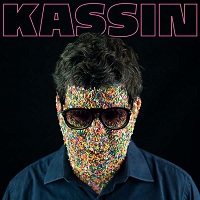 Fast zeitgleich mit Schlagzeuger Domenico Lancellotti hat auch Bassist
Alexandre Kassin, sein alter Bandkumpan aus "+2"-Tagen, sein neues Album bei
David Byrnes Label verÃķffentlicht ...
Fast zeitgleich mit Schlagzeuger Domenico Lancellotti hat auch Bassist
Alexandre Kassin, sein alter Bandkumpan aus "+2"-Tagen, sein neues Album bei
David Byrnes Label verÃķffentlicht ...
(04.08.2018)

 Mehr ...
Mehr ...
ïŧŋ
Alexandre Kassin ist ein brasilianischer Musikproduzent, Komponist, Multiinstrumentalist und SÃĪnger. Er wurde 1974 in Rio de Janeiro geboren und zÃĪhlt mittlerweile zu den bekanntesten KÃķpfen der heimischen Pop-Szene. In seiner langen Karriere hat Kassin bereits Þber 100 Alben produziert, unter anderem fÞr Marisa Monte und Bebel Gilberto. Auch Sean O'Hagan (Stereolab, High Llamas) stand er schon produktiv zur Seite. Konzerte von Caetano Veloso begleitete Kassin als Bassist. AuÃerdem ist er Leiter der Band Orquestra Imperial. Mit Moreno Veloso und Domenico Lancelotti grÞndete Kassin die Gruppe +2. In jungen Jahren erstellte er ein Album, das allein auf den TÃķnen eines Gameboy basierte.
Sein aktuelles Werk ÂŧRelaxÂŦ wartet hingegen mit einem breiten, vor allem sehr zugÃĪnglichen stilistischen Spektrum auf. Ãber elf StÞcke hinweg flirtet Kassin ganz entspannt mit tanzbaren sÞdamerikanischen Rhythmen, brasilianischem Pop und Soul. Dabei gibt er erfundene Geschichten Þber den Tod, Drogenmissbrauch, Politik und das Schicksal zum Besten.
Das macht ÂŧRelaxÂŦ zu einem surreal-dichotomischen Erlebnis: den leichtfÞÃigen tropischen Arrangements stehen recht schwere Inhalte gegenÞber. FÞr Kassin zeigt sich darin das Yin und Yang des brasilianischen Alltags - nichts ist gewiss.
For more than two decades, Alexandre Kassin has left an indelible mark on Brazilian popular music. From his involvement in the near-mythical Acabou La Tequila in the mid-'90s to his collaborative membership in +2 with Moreno Veloso and Domenico Lancellotti, to dozens of production, songwriting, and sideman gigs -- including work with Caetano Veloso, Marisa Monte, Bebel Gilberto, and Erasmo Carlos -- he is among the most influential members of Brazil's music fraternity. Relax is only Kassin's second solo album; it follows his debut, Sonhando Devagar, by six years. Where the former celebrated blissed-out dreaminess, Relax revolves around the mundanities, tragedies, and absurdities of waking life.
There is much to link Relax with its predecessor musically. Kassin employs several of the same collaborators and utilizes just as many styles here, from disco, funk, and jovem garda, to samba torto (crooked samba), neo-bolero, bossa nova, and pop. Several tunes have seen the light in different versions before. "Estricnina" ("Strychnine Love") was first recorded in 2000 with vocals by Rio de Janeiro's Toni Plato. Here it's driven by a spooky organ, drums, and guitars, Kassin rips at the seam where new bossa meets jovem garda; his bassline and droll singing are backed by a haunted B-3 and skittering breakbeat snares. An instrumental version of "O Anestesista" (a "math bossa") was issued in 2017 on Visitantes Nordestinos by Mitch & Mitch -- Kassin played on and produced it. His take here offers his singing up front delivering darkly humorous lyrics (translated by Arto Lindsay) requesting a medical professional give him nitrous oxide during life's more difficult moments. Closer "Enquanto Desaba o Mundo" was written by Kassin for ZabelÊ, who cut it on her self-titled solo debut in 2015, which was produced and mixed by his +2 bandmates.
The title track, penned with Alberto Continentino, is a sideways tribute to production duo of Robson Jorge and Lincoln Olivetti; it borrows the bassline from Hall & Oates' "She's Gone" and adorns its backdrop with a gorgeous Gil Evans-esque horn chart atop a fluid disco beat. Single "Momento de Clareza" is almost pure tropical disco (complete with a chunky Nile Rodgers-inspired guitar line). The breezy "Didgeridoo," co-written with Sean O'Hagan, is a samba whose lyrics are drenched in cannibalism, complete with dead meat being chewed, digested, and evacuated -- it's a metaphor for the end of a relationship. "A Paisagem Morta" references the influence of Frank Zappa's "Peaches en Regalia" by way of Barry White and Marcos Valle; it's one of the more sensual things here. "Sua Sugestao" melds bossa nova and jovem garda rock, while "A Paisagem Morta" is an achingly beautiful tune about the ghosts left behind after a relationship dies; its fragile poetic lyrics are made more resonant with elegant trombones, Lancellotti's slippery snares, cascading pianos, and a mellotron. Despite its sometimes bittersweet (and perverse) lyrics, Relax is pure retro summer fun. Its imagination, execution, and restless carioca grooves make it a necessary addition to any Brazilian music fan's collection.
(by Thom Jurek, All Music Guide)
|
| Hamilton De Holanda Quinteto: "Casa de Bituca - The Music of Milton Nascimento" (Edel/MPS, Juli 2017) |
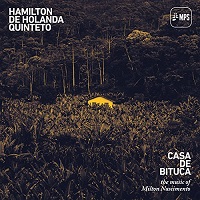 Ein virtuoss und spannendes Jazzquintett aus Brasilien! Statt der bei normalen JazzfÞnfern
Þblichen Frontline bestehend aus Tenorsaxofon und Trompete gibt es hier die 10saitige Mandoline
des Bandleaders und die virtuose chromatische Mundharmonika von Gabriel Grossi zu
hÃķren. Das Fundament darunter legen eine typisch brasilianische Bossa-Nova-Gitarre, sowie Schlagzeug und E-Bass.
Die Lieder stammen natÞrlich alle vom legendÃĪren Milton Nascimento,
der auch als singender Gast vorbeigeschaut hat. Das alles wurde vom ebenfalls legendÃĪren
MPS-Label aus dem Schwarzwald verÃķffentlicht. Ach ja - die CD kommt mit einer DVD daher,
auf der alle (?) Titel auch als Livemitschnitte aus dem Studio zu sehen und zu hÃķren sind.
Ein virtuoss und spannendes Jazzquintett aus Brasilien! Statt der bei normalen JazzfÞnfern
Þblichen Frontline bestehend aus Tenorsaxofon und Trompete gibt es hier die 10saitige Mandoline
des Bandleaders und die virtuose chromatische Mundharmonika von Gabriel Grossi zu
hÃķren. Das Fundament darunter legen eine typisch brasilianische Bossa-Nova-Gitarre, sowie Schlagzeug und E-Bass.
Die Lieder stammen natÞrlich alle vom legendÃĪren Milton Nascimento,
der auch als singender Gast vorbeigeschaut hat. Das alles wurde vom ebenfalls legendÃĪren
MPS-Label aus dem Schwarzwald verÃķffentlicht. Ach ja - die CD kommt mit einer DVD daher,
auf der alle (?) Titel auch als Livemitschnitte aus dem Studio zu sehen und zu hÃķren sind.
(19.01.2018)

 Mehr ...
Mehr ...
ïŧŋ
Das neue Album des ECHO Jazz 2017 Gewinners ist einem der bedeutendsten brasilianischen Singer-Songwriter gewidmet: Milton Nascimento.
Mit dieser Aufnahme feiert das Qunitett auÃerdem sein 10-jÃĪhriges Bestehen. Neben seinem Einfluss in der brasilianischen Musik seit den Clube da Esquina-Jahren ist Milton Nascimento auch eine Referenz fÞr internationale Stars wie Paul Simon, Wayne Shorter, Herbie Hancock, Pat Metheny, Esperanza Spalding und die legendÃĪre Gruppe Earth, Wind & Fire, um nur einige zu nennen.
Jede Aufnahme von Hamilton de Holanda ist eine groÃe Ãberraschung, denn als einer der besten Instrumentalisten Brasiliens zeigt er immer wieder aufs Neue seine Einzigartigkeit und Vielseitigkeit. Auf Casa de Bituca sind mit Milton Nascimento und dem legendÃĪren Samba-Star Alcione ganz besondere GÃĪste zu hÃķren. Hamilton selbst singt auch zum ersten Mal ein ganzes Lied, Mar da Indiferença, eine Komposition seines langjÃĪhrigen Partners Marcos Portinari.
Die Aufnahmen wurden zudem als Videos mitgeschnitten, die als DVD beiliegen
Ein geradezu magisches Zusammentreffen, das alle Beteiligten im hellsten Licht erstrahlen lÃĪsst.
(Musikwoche, 30.06.2017)
Ein vorgezogenes Geburtstagsgeschenk der feinsten Sorte. Und wir dÞrfen mitfeiern.
(Michael Laages, NDR Info, 22.06.2017)
Umwerfende Hommage an Landsmann und KultsÃĪnger Milton Nascimiento.
(Tonart, Sommer 2017)
Wenn Hamilton de Holanda die zehnsaitige Konzertmandoline zupft, tut sich in der Tat eine Welt auf, in der es harmonischer, gesÞnder, ausgeglichener zugeht.
(Fono Forum, 08 / 2017)
Hamilton de Holanda spielt Nascimientos Songs nicht orginalgetreu nach, seine Versionen klingen jazziger.
(TAZ, 10.07.2017)
Dabei wandelt er besonders schÃķn die breitwandige Melancholie und SpiritualitÃĪt, die Nascimentos Werk durchziehen, in kammermusikalischen Swing.
(Rolling Stone, Juli 2017)
De Holanda versteht es hier, diese so einzigartige Musik seines Landsmannes intelligent zu interpretieren, sie auf seine sparsame Art in einem anderen Licht erstrahlen zu lassen.
(Jazzthetik, September 2017)
|
| Domenico Lancellotti: "The Good Is A Big God" (Luaka Bop, Mai 2018) * "Serra dos ÃrgÃĢos" (LAB344, Juni 2017) |
 Etwas verwirrend ist fÞr mich, ob das neue Album "The Good Is A Big God" des
brasilianischen Schlagzeugers, SÃĪngers und Songschreibers Domenico (der Nachname blieb
bei bisherigen VerÃķffentlichungen weg) wirklich neu ist.
Neben dieser Ausgabe auf dem Label von Ex-Talking Head David Byrne gab es mit anderem
Titel (auf Portugisisch) und leicht geÃĪndertem Cover schon eine Version in Brazilien und Japan (!) im letzten Sommer.
Im Grunde kann uns das aber egal sein, denn (1.) gibt es jetzt wohl erstmalig eine Vinylausgabe
und (2.) beziehen sich beide Alternativtitel jeweils auf unterschiedliche Lieder der gleichen Platte,
die eben in Portugisisch oder in Englisch gesungen sind.
Etwas verwirrend ist fÞr mich, ob das neue Album "The Good Is A Big God" des
brasilianischen Schlagzeugers, SÃĪngers und Songschreibers Domenico (der Nachname blieb
bei bisherigen VerÃķffentlichungen weg) wirklich neu ist.
Neben dieser Ausgabe auf dem Label von Ex-Talking Head David Byrne gab es mit anderem
Titel (auf Portugisisch) und leicht geÃĪndertem Cover schon eine Version in Brazilien und Japan (!) im letzten Sommer.
Im Grunde kann uns das aber egal sein, denn (1.) gibt es jetzt wohl erstmalig eine Vinylausgabe
und (2.) beziehen sich beide Alternativtitel jeweils auf unterschiedliche Lieder der gleichen Platte,
die eben in Portugisisch oder in Englisch gesungen sind.
Aufgenommen wurde in Brasilien und in England, Sean O'Hagan von den High Llamas
ist als Musiker und Co-Produzent involviert, ebenso Domenicos (Ex-?)Kollegen Moreno Veloso
und Kassin. Insgesamt die beste Verquickung von Brasilien und Europa,
die ich seit langem gehÃķrt habe.
(23.07.2018)

 Mehr ...
Mehr ...
ïŧŋ
Domenico Lancellotti ist ein brasilianischer SÃĪnger, Schlagzeuger, Multiinstrumentalist und Komponist. Er wurde 1972 in Rio de Janeiro geboren. Sein Vater ist der bekannte Komponist Ivor Lancellotti. In der Vergangenheit kollaborierte Lancellotti bereits mit vielen namhaften KÞnstlern der MÚsica Popular Brasileira, darunter Adriana Calcanhotto, Marcos Valle, Fernanda Abreu und Caetano Veloso.
Insbesondere die Zusammenarbeit mit Letzterem ist naheliegend, da Lancellotti mit dessen Sohn Moreno Veloso sowie Alexandre Kassin das Aufsehen erregende Trio +2 bildete. Zu weiteren bekannten Projekten Lancellottis gehÃķren Orchestra Imperial und Ritmistas. Das reflektierte Samba-Album ÂŧThe Good Is A Big GodÂŦ ist inspiriert von einer Reise durch den brasilianischen Nationalpark The Serra dos ÃrgÃĢos.
Es erscheint bei David Byrnes Label Luaka Bop und wurde durch die Mitarbeit von Nina Miranda, Moreno Veloso, Alexandre Kassin, Pedro SÃĄ und vor allem Sean O'Hagan (Stereolab, High Llamas) geprÃĪgt. Letzteren lernte Lancellotti im Rahmen des Kulturprogramms der Olympischen Spiele 2012 in London kennen. Seitdem stand man in einem kreativen Austausch und schickte sich die Soundfiles Þber den Atlantik hin und her.
|
| "The Rough Guide To Psychedelic Samba" (World Music Network, Apr. 2016) |
 Ob jetzt Psychedelic Samba der passende Oberbegriff fÞr all die
tollen Bands und Einzelinterpretren auf dieser Zusammenstellung ist, das sei mal dahingestellt.
Mir bekannt war bisher auf jeden Fall nur Marcus Valle, der es mit seinem Lied leider
nicht auf die mit knapp Þber 12⎠recht gÞnstige Schallplatte, sondern nur auf die CD-Ausgabe geschafft
hat. Besonders gut gefiel mir noch die Band Sexy Fi, von der ich mir umgehend das
komplette Album besorgt habe ...
Ob jetzt Psychedelic Samba der passende Oberbegriff fÞr all die
tollen Bands und Einzelinterpretren auf dieser Zusammenstellung ist, das sei mal dahingestellt.
Mir bekannt war bisher auf jeden Fall nur Marcus Valle, der es mit seinem Lied leider
nicht auf die mit knapp Þber 12⎠recht gÞnstige Schallplatte, sondern nur auf die CD-Ausgabe geschafft
hat. Besonders gut gefiel mir noch die Band Sexy Fi, von der ich mir umgehend das
komplette Album besorgt habe ...
(01.07.2018)
|
| Vinicius Cantuaria: "Vinicius Canta Antonio Carlos Jobim" (Song X Jazz, 2015) |
 Der
Titel sagt eigentlich alles ... Der
Titel sagt eigentlich alles ...
(02.07.2016) |
| Moreno Veloso: "Coisa Boa" (Luaka Bop, Okt. 2014) |
 Der Sohn von Caetano Veloso mit seinem ersten
"echten" Soloalbum auf dem Label von David Byrne, nachdem
er zuvor mit der Band "+2" (Bassist Alexandre
Kassin und Schlagzeuger Domenico Lancelloti)
drei Alben verÃķffentlicht hatte, jeweils unter dem Namen eines der
drei Beteiligten (Moreno +2, Domenico +2
und Kassin +2).
Der Sohn von Caetano Veloso mit seinem ersten
"echten" Soloalbum auf dem Label von David Byrne, nachdem
er zuvor mit der Band "+2" (Bassist Alexandre
Kassin und Schlagzeuger Domenico Lancelloti)
drei Alben verÃķffentlicht hatte, jeweils unter dem Namen eines der
drei Beteiligten (Moreno +2, Domenico +2
und Kassin +2).
(12.12.2014)

 Mehr ...
Mehr ...
ŧWir haben zwar schon eine Vielzahl von Einflüssen, angefangen bei Björk
und bei der DJ-Szene in Japan aufhörend. Doch was immer wir auch spielen,
es wird in der Musica Popular Brasileira verhaftet bleiben. Selbst eine Band
wie Sepultura kommt davon nicht los und wir wollen es nicht einmal. Nur
das wir versuchen, das typisch brasilianische Spektrum nach unserem Gusto
zu erweitern, aber eben nicht verlassen!Ŧ
|
| Rodrigo Amarante: "Cavalo" (Easy Sound, Mai 2014) |
 Rodrigo Amarante war mal bei der brasilianischen Rockband Los
Hermanos, ging dann in die USA, spielte dort mit Strokes-Drummer
Fabrizio Moretti und Binky
Shapiro unter dem Bandnamen Little
Joy ein Album ein und war als Begleiter von Devendra
Banhart unterwegs. Dies ist, soweit ich weiÃ, sein SolodebÞt,
aufgenommen in seiner neuen Wahlheimat. Die Coverabbildung ist Þbrigenz
kein Irrtum: das ist einfach das, was man sonst auf der InnenhÞlle
einer Platte findet. Das Optische kann man mÃķgen ...
das Musikalische muà man lieben, denn es bringt vÃķllig
eigenstÃĪndig das Beste aus Brasilien und Indie-Folk zusammen.
Rodrigo Amarante war mal bei der brasilianischen Rockband Los
Hermanos, ging dann in die USA, spielte dort mit Strokes-Drummer
Fabrizio Moretti und Binky
Shapiro unter dem Bandnamen Little
Joy ein Album ein und war als Begleiter von Devendra
Banhart unterwegs. Dies ist, soweit ich weiÃ, sein SolodebÞt,
aufgenommen in seiner neuen Wahlheimat. Die Coverabbildung ist Þbrigenz
kein Irrtum: das ist einfach das, was man sonst auf der InnenhÞlle
einer Platte findet. Das Optische kann man mÃķgen ...
das Musikalische muà man lieben, denn es bringt vÃķllig
eigenstÃĪndig das Beste aus Brasilien und Indie-Folk zusammen.
(15.06.2014)

 Mehr ...
Mehr ...
Rodrigo Amarante wurde bekannt als Mitglied von Los Hermanos, einer der beliebtesten Alternative-Bands Brasiliens. Seit Jahren lebt er in den USA und trat zuletzt in Devendra Banharts Liveband sowie als Gründungsmitglied der US-brasilianischen Band Little Joy (neben dem Strokes-Schlagzeuger Fabrizio Moretti und Binki Shapiro) in Erscheinung.
Sein Solodebüt "Cavalo" ist ein mutiges, ehrliches und zutiefst persönliches Album, das sich mit dem amerikanischen Exilleben des Brasilianers beschäftigt. Der nämlich lebt seit 2008 in Los Angeles, ein Umstand, den man "Cavalo" auch anhört: Das Album lebt von einem leicht diesigen, verträumten West-Coast-Vibe, die Songs atmen verschiedene Stimmungen, Sprachen und Tempi. So ist das erste Stück "Nada Em Vao" eher schlafwandlerisch unterwegs, während "Hourglass" ein schnell bewegender psychedelischer Stomper ist und "Mon Nom" als sonnenfleckiger, französischsprachiger Folktronic-Walzer kommt.
Ein verführerisches Album, das atmosphärisch irgendwo zwischen David Crosby, Bon Iver und Cat Power anzusiedeln ist.
The road leading to Brazilian singer/songwriter Rodrigo Amarante's first solo album was a long one. The journeyman artist began his career in the late '90s taking a sideman role in the popular Brazilian rock group Los Hermanos and eventually emerging as the band's driving force and key songwriter. He was a member of the samba big band supergroup Orquestra Imperial, recorded in America with Devendra Banhart, and then formed the indie project Little Joy with Strokes drummer Fabrizio Moretti. But it took nearly two decades until he was ready to make his most personal artistic statement, 2014's sublime Cavalo. A thoughtful and beautifully rendered blend of classic tropicália and indie folk and rock styles, Amarante evokes the pan-global creativity of Caetano Veloso, the wry and romantic charm of Paolo Conte, and the experimental pop meanderings of Andrew Bird. This is a unique record by an artist who is hard to define as he jumps from Portuguese to French to English throughout songs that are moody, melancholic, and at times jaunty. From the strange beauty of opener "Nada em Vão," whose sonic bed resembles Bibio's Silver Wilkinson album, to the spare, enchanting closer "Tardei," Amarante presents a diverse but ultimately cohesive set fixated on themes of quiet solitude, exile, and discovery. Two of the most striking tracks, "Mon Nom" and "Irene," sit together in the sequence, wistfully sung and gently played on solo classical guitar through a warm, gauzy filter that best represents the overall tone of Cavalo. When he does pick up the tempo, as on the Spoon-esque "Hourglass" or the bright, tropical romp "Maná," it changes the mood enough to further flesh out Amarante's unique personality without disrupting the album's flow. Already a well-known figure in the Brazilian pop scene, this wonderfully creative and understated solo debut ought to vault him further into international favor and critical success.
(by Timothy Monger, All Music Guide)
|
| Sexy Fi: "Nunca Te Vi De Boa" (Far Out, 2013) |
 Diese Band um die SÃĪngerin Camilla Zamith und den Gitarristen und Produzenten Praxis
habe ich kÞrzlich auf der spannenden Kompilation "The Rough Guide To Psychedelic Samba"
vom englischen Label World Music Network entdeckt und wurde sofort hellhÃķrig.
Weil das scheinbar einzige Album der Band ebenfalls als CD fÞr kleines Geld zu ordern war habe ich schnell
zugegriffen und bin jetzt sehr angetan: Indie-Rock meets MÚsica Popular Brasileira.
Ach ja - aufgenommen wurde das Album in Chicago von John McEntire von der Band The Sea & Cake,
deren Sound ja gar nicht so weit weg von dem hier ist. Oder umgekehrt? Anyway!
Diese Band um die SÃĪngerin Camilla Zamith und den Gitarristen und Produzenten Praxis
habe ich kÞrzlich auf der spannenden Kompilation "The Rough Guide To Psychedelic Samba"
vom englischen Label World Music Network entdeckt und wurde sofort hellhÃķrig.
Weil das scheinbar einzige Album der Band ebenfalls als CD fÞr kleines Geld zu ordern war habe ich schnell
zugegriffen und bin jetzt sehr angetan: Indie-Rock meets MÚsica Popular Brasileira.
Ach ja - aufgenommen wurde das Album in Chicago von John McEntire von der Band The Sea & Cake,
deren Sound ja gar nicht so weit weg von dem hier ist. Oder umgekehrt? Anyway!
(18.07.2018)

 Mehr ...
Mehr ...
ïŧŋ
Neben Brasiliens musikalischen Traditionen existiert eine pulsierende zeitgenÃķssische Musiklandschaft, verkÃķrpert durch den heiÃblÞtigen und einnehmenden Sound von Sexy Fi. âNunca Te Vi De Boaâ ist gleichzeitig Indie Rock, Blues Pop und Brazilian Soul und spiegelt Brasiliens wachsende Rolle in der internationalen Szene wieder. Ein GroÃstadt-Soundtrack zum globalen Zusammenleben.
Vom sÞÃen und doch melancholischen Opener âBermasâ zum sich geschickt auftÞrmenden, BlÃĪsergeschwÃĪngerten âLoro Con Loroâ, gleitet dieses Album dahin zwischen Momenten angstbehafteter Dissonanz à la Sonic Youth und dem gespenstischen Sinnieren gesangsgesteuerter Pop-Empfindsamkeit ÃĪhnlich Portishead. Mit dem herausragenden Song âKeep Coolerâ und einem Remix der hochbegabten Born Ruffians (Warp Records), verkÃķrpert dieses Werk bemerkenswert selbstbewusst die Indie-Bewegung Lateinamerikas.
Diese Reise ist auch die Geschichte einer musikalischen Beziehung, die in Brasiliens Hauptstadt, wÃĪhrend des Studiums an der University of Brasilia, ihren Anfang nahm. Die Freundschaft der SÃĪngerin Camilla Zamith mit Gitarrist Praxis Þberdauerte und erstreckte sich Þber den Atlantik hinaus, als Camilla nach London und Praxis nach Rio de Janeiro zog. Ãber das digitale Netz blieben sie in engem Kontakt, was in 2009 zum ersten Album des Duos, âChora Matisseâ, fÞhrte, damals noch unter dem Namen Nancy. Auf dem RÞcken dieser ersten BemÞhungen grÞndeten sie schlieÃlich Sexy Fi und spielten eine Reihe von Festivals in ganz Brasilien, schlieÃlich auch eine kleine US-Tour, die in Showcases beim heiligen SXSW-Festival in Austin, Texas mÞndete. In 2011 wurde Sexy Fis charakteristischer musikalischer Tropical-Chic auf dem Album âNunca Te Vi De Boaâ von Produzent John McEntire (Tortoise) in den Soma Electronic Music Studios in Chicago eingefangen, und Far Out ist ÞberglÞcklich, die Band einem neuen Publikum vorstellen zu kÃķnnen.
Singer Camilla Zamith and her unassuming crew cobbled together this promising EP using instant messaging, GarageBand and pluck, resulting in a fetching album spearheaded by this catchy tune about an obsessive lover tired of being walked on
(WIRED)
In terms of new bands, Brazilian band Nancy won me over with the sexy and swaggering Keep Cooler
(USA TODAY)
The softness of their music keeps sharp little spines around its frame, like a green blade of grass
(URB Magazine)
|
| Celso Fonseca & Ronaldo Bastos: "Liebe Paradiso" (Membran, Sept. 2013) |
 [Ed Motta]
[Ed Motta]

 Mehr ...
Mehr ...
"Liebe Paradiso" der Name ist Programm bei diesem wunderschÃķnen brasilianischen Meisterwerk, das gleichzeitig eine Hymne an Berlin und die paradiesische Liebe ist. Entstanden Þber drei Jahre und in unzÃĪhligen Aufnahmesessions, inspiriert von langen Aufenthalten in Berlin und illustriert mit Fotos, Sounds und Videos (Letztere nur im Netz) von diesen Reisen, verbindet "Liebe Paradiso" einige Stars der Bossa Nova oder MPB (Marcos Valle, Joao Donato, Jaques Morelenbaum, Milton Nascimento) mit jÞngeren Helden wie der SÃĪngerin Adriana Calcanhotto oder Donatinho von der Band "Paraphernalia". Streng genommen ist dieses Album eine Neubearbeitung eines der groÃen brasilianischen Erfolge des Jahres 1997.
Aber, um es mit einem brasilianischen Pop-Kritiker zu sagen, der "Liebe Paradiso" hinter Jay-Z/Kanye West und die Derek Trucks Band auf Platz 3 seiner Jahrescharts wÃĪhlte: "Das hat nichts mit Faulheit zu tun, sondern mit einem grÞndlichen und sehr durchdachten kÞnstlerischen Ansatz. Man sollte es sich gÃķnnen, das Album mindestens ein Dutzend Mal mit KopfhÃķrern zu hÃķren, denn jedes HÃķren enthÞllt wunderbare neue Details." Vor bald 16 Jahren komponierten und spielten die Protagonisten Bastos und Fonseca elf Titel fÞr das Album "Paradiso" ein - sehr reduziert, oft nur mit Gitarre, Gesang und Percussion, eine Art moderner ,,Bossa Nova".
Der unmittelbare und anhaltende Erfolg dieses Albums hallte auch gut zehn Jahre spÃĪter noch nach, als Bastos ,,unvermittelt zu ziemlich viel Geld kam", Wie er es ausdrÞckt - und sich Þberlegte, seinen Þberraschenden Geldsegen in eine Ãberarbeitung des Albums zu investieren. "lch hatte das GefÞhl, dass "Paradiso" noch unergrÞndetes Potential hat", erinnert sich Bastos, ein langjÃĪhriger Hit-Lieferant und Kollege von Tom Jobim, Edu Lobo, Dori Caymmi, Milton Nascimento oder Ed Motta.
All das ist interessant, doch schlieÃlich nicht wirklich wichtig: "Liebe Paradiso" wirkt auch ohne die ereignisreiche Vor- und Produktionsgeschichte. "Liebe Paradiso bietet eine dichte, umsichtige und leidenschaftliche Lyrik", meint der Schriftsteller Marco Lucchesi ("Ereignislicht"). "Es ist ein Fenster in das Andere. MitfÞhlend und einfÞhlsam und mit einer raffinierten Ãkonomie der Mittel. Das Totale und das Fragment. Das Mehr im Weniger. Als wÃĪre jede Komposition eine einzelne Stimme, sehnsÞchtig nach einem klaren und unersÃĪttlichen Horizont. (...) Ein Werk von Poeten, Poeten gewidmet. Ein seltenes Juwel in der aktuellen brasilianischen Popmusik." Und eines, das sich schon nach wenigen TÃķnen als absolut paradiesisch zu erkennen gibt.
|
| Ed Motta: "AOR" (Membran, Juni 2013) |


 Mehr ...
Mehr ...
Mit dem fantastischen âAORâ, seinem zwÃķlften Album unter eigenem Namen, kÃķnnte Ed Motta endlich auch diesseits des Erdballs fÞr Furore sorgen. Die Zeit ist reif, das Album perfekt dafÞr: âAORâ ist Ed Mottas herzliches und hervorragendes Tribut an den âAlbum-â oder auch âAdult-Oriented- Rockâ, den Bands wie etwa Earth, Wind & Fire, Doobie Brothers, Chicago, The Beach Boys oder auch Steely Dan geprÃĪgt haben.
Features von der amerikanischen Gitarrenlegende David T. Walker Þber den Incognito-Gitarristen âBlueyâ Maunick bis zu lokalen Legenden wie Jota Moraes, Chico Pinheiro oder ZÃĐ Canuto.
âBevor man sich dieses Album anhÃķrt, sollte man sich ein Hawaii-Hemd a la Magnum anziehen, dazu Slipper ohne Socken wie in Miami Vice, sich in ein Cabrio setzen und an Kokosnusspalmen vorbei in den Sonnenuntergang cruisen. Egal ob in Rio de Janeiro, Los Angeles, Miami oder Hawaii. Aloha!â Worauf warten wir noch?"
... umgibt er seinen Bariton, der in voluminÃķser Sattheit thront, mit einem Zauberkasten an Tastenmagie (...) und UnterstÞtzung von alten Gitarrenkumpels wie David T. Walker und Bluey Maunick.
(Rolling Stone, Juli 2013)
... das Gaspedal im Cabrio ist festgestellt, mit AOR dÞst man nicht durch KÃķln-Nippes, sondern Þber den Pacific Coast Highway aus dem Phantasialand des Pop.
(musikexpress, August 2013)
|
| Os Mutantes: "Fool Metal Jack" (Krian, April 2013) |
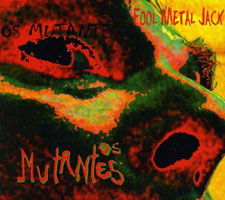 Bereits
das zweite Studioalbum der legendÃĪren brasilianischen Band nach dem
Live-Comeback von 2007. Sicherlich ein
blÃķdes Wortspiel im Titel und gewÃķhnungsbedÞrftiges Cover,
aber mit toller Musik, irgendwo zwischen Progrock, Hardrock und brasilianischer
Leichtigkeit. Erstmalig (bis auf eine Ausnahme, dem Gilberto Gil-Cover
"Eu Descobri") wird auf Englisch gesungen, was mir aber vÃķllig
egal ist. Sergio Dias ist ein wahrer Meister an der Gitarre, der
es hier auf intelligente Art und Weise krachen lÃĪsst. Bereits
das zweite Studioalbum der legendÃĪren brasilianischen Band nach dem
Live-Comeback von 2007. Sicherlich ein
blÃķdes Wortspiel im Titel und gewÃķhnungsbedÞrftiges Cover,
aber mit toller Musik, irgendwo zwischen Progrock, Hardrock und brasilianischer
Leichtigkeit. Erstmalig (bis auf eine Ausnahme, dem Gilberto Gil-Cover
"Eu Descobri") wird auf Englisch gesungen, was mir aber vÃķllig
egal ist. Sergio Dias ist ein wahrer Meister an der Gitarre, der
es hier auf intelligente Art und Weise krachen lÃĪsst.
Leider ist aber nicht ganz klar, wem dieser Album gefallen wird bzw. gefallen
soll: traditionelle Bossa-Fans werden durch heftige Gitarrenattacken und
vielleicht auch durch die englischen Texte verschreckt. Den aufrechten
Hardrockfans ist das aber wohl insgesamt nicht krachig genug. Da bleiben
nur die Progrockfans. Und ich.
(09.06.2013) |
| Domenico: "Cine Prive" (Plug Research, Nov. 2012) |
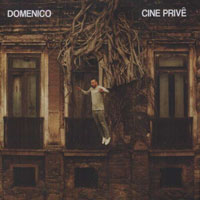 Ein schweres 1o-Zoll-Doppelalbum des brasilianischen
Trommlers Domenico Lancelloti, Partner von Moreno
Veloso und Alexandre Kassin im Trio "+2".
Ein schweres 1o-Zoll-Doppelalbum des brasilianischen
Trommlers Domenico Lancelloti, Partner von Moreno
Veloso und Alexandre Kassin im Trio "+2".
(08.02.2015)

 Mehr ...
Mehr ...
ïŧŋ
Der Sohn der Samba-Legende Ivor Lancelotti mit einem faszinierenden Solo- Album zwischen Indie, Pop, Soundtrack und Latin. Produziert von Mario Caldato Jr. (Beastie Boys, Jack Johnson, Beck)
The words "cine privÊ" conjure up late-night skin flicks for Brazilians, but the more appropriate meaning of the album title is closer to its literal translation: private cinema. Domenico writes and co-writes all the songs, sings, plays guitar and designs the rhythmically adventurous soundscapes heard on Cine PrivÊ. Built on consistently intriguing rhythms and sonic textures, Cine PrivÊ is reminiscent of the meditative yet swinging quality of Joao Donato's mid-seventies albums (Quem à Quem & Lugar Comum) as filtered through the indie aesthetic of Yo La Tengo, Pavement or Stereolab, sans the in-your-face avant-garde-isms. True to his intentions, many of Domenico's songs come across like soundtracks to lost films, for instance: the falling-in-love montage in an Italian rom-com starring Roberto Benigni ("Su Di Te") or the Spaghetti Western set in the Brazilian Northeast.
|
| Caetano Veloso: "Abraçaço" (Universal, 2012 * Feb. 2013) |
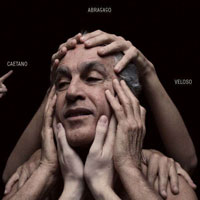 Der Meister der brasilianischen Musik hat es mit Þber 70 Lenzen nicht
mehr nÃķtig, Erwartungen der Kundschaft zu erfÞllen (hatte er
das je?). Auf "Abraçaço" wird richtig gerockt,
zwar nicht mit fetten GitarrenwÃĪnden wie bei Hardrockern, sondern
eher mit frickeligen Sachen wie bei Indie-Rockern. Verantwortlich dafÞr
ist die junge (?) brasilianische Rockband Bandacê. Meist
hÃķrt man nur, fast schon spartanisch, die 4 Instrumente der Beiteiligten
(E-Gitarre, Bass, Schlagzeug und gelegentliche Keyboards der drei "Jungspunde"
und Caetanos Akustikgitarre). Selten klingt's nach gewohntem Bossa Nova.
(Und trotzdem?) Sehr gut. Produziert von seinem Sohn Moreno.
Der Meister der brasilianischen Musik hat es mit Þber 70 Lenzen nicht
mehr nÃķtig, Erwartungen der Kundschaft zu erfÞllen (hatte er
das je?). Auf "Abraçaço" wird richtig gerockt,
zwar nicht mit fetten GitarrenwÃĪnden wie bei Hardrockern, sondern
eher mit frickeligen Sachen wie bei Indie-Rockern. Verantwortlich dafÞr
ist die junge (?) brasilianische Rockband Bandacê. Meist
hÃķrt man nur, fast schon spartanisch, die 4 Instrumente der Beiteiligten
(E-Gitarre, Bass, Schlagzeug und gelegentliche Keyboards der drei "Jungspunde"
und Caetanos Akustikgitarre). Selten klingt's nach gewohntem Bossa Nova.
(Und trotzdem?) Sehr gut. Produziert von seinem Sohn Moreno.
(16.04.2013)

 Mehr ...
Mehr ...
Schon auf zwei vorangegangenen Alben hat Brasiliens Singer-Songwriter- Legende, zur Überraschung aller Puristen, hervorragend mit der jungen Rockgruppe BandaCe harmoniert. Auf Abracaco setzen die vier Musiker jetzt ihre mal nostalgisch-melodische, mal Indie-rockige Mischung aus Samba, Bossa Nova, Funk und Rock fort. Gleich in der ersten Nummer mit dem doppeldeutigen Titel A Bossa Nova e foda (was sowohl für Die Bossa Nova ist Scheiße als auch Die Bossa Nova ist spitze stehen kann) stellt Caetano klar, dass brasilianische Musik nicht immer sanft und relaxed sein muss. In dem Song vergleicht er Bossa-Erfinder Joao Gilberto kühn mit brasilianischen Martial-Arts-Kämpfern. Ich möchte nicht das Klischee bedienen, dass die Bossa Nova immer etwas Süßes und Weiches ist, verrät Caetano. Zum Beweis seiner These höre man Abracaco, staune und genieße Velosos neue intelligent-sperrige Brasil-Perlen!
|
| Céu: "Caravana Sereia Bloom" (Six Degrees/Urban Jungle, Apr. 2012) |


 Mehr ...
Mehr ...
Caetano Veloso sah in ihr die "Zukunft der brasilianischen Musik", und auch hierzulande liegen ihr Kritiker und Publikum nach den Alben "CÃĐu" und "Vagarosa" zu FÞÃen. Nun krÃķnt die SÃĪngerin aus SÃĢo Paulo ihr bisheriges Schaffen mit "Caravana Sereia Bloom". Als Thema hat sich CÃĐu die Mythologie des Reisens auserkoren, inspiriert durch mehrere Trips in den wilden Nordosten Brasiliens. Ihre 13 Kompositionen knÞpfen direkt an der gewagten Klangwelt der Tropikalisten an und ziehen zugleich den Hut vor den Low-Fi-Sound-Rebellen des Nordostens wie NaçÃĢo Zumbi, Otto oder DJ Dolores. "Caravana Sereia Bloom" ist eine Sammlung von Kurzgeschichten, die sich um einen fahrenden Zirkus ranken: TrÃķsterin eines traurigen Clowns, Schutzengel einer einsamen alten Dame, SÃĪngerin in einer Karaokebar - CÃĐu schlÞpft hier in viele Rollen. Stilistisch gibt sich das Werk wild wie das Zirkusleben: Psychedelic-Rock, Cumbia, Ska, Lambada und melancholische Balladen. Das bislang aufregendste und gewagteste Album der Brasilianerin.
Caravana Sereia Bloom, the third album in seven years from Brazilian singer and songwriter Maria do CÃĐu Whitaker Poças (aka CÃĐu), sounds dramatically different than the breezy, electronically washed 21st century bossa and samba of her previous offerings. Both earlier efforts were influenced by the electronic music of Thievery Corporation, Kruder & Dorfmeister, and even RÃķyksopp, as well as jazzy bossa, samba and classic MPB. Working with producer Gui Amabis, Caravana Sereia Bloom is a much more expansive recording. Born from ideas incurred during an extended road trip through her native country from SÃĢo Paulo to the nation's northeastern region, and the inspiration of the road movie Bye Bye Brazil, it reflects -- musically -- much of what she heard during those travels; this music also has much in common with the ambitious, experimental spirit of the tropicalia era without being self-conscious. While Caravana Sereia Bloom is easily the most stripped-down record she's cut, it is also her most contemporary. CÃĐu and Amabis employ programming and electronic sounds throughout; the emphasis here is on guitars, basses, drums, keyboards from synths to Wurlitzer, reeds, winds, and brass. No two tracks seem to come from the same root universe, but all reflect the fleeting sensations of life on the road. The funky carnivalesque jazz samba in opener "Falta de Ar" contrasts mightily with the neo-psychedelic surf guitar chicha of "Amor de Antigos." The ska-inflected cumbia of "Asfalto e Sal," with its bass drums, flutes, and hypnotic bassline, is an album highlight. "Contravento" is a rhythm collision of samba, lambada, and cumbia. It's among the most driving tracks here and colored beautifully by a multi-tracked tenor sax, B-3, percussion loops, drums, a taut bassline, and pulsing guitars. "You Won't Regret It," one of three English-language tracks here, is a cover of a vintage rocksteady tune featuring gorgeously layered vocals, trumpet, flÞgelhorn, sampled tuba, and grand rhythmic interplay. "Baile de IlusÃĢo" melds 21st century brega and cumbia in a heady, sensual mix with a lovely melodic frame. "Fffree" is an abstract, completely solo tune, on which CÃĐu plays organ, guitar, and bass and sings a brief, airy poem about the liberating quality of rootlessness. The 13 tracks on Caravana Sereia Bloom reveal an artist who is pushing the envelope of MPB, and is taking no prisoners in the process.
(by Thom Jurek, All Music Guide)
|
| Kassin: "Sonhando Devagar" (CD: Coqueiro Verde, 2011 * Vinyl: 20|20|20, Nov. 2013) |
 Der Bassist und Produzent Alexandre Kassin war mir bereits als
Partner von Moreno Veloso in der Band "+2"
bekannt. Sein SolodebÞt verbindet auf grandiose Weise Indierock,
Funk und Brasilien. Die VerÃķffentlichung auf Vinyl stammt Þbrigenz
vom Label von Damon & Naomi!
Der Bassist und Produzent Alexandre Kassin war mir bereits als
Partner von Moreno Veloso in der Band "+2"
bekannt. Sein SolodebÞt verbindet auf grandiose Weise Indierock,
Funk und Brasilien. Die VerÃķffentlichung auf Vinyl stammt Þbrigenz
vom Label von Damon & Naomi!
(04.01.2015)

 Mehr ...
Mehr ...
In his native Brazil, Kassin is a sought-after producer (Bebel Gilberto), bass player (Caetano Veloso), and musical director (Orchestra Imperial, a new-twist samba band that plays for audiences of up to 40,000). But outside Brazil, he is best known as one of that mysterious trio known as +2 who released three albums on Luaka Bop, each identified by a different leader: Moreno (Veloso, Caetanos son) +2, Domenico (Lancellotti) +2, and the last of the series, released in 2008 (Alexandre) Kassin +2. The +2s toured the world, collaborated with royalty of the indie rock world like John McEntire (Tortoise) and Sean OHagan (High Llamas), and called it a day after completing their high-concept trilogy.
Kassins first songwriting project since the +2s, and his first proper solo release, is likewise a concept album: a set of songs about dreams. This is no routine mishmash of oneiric whimsy, however; Kassins unconscious turns out to be both lucid and precise. He dreams (and therefore sings) about eating zebra (Natural World) and bananas (Potassium); about losing cell phone signal (Out of Service) and his heart (When You Are Dancing Samba); about sex in a handicapped bathroom (Gym Pants), and the similarities between ice cream and bodily fluids (Absorb You). It is a journey as deadpan as it is surprising. And you can dance to the whole thing.
Previously available only in Brazil, Sonhando Devagar [Dreaming Slowly] is now released for the first time anywhere on LP (download code also included), in a gorgeous 3-D gatefold sleeve. 3-D glasses included to help you read the fantastic lyrics in both Portuguese and English.
|
| Marcos Valle: "Estatica" (Far Out, Sept. 2010) |
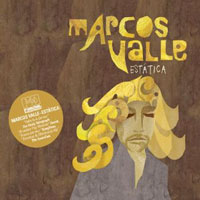 "Estatica" gab's letztens als Vinylausgabe fÞr relativ
wenig Geld beim Online-HÃĪndler meines Vertrauens und hÃĪlt mindestens
den Standard von "Escape", ist vielleicht
sogar noch besser. Witzig sind besonders drei Keyboard-InstrumentalstÞcke,
die "1975", "1985" und "1995" heissen und
offensichtlich den typischen (Keyboard-)Sound des jeweiligen Jahrzehnts
einfangen sollen. Alle drei sind gelungen, aber am besten gefÃĪllt
mir als altem Sack natÞrlich "1975". Mit dabei als Gast
an der Gitarre ist Marcelo Camelo von Los Hermanos,
von denen man leider schon lange nichts mehr vernommen hat.
"Estatica" gab's letztens als Vinylausgabe fÞr relativ
wenig Geld beim Online-HÃĪndler meines Vertrauens und hÃĪlt mindestens
den Standard von "Escape", ist vielleicht
sogar noch besser. Witzig sind besonders drei Keyboard-InstrumentalstÞcke,
die "1975", "1985" und "1995" heissen und
offensichtlich den typischen (Keyboard-)Sound des jeweiligen Jahrzehnts
einfangen sollen. Alle drei sind gelungen, aber am besten gefÃĪllt
mir als altem Sack natÞrlich "1975". Mit dabei als Gast
an der Gitarre ist Marcelo Camelo von Los Hermanos,
von denen man leider schon lange nichts mehr vernommen hat.
(03.02.2013)

 Mehr ...
Mehr ...
The early-2000s renaissance of Marcos Valle was a delight for his fans, especially those who had long held onto hopes that they'd hear more to rival his late-'60s and early-'70s prime. Curiously quiet after a 2005 live album, though, it seemed that Valle had gone back into hibernation. He returned with a bang, however, on 2010's Estática, which is nearly everything his fans had been looking for. The songwriting is bright and memorable, the production style unifies the best of his sunny late-'60s style and his innovative early-'70s prime, and Valle's strong personality is at the center of it all. (The latter is especially welcome, since he'd seemed relatively detached on some of his 2000s records.) The opening "Vamos Sambar" simply sparkles, its summery samba groove energized with soft strings and brass -- even finding time for a brief, irresistibly melancholy bridge. Second track "Prefixo" is mostly an instrumental, though it features Valle's deep nasal speaking voice. "Papo de Maluco" is a male/female duet, conjuring visions of his duet classics like "Crickets Sing for Anamaria" and "Batucada." "Novo Acorde" even has the analog synthesizers that Valle used to great effect on records like Garra and Previsão do Tempo. With songwriting, performance, and production all coming at such a peak this late in his career, it becomes clear that Estática is not only a delightful record, and not just a record that finds him sounding more natural than he has in years -- it's the first masterpiece of Valle's comeback years.
(by John Bush, All Music Guide)
|
| Os Mutantes: "Haih ... Or Amortecedor" (Anti, Nov. 2009) |
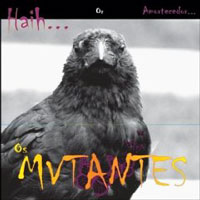
Zwar gibt es vom Londoner Reunionkonzert 2006
eine wunderbare DVD inklusive Audio-CD,
aber eine WIRKLICH NEUES Mutantes-Album mit NEUEN LIEDERN ist
dann doch sehr Þberraschend - und eine groÃe Freude! Mehr dazu demnÃĪchst ...
(08.12.2009)
Von der Besetzung des Livealbums von 2006
sind fast alle Musiker noch an Bord - es fehlen lediglich der Keyboarder
Arnaldo Baptista, GrÞndungsmitglied und Bruder von Gitarrist
Sergio Dias, sowie die SÃĪngerin Zelia Duncan, Nachfolgerin
der ursprÞnglichen SÃĪngerin Rita Lee. Als neue LeadsÃĪngerin
ist Bia Mendes dabei. Die meisten Lieder hat Sergio Dias
zusammen mit dem legendÃĪren brasilianischen Singer/Songwriter Tom
Zé geschrieben, zwei Titel stammen von niemand geringerem
als Jorge Ben, dazu kommen mehrere StÞcke
von Vitor Trida, dem Multiinstrumentalisten der Band (Gitarre,
Keyboards, FlÃķte, Klarinette, Geige und Cello!). Insgesamt ist
das eine opulente, spannende und sehr lebendige Platte von einer Band,
der man es nicht anhÃķren kann, dass es sie (mit Unterbrechungen)
nun schon ungefÃĪhr 40 Jahre gibt - zumindest Sergio Dias
und Trommler Dinho Leme sind schon so lange dabei. Unbedingt
selber anhÃķren!
(21.12.2009)

 Mehr ...
Mehr ...
Das Comeback des Jahres: Das erste Album der Kult-Brasilianer seit 1974!!
Selbst der größte Fan von Os Mutantes hätte nicht damit gerechnet, dass eine improvisierte Wiedervereinigung 2006 zu einem neuen Album der Brazil-Superstars führen würde - zur ersten neuen Musik der Os Mutantes seit 1974! "Haih Or Amortecedor" wurde vom OM-Gründer Sérgio Dias mit den brasilianischen Legenden Tom Zé und Jorge Ben konzipiert. Letzterer schrieb übrigens den großen Hit der Band, "Minha Menina", der 2008 in einer McDonald's-Werbung wieder auftauchte. Doch "Haih Or Amortecedor" ist weder Nostalgie, noch Remake der 60er-Jahre, in denen Os Mutantes den Psychedelic-Rock von Brasilien aus erfanden. Nein, das Album steht sowohl für Kontinuität wie für ein radikales Update dieser Legende: vom 50s-Dreampop von "Anagrama" bis zum sexy Samba von "O Careca", von einer Grußadresse Wladimir Putins an die russische Armee bis hin zur Saga Saddam Husseins im Gewand eines Pariser Nachtclub-Blues. Man ahnt, warum viele Musikergrößen (u.a. Devendra Banhart, Beck) die Band so sehr verehren; Kurt Cobain bat 1993 sogar schriftlich um eine Reunion. Sein Wunsch geht jetzt in Erfüllung.
(amazon)
|
| Céu: "Vagarosa" (Six Degrees/Urban Jungle, Okt. 2009) |
 Das
zweite Album dieser fantastischen brasilianischen SÃĪngerin knÞpft
nahtlos an das titellose DebÞt von 2006
an: mit Bossa-, Jazz und Rock-Gitarren, ComputerklÃĪngen, alten Analog-Keyboards
(VIEL MELLOTRON!!!) und vor allem ihrem wunderbaren Gesang. Man kann das
Þbrigenz auch geniessen, wenn man kein Wort Portugiesisch versteht! Das
zweite Album dieser fantastischen brasilianischen SÃĪngerin knÞpft
nahtlos an das titellose DebÞt von 2006
an: mit Bossa-, Jazz und Rock-Gitarren, ComputerklÃĪngen, alten Analog-Keyboards
(VIEL MELLOTRON!!!) und vor allem ihrem wunderbaren Gesang. Man kann das
Þbrigenz auch geniessen, wenn man kein Wort Portugiesisch versteht!
(06.11.2009)

 Mehr ...
Mehr ...
Mit bekannten Mitteln etwas Neues schaffen das Wunderkind aus São Paulo machts möglich. Doch Céus Größe liegt nicht in dem Umstand begründet, dass sie Samba mit Reggae, Lounge und einem Schuss Tropicalismo verbindet, sondern wie sie dies macht: konzentriert, stilsicher und mit unbekümmerter Lust am Experiment. Dabei klingt die 29-jährige Tochter eines brasilianischen Komponisten auch auf dem Nachfolger ihres gefeierten Debüts stets wie sie selbst unvergleichlich und vertraut zugleich. Mit Vagarosa legt die musikalische Kosmopolitin ein weiteres Werk voll ansprechender Melodien vor.
(Wolfgang Zwack, STEREO)
Vagarosa, das zweite Album der sensationellen Vokal-Stilistin aus São Paolo, ist eine Enttäuschung Ž könnten jene fälschlicherweise sagen, die darauf hofften, die geniale Brasilianerin würde sich vielleicht mehr den Traditionen von Samba &, Bossa & Co. zuwenden. Oder die andere Fraktion, die eventuell mehr elektronifizierte Moderne erwartete. Doch Maria Do Céu Whitaker Poįas entzieht sich all diesen Erwartungen und pflegt stattdessen ihre kosmopolitische Stilvielfalt. Und auch ihr zweites Album bestätigt all jene Qualitäten, die AUDIO schon ihr etwas gefälligeres Debüt zur Pop-CD des Monats (siehe 8/2007) küren ließ. Ein wenig Geduld braucht es zwar schon, doch dann entfaltet Vagarosa (was gemächlich, langsam oder auch lässig bedeutet) eine immense stilistische Farbenpracht und belohnt die Annäherung durch reichhaltige, stets fein abgestufte Soundvariationen. Und weil derart Žtolle, inspirierte und Žanimierende Musik nach wie vor eher rar ist, dürfte die 29-jährige Paulista bei Musikgourmets mit weitem Horizont bald mehr sein als nur ein gut gehüteter Geheimtipp. Céu kreuzt virtuos Sambaspuren und Popmelodik, streut Electronica-Streusel und Dub-Riddims ein (wie in Cordao Da Insonia, der Hymne auf die kreative Schlaflosigkeit), garniert das trippig treibende Nascente mit schlängelnden Vocals und grandiosen Jazz-Bläsern und umgarnt Rosa Menina Rosa mit Retro-Orgelsounds und Psychedelic-Ambiente. Somnambulo wiederum spielt mit einen Hauch von Tango mit TripŽHop und Scratches und alles zusammen beweist: Céu ist eine Ausnahmekünstlerin und rechtfertigt den Debüt-Lorbeer mit ihrer zweiten Platte vollauf.
Fazit: Céu bleibt die weitsichtige, stilsichere Hohepriesterin des Brasil-Pop
(Claus Böhm, AUDIO 11/2009, Album des Monats)
|
| Bebel Gilberto: "All In One" (Verve, Sept. 2009) |
 Irgendwie kommt mir das Cover vom neuen Album der Tochter von Joao
Gilberto bekannt vor ... Genau, es erinnert irgendwie an "Beach
Samba" von Joaos Ex-Frau Astrud Gilberto. Keine
Ahnung, was ich davon halten soll.
Irgendwie kommt mir das Cover vom neuen Album der Tochter von Joao
Gilberto bekannt vor ... Genau, es erinnert irgendwie an "Beach
Samba" von Joaos Ex-Frau Astrud Gilberto. Keine
Ahnung, was ich davon halten soll.
(19.11.2009) |
| Luciana Souza: "Tide" (Verve, April 2009) |
 Soundtechnisch,
qualitativ und stilistisch weicht das neue Album von Luciana Souza
nicht vom VorgÃĪnger "The New Bossa Nova"
von 2007 ab. Allerdings verzichtet sie inzwischen weitestgehend auf Fremdmaterial
bekannter Autoren und hat die Songs fast alle mit Ehemann, Produzent und
Bassist Larry Klein geschrieben. Eine kleine, feine CD. Soundtechnisch,
qualitativ und stilistisch weicht das neue Album von Luciana Souza
nicht vom VorgÃĪnger "The New Bossa Nova"
von 2007 ab. Allerdings verzichtet sie inzwischen weitestgehend auf Fremdmaterial
bekannter Autoren und hat die Songs fast alle mit Ehemann, Produzent und
Bassist Larry Klein geschrieben. Eine kleine, feine CD.
(19.11.2009) |
| Joyce with Nana Vasconcelos & Mauricio Maestro: "Visions Of Dawn" (Far Out, 2009) |

|
| Milton Nascimento & Jobim Trio: "Novas Bossas" (EMI, Juni 2008) |
 Ein weiteres Album, das den 50. Geburtstag von der Bossa Nova feiert:
wer kann das besser als Milton Nascimento, zusammen
mit dem Jobim Trio, das aus dem Sohn (Gitarrist Paulo
Jobim) und dem Enkel (Pianist Daniel Jobim)
von Antonio Carlos Jobim, sowie Schlagzeuglegende
Paulo Braga besteht? Akustische Bossa Nova mit starken
Jazzakzenten auf allerhÃķchstem Niveau und mit den allerbesten Songs.
Wenig Þberraschend stammen 8 von 14 Liedern vom Meister Antonio
Carlos Jobim, aber es sind eher unbekannte und unverbrauchte Sachen,
vielleicht mit der Ausnahme von "Chega De Sausade", dem ersten
Bossa-"Hit" von Joao Gilberto von 1958. Dazu
kommen weitere gute Lieder von Nascimento (u. a. vom legendÃĪren Album
"Clube Da Esquina" von 1972)
Ein weiteres Album, das den 50. Geburtstag von der Bossa Nova feiert:
wer kann das besser als Milton Nascimento, zusammen
mit dem Jobim Trio, das aus dem Sohn (Gitarrist Paulo
Jobim) und dem Enkel (Pianist Daniel Jobim)
von Antonio Carlos Jobim, sowie Schlagzeuglegende
Paulo Braga besteht? Akustische Bossa Nova mit starken
Jazzakzenten auf allerhÃķchstem Niveau und mit den allerbesten Songs.
Wenig Þberraschend stammen 8 von 14 Liedern vom Meister Antonio
Carlos Jobim, aber es sind eher unbekannte und unverbrauchte Sachen,
vielleicht mit der Ausnahme von "Chega De Sausade", dem ersten
Bossa-"Hit" von Joao Gilberto von 1958. Dazu
kommen weitere gute Lieder von Nascimento (u. a. vom legendÃĪren Album
"Clube Da Esquina" von 1972)
(04.11.2008)

 Mehr ...
Mehr ...
| A.C. Jobim wünschte sich einst, dass Milton Nascimento seinen kompletten Songkatalog aufnimmt. Er hielt ihn für den einzigen Vokalisten, der seine Musik in der Originaltonlage meistern kann. Auf Novas Bossas wird der Traum des 1994 verstorbenen Komponisten posthum wenigstens teilweise wahr. Nascimento interpretiert hier unter anderem Trem de Ferro, Velho Riacho und Inútil Paisagem mit seinem glockenklaren, ungewöhnlich hohen Gesangstimbre.
Dabei wird der Mann, der seine Stimme bereits Stars wie Paul Simon, Duran Duran, Peter Gabriel und James Taylor lieh, sachkundig vom Jobim Trio unterstützt. Eine bessere Wahl hätte man für dieses Projekt nicht treffen können, befinden sich in den Reihen der Gruppe mit Paulo und Daniel Jobim doch der Sohn und Enkel von Antonio Carlos Jobim. An der Gitarre und am Piano treten sie das Erbe ihres berühmten Vorfahren an. Mit Paulo Braga gesellt sich ein weiterer ausgewiesener Fachmann hinzu. Der in der Zona da Mata im Herzen Brasiliens geborene Drummer gilt als Urvater des modernen brasilianischen Schlagzeugspiels und war in den vergangenen drei Dekaden mit allen Topleuten seiner Heimat im Studio. 1995 siedelte er nach New York über, dort wurde er von Joe Henderson, Yo-Yo Ma, Pat Metheny, David Sanborn und Michael Brecker engagiert.
Das Samenkorn für Novas Bossas wurde bereits im letzten Jahr gepflanzt, als man A.C. Jobims 80. Geburtstag feierte. Zu seinen Ehren traten Nascimento und das 2005 gegründete Jobim Trio gemeinsam im Botanischen Garten von Rio de Janeiro auf. Genau genommen war dieser Event freilich eine Wiedervereinigung von Künstlern, die sich schon sehr lange kennen. Paulo Jobim arbeitete 1978 zu Zeiten des Albums Clube da Esquinha 2″ erstmals mit Nascimento zusammen, auf der anschließenden Tournee war er ebenfalls mit von der Partie. Seinen Sohn Daniel nahm er damals mit. Der denkt an ein Ereignis der Konzertreise besonders gern zurück: Als ich drei Jahre alt wurde, hat mir Milton einen der Auftritte gewidmet. Die Freundschaft von Milton Nascimento und Paulo Braga reicht sogar noch weiter zurück, wie sich der Drummer erinnert: Wir waren in den 60ern Mitglieder des Berimbau Trios an der Seite von Wagner Tiso. Das Trio suchte einen Bassisten, und Milton, ein versierter Akustikgitarrist, spielte nach drei Monaten besser Bass als sein Lehrer.
Novas Bossas ist jetzt ein weiteres Kapitel in der langen gemeinsamen Geschichte der Musiker. Das Album entstand ohne jede Eile, in einer rundum freundlichen Atmosphäre. Unser Verhältnis ist so fantastisch, als hätten wir nie etwas anderes getan als zusammen zu spielen, merkt Milton dazu an. Und Daniel ergänzt lachend: Erst hatten wir überlegt, die Vorproduktion in Miltons Heimstudio zu fahren und später die Aufnahmen an einem anderen Ort fortzusetzen, aber wir hatten soviel Freiheit und Spaß in seinem Haus, dass wir es nicht über uns brachten, dort wegzugehen.
Unter Mithilfe von Gastbassist Rodrigo Villa und Co-Produzent Chico Neves nahm man unvergessene Klassiker der Bossa-Nova-Gattung neu auf, wobei sich das Repertoire erst nach und nach herauskristallisierte. Bei der Songauswahl herrschte uneingeschränkt das Lustprinzip vor. An Nachmittagen, in denen man locker musizierte und in Erinnerungen schwelgte, wurde die Trackliste allmählich ganz intuitiv gefüllt. Die Arrangements entstanden nicht minder spontan, wie Paulo Braga erläutert: Wir spielten und spielten, jedes Mal ein wenig anders, ganz ohne uns um irgendetwas zu sorgen. Das war ein sehr natürlicher Prozess.
Im Verlaufe des Prozesses wurden Titel wie Cais, Tarde und Dorival Caymmis O Vento mit Elementen aus der heutigen Jazzmusik angereichert und so auf den Sound-Stand unserer Tage gebracht. Einige Vorlagen hat man jedoch nahezu unverändert übernommen. So zeigen etwa die nahe am Original bleibenden Stücke Brigas Nunca Mais und Chega de Saudade, beide von Tom Jobim verfasst, dass es Milton Nascimento und das Jobim Trio auch ganz traditionell können. Diese Vollprofis sind wirklich mit allen Wassern gewaschen.
www.qrious.de
|
|
| |
|
| Vanessa da Mata: "Sim" (Megaphon, MÃĪrz 2008) |
 Die
SÃĪngerin Maria da Mata fiel mir zum ersten Mal auf der Bossa
Nova-Platte von Till BrÃķnner
auf. Auf ihrem eigenen Album geht es aber wesentlich moderner zur Sache
- auch nicht schlecht! Die
SÃĪngerin Maria da Mata fiel mir zum ersten Mal auf der Bossa
Nova-Platte von Till BrÃķnner
auf. Auf ihrem eigenen Album geht es aber wesentlich moderner zur Sache
- auch nicht schlecht!
(06.11.2009) |
| Luciana Souza: "The New Bossa Nova" (Verve, Juli 2007) |
 Die erste Anschaffung als Nachwirkung auf die neue Till
BrÃķnner-CD: Luciana Souza ist Brasilianerin und legt hiermit
ihr erstes englisch gesungenes Album vor. Es ist auch kein reines Bossa-Nova-Album,
sondern liegt genauso wie "Rio"
von Till BrÃķnner im Spannungsfeld von Jazz / Pop / Brasilien.
Die Lieder selber sind meist nicht ganz so bekannt, stammen aber fast
alle von den besten Songschreibern der "etwas gesetzteren Generation":
Leonard Cohen, Randy Newman,
James Taylor (der sogar bei seinem "Never Die Young"
mitsingt), Brian Wilson (das gÃķttliche "God Only Knows"
von Pet Sounds!), Joni Mitchell,
Steely Dan und Sting. Nur eine Nummer von Elliot Smith
passt da generationstechnisch nicht so ganz hinein, fÃĪllt aber nicht
unangenehm auf. Insgesamt eine sehr schÃķne CD von einer groÃen SÃĪngerin,
die ich bis vor kurzem noch gar nicht kannte!
Die erste Anschaffung als Nachwirkung auf die neue Till
BrÃķnner-CD: Luciana Souza ist Brasilianerin und legt hiermit
ihr erstes englisch gesungenes Album vor. Es ist auch kein reines Bossa-Nova-Album,
sondern liegt genauso wie "Rio"
von Till BrÃķnner im Spannungsfeld von Jazz / Pop / Brasilien.
Die Lieder selber sind meist nicht ganz so bekannt, stammen aber fast
alle von den besten Songschreibern der "etwas gesetzteren Generation":
Leonard Cohen, Randy Newman,
James Taylor (der sogar bei seinem "Never Die Young"
mitsingt), Brian Wilson (das gÃķttliche "God Only Knows"
von Pet Sounds!), Joni Mitchell,
Steely Dan und Sting. Nur eine Nummer von Elliot Smith
passt da generationstechnisch nicht so ganz hinein, fÃĪllt aber nicht
unangenehm auf. Insgesamt eine sehr schÃķne CD von einer groÃen SÃĪngerin,
die ich bis vor kurzem noch gar nicht kannte!
(03.10.2008) |
| Os Mutantes: "Mutantes Live: Barbican Theatre, London, 2006" (Luaka Bop, Juli 2007) |
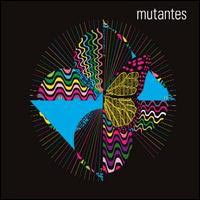 Brasiliens beste Rockband kehrte nach Þber 30 Jahren auf die BÞhne
zurÞck und spielte im Londoner Konzertsaal "Barbican Theatre"
ein grandioses Konzert, das hier auf CD und DVD vorliegt. Ich habe in
den letzten Jahren kaum eine Konzert-DVD gesehen, die mich ÃĪhnlich
begeistert hat. Þbrigenz eine sehr gÞnstige Zufallsentdeckung
aus der Grabbelkiste im 2nd-Hand-Shop. Da strahlt der Schatzsucher in
mir.
Brasiliens beste Rockband kehrte nach Þber 30 Jahren auf die BÞhne
zurÞck und spielte im Londoner Konzertsaal "Barbican Theatre"
ein grandioses Konzert, das hier auf CD und DVD vorliegt. Ich habe in
den letzten Jahren kaum eine Konzert-DVD gesehen, die mich ÃĪhnlich
begeistert hat. Þbrigenz eine sehr gÞnstige Zufallsentdeckung
aus der Grabbelkiste im 2nd-Hand-Shop. Da strahlt der Schatzsucher in
mir.
(27.09.2008)

 Mehr ...
Mehr ...
|
In 1993, Kurt Cobain made a valiant and formal attempt to get Brazil's Os Mutantes to reunite. He failed. Om Platten reissued the band's recordings officially in the United States and they sold like hotcakes globally, fostering all kinds of interest in the most psychedelic of the tropicalia lot but not a peep from the band. In 1998, Beck popped out his sideways tribute to the band with Mutations, employing all kinds of vocal, instrumental. and production techniques employed by the band that had moved him so deeply. Still nothing. Leave it to David Byrne (who had issued a wonderful compilation of their work on his Luaka Bop imprint) to encourage the original Os Mutantes brothers, Sergio Dias and Arnaldo Baptista, who assembled a band that included the amazing chanteuse Zélia Duncan (who replaced original female vocalist Rita Lee), along with drummer Dinho Leme, Henrique Peters, Vitor Trida, Fábio Recco, and Esméria Bulgari, to perform in London at the storied Barbican Theater in 2006. This document is the entire concert, presented in stunning sound with crackling energy to prove that those who attended, press and punters, weren't lying about how great it was. These 21 songs offer proof positive that years can indeed melt away, and whatever dowdy and dodgy myths that surrounded the fate its creators had endured were wiped away within the first few minutes of set opener "Don Quixote."
Os Mutantes didn't merely run though their hits, they played them with fire, humor, astonishing finesse, and creativity, revealing the sincere dearth of the same that exists on the rock scene (indie or not) at this moment in time. Dias is a better guitarist than he's ever been. His playing has lost none of its quirky yet utterly sophisticated charm. And in the intricate vocal harmonies on display in tracks like "Tecnicolor," "Ave Lucifer," "I Feel a Little Spaced Out," "Virginia," "Cantor de Mambo," and "A Mainha Menina," may have indeed influenced those soaring moments in Queen's middle period material. But it isn't just the influence that Os Mutantes have had upon so many acts, it's their stunning musical sophistication in performance. They are the true intersection where samba, psychedelic rock, doo wop, folk songs, classical music, and guerilla theater meet. Along with Gilberto Gil and Caetano Veloso, Gal Costa, and others, they created a musical and artistic environment so powerful it threatened a government. This is music one has to hear to believe, let alone comprehend. It moves the listener out past any preconceived notions that the Mutantes were able to do what they did in a recording studio but could never pull off live. The show, as divided by the two discs, has a thread running through it that moves the audience from one place to another to another and another until they are so utterly seduced and overwhelmed they are exhausted. A lot is being made of the guest performances of Noah Georgeson and Devendra Banhart on "Bat Macumba," but they don't add all that much, and that's not to take away from their contributions, either. It's simply that they aren't capable of adding much to this kaleidoscopic array of wild fun and musical genius. "Bat Macumba" rocks like a mother, but it's that cooking band that makes it all happen. The addition of Duncan a recording artist in her own right for Universal is a coup. Her range and ability to shift her focus from lead to harmony, to change tempo, key, and mode on a dime makes her a boon for this group. Her own foremost moments on "Tecnicolor," "Caminhante Noturno," and "2001," where samba meets calypso meets acid-damaged rock and sci-fi doo wop are mindblowers. Forget what you know or what you don't. If you've not listened to Os Mutantes before, this is a great place to start: you can hear the studio records, amazing as they are, later. If you own the studio records, they will not adequately prepare you for what's on display here.
(by Thom Jurek, All Music Guide)
|
|
| Kassin+2: "Futurismo" (Luaka Bop, 2007) |
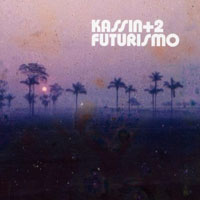 Als
dritter Teil der "+2"-Trilogie hier nun die Platte des Bassisten,
Gitarristen und Produzenten Alexandre Kassin, unterstÞtzt
natÞrlich von seinen Partnern Moreno Veloso
und Domenico Lancelotti, sowie zahlreichen weiteren
Musikern. Am Ende der CD gibt es noch drei zusÃĪtzliche (?) Lieder,
die zusammen mit John McEntire von Tortoise
und Sean O'Hagen von den High
Llamas aufgenommen wurden. Das sind natÞrlich erstklassige Referenzen
und kÃķnnen durch das Ergebnis klar bestÃĪtigt werden. Als
dritter Teil der "+2"-Trilogie hier nun die Platte des Bassisten,
Gitarristen und Produzenten Alexandre Kassin, unterstÞtzt
natÞrlich von seinen Partnern Moreno Veloso
und Domenico Lancelotti, sowie zahlreichen weiteren
Musikern. Am Ende der CD gibt es noch drei zusÃĪtzliche (?) Lieder,
die zusammen mit John McEntire von Tortoise
und Sean O'Hagen von den High
Llamas aufgenommen wurden. Das sind natÞrlich erstklassige Referenzen
und kÃķnnen durch das Ergebnis klar bestÃĪtigt werden.
(22.02.2015) |
| "CÃĐu" (Six Degree/Urban Jungle, 2006) |
 Diese junge Dame liefert uns eine wunderbare Mischung aus Samba, Reggae,
Bossa und Pop. Akustische KlÃĪnge vereint mit Computerbeats, dazu klasse
BlÃĪsersÃĪtze. Bob Marleys "Concrete Jungle" wird Þberzeugend
gecovert.
Diese junge Dame liefert uns eine wunderbare Mischung aus Samba, Reggae,
Bossa und Pop. Akustische KlÃĪnge vereint mit Computerbeats, dazu klasse
BlÃĪsersÃĪtze. Bob Marleys "Concrete Jungle" wird Þberzeugend
gecovert.
(13.02.2009)

 Mehr ...
Mehr ...
Caetano Veloso sieht in CéU die Zukunft der populären brasilianischen Musik, für uns ist CéU das beste Album, das dieses Jahr aus Lateinamerika kommt. Der Perfektion näher klang noch keine Vermischung von Klassik und Moderne im Bereich der Latin-Musik. Trip & Hip Hop, klassischen Samba, Reggae, Soul und Blues lässt die schöne Brasilianerin gleich in Fülle in ihren fortschrittlichen Sound einfliessen, was in zurückhaltend coolen Songs resultiert, die ihrer fantastischen Stimme genügend Raum zur Entfaltung lassen und ein immenses Talent offenbaren.
(exitmusic.ch)
|
| Cibelle: "The Shine of Dried Electric Leaves" (Crammed Discs/Ziriguiboom, 2006) |
 Endlich habe ich auch Cibelles zweites Album zu Hause. Es macht beim ersten
HÃķren einen ziemlich komplexen Eindruck und ich werde wohl noch einen
Moment brauchen, um hier was TiefschÞrfendes zu sagen. Ach ja - Devendra
Banhart ist tatsÃĪchlich dabei und singt zusammen mit Cibelle sehr
schÃķn "London, London", einen Klassiker von Caetano
Veloso.
Endlich habe ich auch Cibelles zweites Album zu Hause. Es macht beim ersten
HÃķren einen ziemlich komplexen Eindruck und ich werde wohl noch einen
Moment brauchen, um hier was TiefschÞrfendes zu sagen. Ach ja - Devendra
Banhart ist tatsÃĪchlich dabei und singt zusammen mit Cibelle sehr
schÃķn "London, London", einen Klassiker von Caetano
Veloso.
(24.02.2009)

 Mehr ...
Mehr ...
Cibelle vereint auf unverwechselbare Art und Weise verschiedenste Stile zu ihrer einzigartigen, einfallsreichen und bezaubernden Musik. Keine falsche Bescheidenheit: Ihr zweites Album ist ein geniales Meisterwerk! Es kombiniert akustische Instrumentierung mit Elektronik, laute Gitarren und Kinderspielzeug, fesselnde Klangwelten und pure Melodien, getragen von ihrer unverkennbaren, ergreifenden Stimme.
Jeder Song auf The Shine of Dried Electric Leaves ist ein Erlebnis â als ob man eine Geschichte hÃķrt und gleichzeitig eine unbekannte Landschaft voller Ãberraschungen durchstreift. Cibelles Texte und musikalische Ideen entspringen ihren Emotionen: Sie sagt, sie mÃķchte ihr Leben als ein Labor nutzen und dabei sowohl der Hamster als auch der Wissenschaftler sein...
Cibelle hat dieses Album Þber einen Zeitraum von 18 Monaten produziert. Auf ihren Reisen zwischen ihrem momentanen Wohnort London und ihrer Heimatstadt SÃĢo Paulo haben sie einige ihrer neuen Songs begleitet und sind wÃĪhrend dieser Zeit von verschiedenen Co-Produzenten und Performern bereichert worden â darunter Mike Lindsay (Mitglied des britischen Folkotronica-Acts Tunng), Apollo Nove (innovativer Produzent und KÞnstler aus SÃĢo Paulo, der einen GroÃteil ihres DebÞtalbums produziert hat), Yann Arnaud aus Paris (Air, Sebastien Schuller), und GÃĪste wie Seu Jorge (bekannt aus den Filmen âCity Of Godâ und âThe Life Aquaticâ), Devendra Banhart und Spleen
Seit Ende der 90er Jahre verknÞpft die brasilianische SÃĪngerin Cibelle die Bossa Nova mit der Moderne. Ihr neues Album, entstanden halb in London, halb in Sao Paulo, dokumentiert diesen Spagat zwischen den Kulturen mit flÞssigen Gitarrenzaubereien, unkonventionell gespielten Keyboards oder GerÃĪuschen.
(C. Hammer in Audio 6 / 06)
For anyone fond of Cibelle's 2003 self-titled debut, a pleasant album of Brazilian downtempo typical of Six Degrees (a trendy worldbeat label based in San Fransisco with a Lonely Planet-like following), The Shine of Dried Electric Leaves is likely to generate a sense of surprise. It's a bold move in an indistinct direction, away from the broadly appealing samba-lite downbeat of her self-titled debut album and toward abstract soundscapes and poetics. It's a consciously artistic direction, for sure, and while her music is just as graceful as before, with her absolutely beautiful vocals in the forefront at all times, it's a more difficult approach to grasp, one that reveals itself steadily with each successive listen. After all, Cibelle had been an immediately appealing album, comprised of feel-good music that was difficult to dislike, much like Bebel Gilberto's beloved Tanto Tempo. On the other hand, The Shine of Dried Electric Leaves bares a resemblance to highly crafted, lulling, and ultimately enchanting â if a bit odd â recent critical favorites like BjÃķrk's Vespertine and Devendra Banhart's Cripple Crow (the latter artist is featured here on a duet performance of Caetano Veloso's "London London"). Half the album is sung in fluent English, and the songs build and swell with each passing minute rather than play out in a straightforward verse-chorus-verse fashion. The music is fascinating if you can appreciate the conception of such an album, one that credits three different producers (Apollo Nove, Mike Lindsay, Yann Arnaud) who each live in different countries and, for the most part, co-produce each track. Cibelle's ambition will be lost on some listeners, undoubtedly, especially those looking for some agreeably laid-back Brazilian beats tailor-made for globetrotting. Yet the artistry so evident on The Shine of Dried Electric Leaves should be a delightful surprise to those who enjoy their music heady as well as luscious, and with a literate, worldly edge.
(by Jason Birchmeier, All Music Guide)
|
| Los Hermanos: "Quatro" (Sony, Juli 2005) |
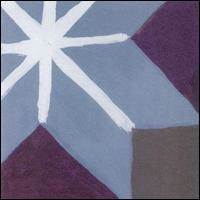 "Los Hermanos", spanisch fÞr "Die BrÞder", ist eine
echte GitarrenROCKband. In ihrer Heimat Brasilien sind sie
eine groÃe Nummer, wÃĪhrend sie bei uns vÃķllig unbekannt sind. Entdeckt
habe ich sie kÞrzlich, weil einer der beiden SÃĪnger/Gitarristen, Rodrigo
Amarante, zusammen mit Fabrizio Moretti von den Strokes
gerade unter dem Namen Little Joy
eine hÞbsche kleine Folkplatte herausgebracht hat.
"Los Hermanos", spanisch fÞr "Die BrÞder", ist eine
echte GitarrenROCKband. In ihrer Heimat Brasilien sind sie
eine groÃe Nummer, wÃĪhrend sie bei uns vÃķllig unbekannt sind. Entdeckt
habe ich sie kÞrzlich, weil einer der beiden SÃĪnger/Gitarristen, Rodrigo
Amarante, zusammen mit Fabrizio Moretti von den Strokes
gerade unter dem Namen Little Joy
eine hÞbsche kleine Folkplatte herausgebracht hat.
(13.02.2009)

 Mehr ...
Mehr ...
In their impressive and ambitious quest to completely reinvent their sound for each new album, los Hermanos this time around opted for a soft, low-key, jazzy, and slightly Djavan-inspired sound. And as expected, this soothing, mellow reincarnation of the group didn't please a large part of their fan base. Not that the music is bad. On the contrary, the album contains several very fine moments. But as a whole, it is so different to los Hermanos' earlier efforts that many listeners simply became disappointed. While the stylistic difference between "Quatro" and the group's three earlier albums is striking, there is much less difference between the individual songs on this album. They all have the same sleepy atmosphere and the calm and tasteful arrangements in common. "Dois Barcos," "Sapato Novo," and "Primeiro Andar" stand out for their complex and beautiful melodies. "Paquetá" has a bossa nova sound to it and "O Vento" catches attention with its light, floating guitar rhythm. The soft, almost lethargic singing of Marcelo Camelo on most of the tracks also strongly contributes to the special atmosphere of the album.
(by Philip Jandovský, All Music Guide)
|
| "Soul Of Brazil" (EMI, Juni 2004) |

"Funk, Soul & Bossa Grooves 65-77" heiÃt es im Untertitel
dieser Billigpreis-Kompilation (< 10€). Aber warum taucht ein
solcher Sampler auf dieser Seite auf?
- das schÃķne Cover machte mich im Laden aufmerksam
- Bossa Nova beschÃĪftigt mich schon seit einiger Zeit, allerdings
stammt der Grossteil der mir bekannten Musik aus der Zeit vor 1965
(Antonio Carlos Jobim etc.)
- hier wird "europÃĪisch" und "US-amerkanisch"
beeinflusste brasilianische Popmusik vorgestellt (sprich: die Auswirkungen
von den Beatles und James Brown)
- bis auf wenige Ausnahmen (Marcos Valle, Lo
Borges) sind mir die versammelten KÞnstler vÃķllig unbekannt,
bzw. habe sie noch nie (bewusst) gehÃķrt
- die Originalalben sind gar nicht oder nur schwer erhÃĪltlich
- alles passt wunderbar zusammen. Ein idealer Ausgangspunkt fÞr
den Neueinsteiger in brasilianische Musik der spÃĪten 60er/frÞhen
70er, abseits der bekannten "Samba"- und "Worldmusic"-Klisches
(17.09.2004)

 Mehr ...
Mehr ...
|
"Mit Samba ... hat das Album nichts zu tun. Auf diesem Sampler sind
nur Künstler, die sich an "westlicher" Musik der 60er und
70er wie Funk und Soul orientiert haben. Trotzdem sind alle Texte auf
portugiesisch, und auch klangtechnisch orientiert sich das Album doch
mehr in die südamerikanische Richtung. Doch gerade das Zusammentreffen
dieser unterschiedlichen Kulturen macht den Reiz dieses Albums aus. Gerade
wer sich für die Schnittmenge von Funk und Soul mit anderen Musikrichtungen
wie zum Beispiel Latin Soul interessiert, sollte unbedingt zugreifen.
Auch die übliche Kinderkrankheit vieler Sampler, dass sie nicht durchgängig
hörbar sind, ist hier sehr gut vermieden worden, richtig schlechte
Lieder gibt es meiner Meinung nicht.
Ich empfehle trotzdem, die hier angebotenen Samples durchzuhören.
Wem es dann gefällt, wird auch beim Kauf keine böse Überraschung
erleben, zumal der Preis echt human ist." (Kundenrezension bei amazon)
|
|
| Celso Fonseca: "Natural" (Zinguiboom, Juni 2004) |
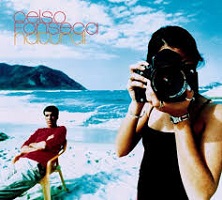 Dieser SÃĪnger und Gitarristen war mir zwar schon mal als Begleiter von
Bebel Gilberto, Gilberto Gil und
Milton Nascimento untergekommen, aber ich habe ihn erst kÞrzlich
als SolokÞnstler fÞr mich entdeckt. "Natural" ist wohl seine erste VerÃķffentlichung
fÞr den internationalen Markt und zeichnet sich durch eine sehr gelungene Verbindung
von Alt (Bossa Nova) und Neu (Elektronik) aus. Normalerweise schreckt mich der Hinweis
"Programming" in der Besetzungsliste einer Platte ab. Hier wird das Computerschlagzeug
aber sehr organisch mit dem traditionellen Bossa-Nova-Instrumentarium (Akustikgitarre,
Kontrabass, QuerflÃķte, Perkussion) zusammengefÞhrt. Perfekt.
Dieser SÃĪnger und Gitarristen war mir zwar schon mal als Begleiter von
Bebel Gilberto, Gilberto Gil und
Milton Nascimento untergekommen, aber ich habe ihn erst kÞrzlich
als SolokÞnstler fÞr mich entdeckt. "Natural" ist wohl seine erste VerÃķffentlichung
fÞr den internationalen Markt und zeichnet sich durch eine sehr gelungene Verbindung
von Alt (Bossa Nova) und Neu (Elektronik) aus. Normalerweise schreckt mich der Hinweis
"Programming" in der Besetzungsliste einer Platte ab. Hier wird das Computerschlagzeug
aber sehr organisch mit dem traditionellen Bossa-Nova-Instrumentarium (Akustikgitarre,
Kontrabass, QuerflÃķte, Perkussion) zusammengefÞhrt. Perfekt.
(15.08.2017)

 Mehr ...
Mehr ...
ïŧŋ
Celso Fonseca is a unique singer and brilliant songwriter who bears the torch of the classic bossa/samba Brazilian sound. He has collaborated with such luminaries as Gilberto Gil, Caetano Veloso, Marisa Monte and Bebel Gilberto.
Celso Fonseca's Natural is a great listening experience - smooth, sensual, pure, warm, caressing, and seductive. An integral part of Rio's up and coming generation of singers and songwriters, Celso has recorded, produced and performed with some of Brazil's brightest stars.
After a successful career in Brazil reaching back two decades, Celso (pronounced "SELL-so") Fonseca is finally making his solo debut in the United States. Fonseca has produced, written for, arranged, or played on albums by such stars as Baden Powell and Gilberto Gil, as well as younger artists like Bebel Gilberto and Virginia Rodrigues. Natural, however, makes it abundantly clear that he is just as adept in the lead role as singer and star. Here he chooses to create modern but elegant bossa novas that sound hip but, unlike Bebel Gilbertoâs electronic music-oriented Tanto Tempo, are mostly done using traditional acoustic instruments. With an emphasis on voice (he sounds like a young Caetano Veloso) and acoustic guitar, Fonseca has a strong collection of nine originals rounded out with Jobim and Powell covers. Aptly proving how skilled Fonseca is with his art, "The Night We Called It A Day" and "Slow Motion Bossa Nova" are rare examples of English language bossa novas that gracefully capture the musicâs essence.
Tad Hendrickson
|
| Domenico+2: "Sincerly Hot" (Luaka Bop, 2004) |
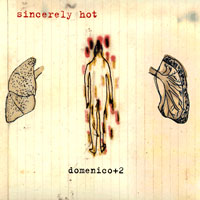 Nach Moreno+2 ist Domenico+2 die zweite
Zusammenarbeit von Moreno Veloso, Alexandre
Kassin und Domenico Lancelotti, diesesmal
unter der FederfÞhrung vom Schlagzeuger und SÃĪnger ...
Nach Moreno+2 ist Domenico+2 die zweite
Zusammenarbeit von Moreno Veloso, Alexandre
Kassin und Domenico Lancelotti, diesesmal
unter der FederfÞhrung vom Schlagzeuger und SÃĪnger ...
(22.02.2015)

 Mehr ...
Mehr ...
ïŧŋ
Their burgeoning individual careers, to date, have included many years of touring experience with some of the founding fathers of Brazilian Bossa Nova and Tropicalia and collaborations with such diverse musicians as Beastie Boy producer Mario Caldato, Brazilian noise-guru Arto Lindsay, and Trattoria artist Takako Minekawa.
Most recently, they have embarked together on the project of a musical trilogy: three albums by the threesome, each created under the leadership of a different member, and allowing his particular vision to come to the forefront. With each incarnation, we see the triumvirate through a different lens. As Domenico explains: âWe had the idea to make a trilogy with music. Each member of the band will stand in the center and make his own album, in this way, we can change the focus every shot we make.â
2001 saw the release of Music Typewriter, the exquisitely crafted, lyrical debut of the plus twos. The album, accompanied by an extended tour of the US, Canada, Europe, and Japan, was highly praised by critics. âHalf of this debut is mentholated bossa nova; half is sexy carnival music for the digital era. All of it is gorgeous.â
(Entertainment Weekly; February 23, 2001)
Three years on, the band has undertaken a change in musical direction (and name), shifting focus to the drummer, electronic percussionist, composer, and "sound-scapist" Domenico Lancelotti. Sincerely Hot infectiously combines samba, bossa nova, tropicalia, MPB (MÚsica Popular Brasileira), rock and electronica together in a raw, rough mix that still hangs on to its sweet Brazilian roots. It may be, in Moreno's words, "clearly a drummer's album," but its reconstitution of the diverse elements present on Music Typewriter - increasing the emphasis on groove and sonic experimentalism, without sacrificing the compositional mettle and subtlety that kindled the trio's first album - result in an invigorating, inventive, but approachable record that should appeal to ears of all stripes.
-Domenico- was born in 1972 and raised in an Italian-Brazilian family in Rio de Janeiro. The rhythms of samba are in his blood: his father is the well-known 1970s composer and singer Ivor Lancellotti. Domenico has collaborated with artists such as Quarteto Em Cy, Daniel Jobim, Caetano Veloso, Fernanda Abreu, Adriana Calcanhotto; in the '90s, around the time he first met and befriended his current compadres, he formed the experimental rock band Mulheres Que Dizem Sim (Women Who Say Yes). As well as a drummer, Domenico is also a visual artist - he created the cover art for all of the trio's releases so far, with the help of his wife Zoy.
âWhen we made Moreno Veloso+2âs Typewriter Music, we focused on the singing. And first when I thought of making mine, I wanted it to be as bossa nova trio like Milton Banana, where the drummer always leads other musicians. My album become something different from this, but the idea is till there and one can hear it on the album.â -DomenicoBorn in Bahia, Brazil's first capital and the birthplace of many Afro-Brazilian beats, -Moreno- was raised in Rio de Janeiro by perhaps the country's most respected composer and singer, Caetano Veloso, and his wife Dede. A gifted singer equally at home on guitar, cello, trumpet, and tambourine, Moreno has had the opportunity to experience firsthand the siftings and shiftings of Brazilian musics throughout his life. The constant exploration and recombination of styles which is evident throughout Caetano's career is also very present in that of Moreno, whose tendency is to bridge the experimental and the traditional, as with both his mid-90's band Gold Nyte Warszawa and the current group.
The group's third member and the producer of Sincerely Hot, -Kassin- is what we call a pure Carioca. From the beginning, Kassin has always been fond of the experimental, bizarre side of music. His older brother, a DJ, encouraged his catholic tastes early on, inspiring him to purchase his first album â a Kraftwerk record â at the age of 8. In 1996 he released his first album with his Tex- Mex/ska fusion band Acabou La Tequila. A well-known producer as well as a bassist, Kassin has collaborated with and produced many artists including Lenine, Marisa Monte, Bebel Gilberto, Arto Lindsay, Caetano Veloso and Jorge Mautner.
âI have never cared about where music is from. I think it is very discriminative to categorize any music to a certain frame. [That] all the music except from U.S.A and Europe would be always categorized as world music â I feel this way of thinking is very colonial.â -Kassin
Welcome to the revolving musical door that is Moreno, Domenico, and Kassin. Stylistic trailblazers, accomplished instrumentalists, respected producers, heirs to a family heritage of Tropicalia and Samba, and the vanguard of a new generation of Brazilian musicians - these are three consummate artists whose unique mix of traditional Brazilian songwriting with the quirky beats, loops, and noises of contemporary electronica is defining the sound of New Brazil.
(luakabop.com)
|
| "Cibelle" (Crammed Discs/Ziriguiboom, 2003) |
 Diese reizende und Þberaus talentierte junge Dame aus Sao Paulo/Brasilien
habe ich gerade erst bei YouTube entdeckt. Irgendwo zwischen Bossa
Nova, Jazz und Dancefloor. Selten habe ich eine moderne Produktion mit
Computerbeats und Soundeffekten gehÃķrt, die mir dermaÃen gut gefÃĪllt.
Woran das wohl liegt?
Diese reizende und Þberaus talentierte junge Dame aus Sao Paulo/Brasilien
habe ich gerade erst bei YouTube entdeckt. Irgendwo zwischen Bossa
Nova, Jazz und Dancefloor. Selten habe ich eine moderne Produktion mit
Computerbeats und Soundeffekten gehÃķrt, die mir dermaÃen gut gefÃĪllt.
Woran das wohl liegt?
Es gibt inzwischen auch ein neues Album, das sie in ihrer neuen Wahlheimat
London aufgenommen hat, auf dem angeblich Devandra Banhart, meine
Lieblinxziege, mitmeckert. Das werde ich mir sicherlich demnÃĪchst auch
anhÃķren ...
(12.01.2009)
Das "neue" Album ist gekommen, stammt aber auch schon von
2006 und wird hier von mir gelobt!
(24.02.2009)

 Mehr ...
Mehr ...
Dass aus Brasilien nicht nur Samba und FuÃball kommt, sondern auch gute und unverschÃĪmt charmante Pop-Musik, beweist die SÃĪngerin CIBELLE auf ihrem fantastischen DebÞtalbum.
Erstmalig in Erscheinung getreten ist das ehemalige Fotomodell auf dem mittlerweile schon klassischen Album von SUBA 'Sao Paulo Confessions', dessen Songs sie mit ihrer unverwechselbaren Stimme veredelte. Auf ihrem DebÞtalbum tritt sie nun auch als Songwriterin und Ko-Produzentin auf und zeigt eindrucksvoll, dass sich ihr Talent nicht nur auf das Singen beschrÃĪnkt. Mit UnterstÞtzung durch APOLLO 9 (Brasiliens angesagtestem jungen Produzenten) und den Soundarchitekten CHRIS HARRISON und PETE NORRIS (die u.a. fÞr den MORCHEEBA Sound sorgen) hat CIBELLE ein Album geschaffen, das funkelnde, moderne Songs enthÃĪlt, die Anleihen nehmen bei Downbeat und Latin, bleiben aber immer POP und tragen den ganz speziellen CIBELLE-Stempel. Trotz aller InternationalitÃĪt zeigen die Songs CIBELLE's sehr persÃķnliche Welt voller Fantasie und Emotionen und laden uns ein, ihr zu folgen. Wer das tut, wird es ganz sicher nicht bereuen. Ein neuer Stern am Pop-Himmel ist aufgegangen. Tracklisting: Deixa, SÃģ Sei Viver No Samba, Hate, Luisas, Waiting, No Preggo, I'll Be, Train, Inutil Paisagem, Um SÃģ Segundo, Pequenos Olhos.
Die Brasilianerin Cibelle singt wie ein Ex-Model klingen muss, nÃĪmlich cool-laziv, und passt damit genauso gut zur zeitgemÃĪÃen Electro Bossa wie einst Astrud Gilberto zur Original Bossa Nova. Auf ihrem DebÞtalbum wirkt sie mit ihrem Gesangsstil wie eine ProjektionsflÃĪche fÞr die verspielten Arrangementideen von Produzent Apollo 9.
(H.-J. Lenhart in Jazzthetik 6 / 03)
|
| Moreno + 2: "Music Typewriter" (Luaka Bop, Feb. 2001) |
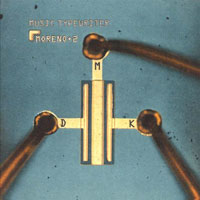 Ein Bandprojekt von SÃĪnger und Multiinstrumentalist Moreno Veloso,
Bassist Alexandre Kassin und Schlagzeuger Domenico
Lancelloti , das auf ganz vorzÞgliche Weise in Hinblick auf Musikstil
und Technik das moderne mit dem alten Brasilien zusammenbringt. Beats
und Tropicalia schliessen sich nicht gegenseitig aus. Im Mittelpunkt stehen
aber immer Stimme und (meist) die Akustikgitarre von Moreno Veloso. Als
GÃĪste u.a. dabei: Papa Caetano Veloso, Daniel
Jobim und der Jazzpianist Joao Donato.
Ein Bandprojekt von SÃĪnger und Multiinstrumentalist Moreno Veloso,
Bassist Alexandre Kassin und Schlagzeuger Domenico
Lancelloti , das auf ganz vorzÞgliche Weise in Hinblick auf Musikstil
und Technik das moderne mit dem alten Brasilien zusammenbringt. Beats
und Tropicalia schliessen sich nicht gegenseitig aus. Im Mittelpunkt stehen
aber immer Stimme und (meist) die Akustikgitarre von Moreno Veloso. Als
GÃĪste u.a. dabei: Papa Caetano Veloso, Daniel
Jobim und der Jazzpianist Joao Donato.
(09.05.2013)

 Mehr ...
Mehr ...
When you're the son of Caetano Veloso, one of Brazil's most beloved singer/songwriters and men of letters, you have to face a lot of expectations when you release your debut record. But Moreno Veloso is no clone; while he's inherited the wry iconoclasm of his father, he stamps himself all over this record, letting his personal musical idiosyncrasies flourish, like the theremin and sound processing that buzz like flies over his cover of the Brazilian classic "Das Partes." While the majority of the songs come from Veloso's pen, like fellow new generation artist (and musical scion) Bebel Gilberto he's not afraid to pay homage to the inspirational samba and bossa nova that's an integral part of his country's musical heritage, even venturing as far as North America for a take on "I'm Wishing" from the movie Snow White, which pitches English and Portuguese vocals against each other in a luminously simple performance. His own material can range from the rhythmic and funky "Arrivederci" to the understated, relaxed "Nenhuma," where he reaches into a falsetto range of a voice that's admittedly limited. The experimental tendencies are just enough to give an interesting quirk factor, without overwhelming his natural melodicism. While this album won't start another Tropicaliá movement, the way his father's mix of Brazilian and rock did in the late '60s, it establishes him as one of the brighter new lights in the MPB (Brazilian popular music) scene.
(by Chris Nickson, All Music Guide)
|
| Marcos Valle: "Escape" (Far Out, 2001) |
 Diese CD hatte ich mir bereits bei ihrer VerÃķffentlichung gekauft,
ohne damals schon vom Brasilien-Virus befallen zu sein. Zu hÃķren
gibt es anspruchsvolle, moderne brasilianische Popmusik mit EinflÞssen
von (natÞrlich) Samba und Bossa Nova, aber auch Jazz (Valle ist ein
ausgezeichneter Pianist!), Rock und sogar Dancefloor (so weit ich das
als Disco- und Tekno-Hasser als solchen Þberhaupt identifizieren
kann!). Erstaunlicherweise (?) passt alles gut zusammen.
Diese CD hatte ich mir bereits bei ihrer VerÃķffentlichung gekauft,
ohne damals schon vom Brasilien-Virus befallen zu sein. Zu hÃķren
gibt es anspruchsvolle, moderne brasilianische Popmusik mit EinflÞssen
von (natÞrlich) Samba und Bossa Nova, aber auch Jazz (Valle ist ein
ausgezeichneter Pianist!), Rock und sogar Dancefloor (so weit ich das
als Disco- und Tekno-Hasser als solchen Þberhaupt identifizieren
kann!). Erstaunlicherweise (?) passt alles gut zusammen.
(03.02.2013) |
| Caetano Veloso: "Noites Do Norte" (Universal/Emarcy, April 2001) |
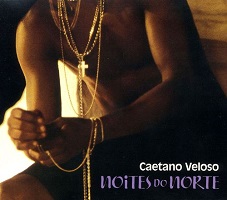 Ein richtig gutes und sehr abwechslungsreiches Album des Meisters, mit Bossa Nova-,
Rock-, Folk- und sogar gelegentlichen Hip-Hopp-Elementen, dazu groÃem Orchester, das mir bisher
entgangen ist und das ich kÞrzlich in der Grabbeliste
gefunden habe, wenn auch nur als CD. Wahrscheinlich gibt es auch gar keine Vinylversion,
wenn man mal auf das Erscheinungsdatum kurz nach der Jahrtausendwende achtet.
Ein richtig gutes und sehr abwechslungsreiches Album des Meisters, mit Bossa Nova-,
Rock-, Folk- und sogar gelegentlichen Hip-Hopp-Elementen, dazu groÃem Orchester, das mir bisher
entgangen ist und das ich kÞrzlich in der Grabbeliste
gefunden habe, wenn auch nur als CD. Wahrscheinlich gibt es auch gar keine Vinylversion,
wenn man mal auf das Erscheinungsdatum kurz nach der Jahrtausendwende achtet.
(20.07.2018)

 Mehr ...
Mehr ...
ïŧŋ
Veloso continues to show his pre-eminence as a singer and songwriter with Noites Do Norte. He may be almost 60, but he's far from set in his ways, still chipping away at lyrical and musical boundaries. But where he looked outward many years ago, getting inspiration from the rock music of Britain and America, these days he looks inside, at Brazil, making songs like his version of Jorge Ben's "Zumbi" a cinematic journey across Brazil. The title track delves back into history, its words taken directly from the writing of 19th century abolitionist Joaquim Nabuco. Inevitably, samba and bossa nova remain the musical touchstones, but they're also the jumping-off point for experimentation, such as the hip-hop drumming (up front in the mix) on the opener, "Zera a Reza," or "13 De Maio," where son Moreno Veloso offers his own idiosyncratic approach to the playing and engineering. "Ia" uses electric guitar and drums to make a swirling soundscape that's almost modern psychedelia behind Veloso's instantly recognizable voice. Never content to tread ground he's already covered, Veloso continues to go off the map.
(by Chris Nickson, All Music Guide)
Nearly 35 years after the advent of tropicalia, the Brazilian movement that fused native music and visuals with Anglo/psychedelic flavors, singer-songwriter Caetano Veloso continues his deep, playful experimentation. Noites do Norte ("Northern Nights") is a striking art-pop fusion whose intellectualism is often bound up with the beauty of its layered tones. Concerns from the country's national identity and ongoing racial crises--a theme that fed Veloso's 2000 soundtrack to Orfeu, an update of the Black Orpheus story--to early memories, broken hearts, and the artist's adoration of filmmaker Michelangelo Antonioni swim through a colorful aural canvas. But for all of Veloso's trademark verbal surprises (for one, the Antonioni tribute is sung in Italian), it's easy to believe his claim that initially "I did not think about the songs. I went to the studio looking for sounds." Whether juxtaposing a Milesian trumpet with lush reeds and strings ("Sou Seu SabiÃĄ"), deploying screeching rock guitar ("Rock 'n' Raul," "Ia") and machine noises ("Cantiga de Boi") in the midst of acoustic sound, or contrasting a troupe of drummers with baroque strings over the discrete movements of the three-minute title track, Veloso fills the disc with so much music that it seems to suspend or expand the listener's sense of time: a rare trick from a rare trickster.
(by Rickey Wright, amazon.com )
|
| Bebel Gilberto: "Tanto Tempo" (Crammed Discs/Zinguiboom, 2000) |
 Mit "Tanto Tempo" hat die Tochter von Joao
Gilberto (aber nicht aus dessen Ehe mit Astrud
Gilberto) vor wenigen Jahren einen Klassiker geschaffen, der mit seiner
ZusammenfÞhrung von "klassischem" Bossa Nova und zeitgenÃķssischer
Elektronik sicherlich ein Vorbild fÞr andere KÞnstlerinnen wie Cibelle
und CÃĐu war.
Mit "Tanto Tempo" hat die Tochter von Joao
Gilberto (aber nicht aus dessen Ehe mit Astrud
Gilberto) vor wenigen Jahren einen Klassiker geschaffen, der mit seiner
ZusammenfÞhrung von "klassischem" Bossa Nova und zeitgenÃķssischer
Elektronik sicherlich ein Vorbild fÞr andere KÞnstlerinnen wie Cibelle
und CÃĐu war.
(09.04.2009)

 Mehr ...
Mehr ...
Den Ausschlag für den Ruhm der Joao-Tochter gab wohl die Tatsache, dass sie für dieses Album den traditionellen Bossa-und Brasil-Chanson Sound mit einigen Beiträgen moderner Club-und Electronica Produzenten aufpeppte. Startschuss zu einer, Kreise ziehenden, Neuorientierung des Genres. Amon Tobin und Thievery Corporation, Smoke City und auch Produzent Suba sorgten für diesen Mix, der sich aber auch auf Klassiker wie Chico Barque oder Gilberto Gil zurück lehnt. Jetzt ist das Album von 2000 selbst ein Klassiker.
(Glitterhouse)
|
| Quarteto Jobim - Morelenbaum (EmArcy, Juni 1999) |
 Eine
wunderbare neue Bossa Nova-Produktion aus Brasilien mit Songmaterial,
das weitestgehend vom groÃen Meister Antonio Carlos Jobim
geschrieben und von seinem Sohn Paulo (Gesang/Gitarre) und seinem
Enkel Daniel (Piano) und dem Ehepaar (?) Paula (Gesang)
und Jaques Morelenbaum (Cello) mit der Rhythmusgruppe Marcelo
Costa (Schlagzeug) und Zeca Assumpcao (Kontrabass) umgesetzt
wurde. Eine
wunderbare neue Bossa Nova-Produktion aus Brasilien mit Songmaterial,
das weitestgehend vom groÃen Meister Antonio Carlos Jobim
geschrieben und von seinem Sohn Paulo (Gesang/Gitarre) und seinem
Enkel Daniel (Piano) und dem Ehepaar (?) Paula (Gesang)
und Jaques Morelenbaum (Cello) mit der Rhythmusgruppe Marcelo
Costa (Schlagzeug) und Zeca Assumpcao (Kontrabass) umgesetzt
wurde. |
| Vinicius Cantuária: "Tucuma" (Verve, 1999) |
 Diese CD steht schon ziemlich lange bei mir im Plattenschrank und war
schon lange nicht mehr im CD Player, aber neulich fiel mir der Name des
brasilianischen SÃĪngers, Songschreibers und Multiinstrumentalisten
(hauptsÃĪchlich an Gitarre und diversen Perkussionsinstrumenten) wieder
auf, weil er als Schlagzeuger in der Besetzungsliste von Marcos Valles
72er-Klassikers "Vento Sul" auftaucht.
Aufgenommen in New York mit ein paar interessanten GÃĪsten (u.a. Bill
Frisell, Laurie Anderson, Sean Lennon und Nana Vasconcelos)
entstand ein sehr modernes Album, das aber trotzdem klar in der Tradition
von Antonio Carlos Jobim steht.
Diese CD steht schon ziemlich lange bei mir im Plattenschrank und war
schon lange nicht mehr im CD Player, aber neulich fiel mir der Name des
brasilianischen SÃĪngers, Songschreibers und Multiinstrumentalisten
(hauptsÃĪchlich an Gitarre und diversen Perkussionsinstrumenten) wieder
auf, weil er als Schlagzeuger in der Besetzungsliste von Marcos Valles
72er-Klassikers "Vento Sul" auftaucht.
Aufgenommen in New York mit ein paar interessanten GÃĪsten (u.a. Bill
Frisell, Laurie Anderson, Sean Lennon und Nana Vasconcelos)
entstand ein sehr modernes Album, das aber trotzdem klar in der Tradition
von Antonio Carlos Jobim steht.
(09.03.2013)

 Mehr ...
Mehr ...
If it is true that the best and most lasting innovations draw much of their deep strength from the past, then Vinicius Cantuaria may have a lock on the future of Brazilian music. Here the Brazilian singer/songwriter/instrumentalist conjures up a fascinating record, deeply rooted in the bossa nova yet infused with a cool, studied Generation X sensibility, a willingness to explore new combinations of sound, and the ability to lose itself in strange places. Many of these songs are incantations where the European and contemporary spices are applied ever so subtly -- a string quartet darkly colors the title track, Erik Friedlander's cello adds warm undercurrents, Cantuaria's electronic samples delicately add mysterious shadows. Yet at the same time, the bossa nova rhythm is almost always there swinging away, gently driving the music underneath Cantuaria's warm Portuguese vocals. More importantly, these songs tap deeply into the Brazilian sense of saudade (roughly translated, yearning) to a remarkable degree. Cantuaria receives totally simpatico Anglo help from Bill Frisell, who adds pearl-like electric guitar to "Amor Brasileiro"; Peter Apfelbaum, whose subtle and pithy tenor sax enhances "Maravilhar"; and Sean Lennon, whose unobtrusive electric bass underpins three numbers. The most striking track, "Retirante," definitively ties Brazil and the American avant-garde together as Cantuaria alternates his Portuguese vocals with Laurie Anderson's characteristic arch speech-song and quietly shattering violins. Tucuma may well be the breakthrough that the hype claims it is.
(by Richard S. Ginell, All Music Guide)
|
| Caetano Veloso: "Livro" (Mercury, 1997) |
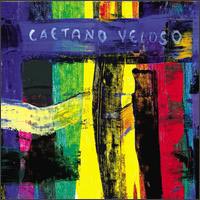

 Mehr ...
Mehr ...
Caetano Veloso continues his free-thinking explorations of tropicalismo on this ambitiously arranged, elaborately packaged suite of songs devoted to whatever happens to cross his mind. Veloso says that he was listening a lot to the collaborations of Miles Davis and Gil Evans around this time, and Jaques Morelenbaum's charts often reflect their darkly urbane ethos. Yet for Morelenbaum's yin there is also the yang of the battering Bahian percussion that dominates many of the rhythm tracks. "Livros" in Portuguese means "books," so Veloso gives you a sample of his book Verdade Tropical in the booklet notes and pays eloquent tribute to them on the title track: "Books are transcendental things/But we can love them with our hands." He is alternately awestruck and appalled by the ambiguities of New York City on "Manhata"; here, the arrangement definitely contains haunting echoes of Evans. He can venture into atonality on "Doideca" (12-tone, but pointedly translated in the booklet as "loony"), recite the horrors of a slave ship voyage, tell someone off ("Nao Enche," which means "Piss Off"), or simply sing "How beautiful could a being be" over and over, presumably to a child, in falsetto to a hot groove. One of the most amazing songs is an epic about the life of Alexander the Great; it comes off like a great saga song. Finally, he runs down a long list of all his favorite Brazilian singers, seemingly leaving out no one, only to close with "Better than this there's only silence/And better than silence, only Joao." Can't add anything to that, except don't miss this CD if you love Brazilian music.
(by Richard S. Ginell, All Music Guide)
|
| Milton Nascimento: "Nascimento" (Warner, 1997) |
 Gleich fÞnf Nascimento-Alben aus der jÞngeren Zeit 1994 bis
2002 bei den Warner-BrÞdern gibt es zurzeit fÞr wenig Geld im
Papp-Schuber zu erwerben, von denen ich hier beispielhaft das dritte Album
vorstellen mÃķchte: "Nascimento" wurde vom legendÃĪren
Warner-Hausproduzenten Russ Titelman in Szene gesetzt und hat diese
wunderbare Mischung von Jazz und Brasilien, die Milton immer wieder gerne
bringt.
Gleich fÞnf Nascimento-Alben aus der jÞngeren Zeit 1994 bis
2002 bei den Warner-BrÞdern gibt es zurzeit fÞr wenig Geld im
Papp-Schuber zu erwerben, von denen ich hier beispielhaft das dritte Album
vorstellen mÃķchte: "Nascimento" wurde vom legendÃĪren
Warner-Hausproduzenten Russ Titelman in Szene gesetzt und hat diese
wunderbare Mischung von Jazz und Brasilien, die Milton immer wieder gerne
bringt.
Nur demjenigen ist vom Kauf abzuraten, der Wert legt auf schÃķne Ausstattung
mit Informationen auf dem Cover in einer lesbaren SchriftgrÃķÃe.
Aber alle anderen ...
(21.04.2013)

 Mehr ...
Mehr ...
Nascimento is Milton Nascimento's most deeply Brazilian-sounding album in a long time, and also the most downcast, but none the worse in its emotional impact. He adopts the battering, heavy percussion rhythms of the folia boxes (popularized by Olodum) on several tracks, which frame the main portion of the album and give it enormous vitality. There isn't a bumper crop of new songs here (only half of the 12 tracks), but what there is represents the most interesting material he has recorded in some time, including the beautiful "Rouxinol" with its haunting accordion, flute and a gently hypnotic rhythm, and the arresting "Louva-A-Deus," pitting Nascimento's voice against the huge drums. Particularly affecting is Léo Masliah's "Guardanapos de Papel," sung in Portuguese at first and reprised in Spanish at the album's close, which has an almost despairing Nascimento singing about prophetic yet impoverished poets with tasteful piano/keyboard textures. He offers a touching vocalese on his friend Wayne Shorter's "Ana Maria" from their collaboration Native Dancer as a memorial to Shorter's late wife (lost on the TWA plane that crashed into the Atlantic in 1996), with soprano saxophonist Nivaldo Ornelas offering a different take on Shorter's lead. Just about everyone seems to take on "Ol' Man River" sooner or later, but Nascimento does it as a vocalese with large choir -- and it works. So far, this CD represents his best work of the '90s and even a good part of the '80s, a genuine renaissance for the Brazilian icon.
(by Richard S. Ginell, All Music Guide)
|
| Milton Nascimento: "Txai" (Columbia, 1990) |
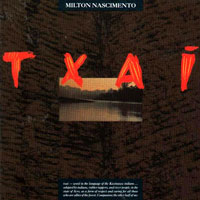 KÞrzlich fÞr relativ wenig Geld in der Grabbelkiste gefunden!
Ein schÃķnes Album, auf dem Milton seine eigenen Lieder abwechselnd
mit GesÃĪngen der Amazonas-Ureinwohner prÃĪsentiert.
KÞrzlich fÞr relativ wenig Geld in der Grabbelkiste gefunden!
Ein schÃķnes Album, auf dem Milton seine eigenen Lieder abwechselnd
mit GesÃĪngen der Amazonas-Ureinwohner prÃĪsentiert.
(12.11.2012)

 Mehr ...
Mehr ...
"Txai" is described as a term of respect for those who are allies of the forest -- and such is the focus of this concept album, the end result of a fact-finding voyage through part of the northern Brazilian watershed. Utilizing forces ranging from a simple dialogue between Milton Nascimento's baritone and percussion to a large orchestra and chorus (often arranged by Wagner Tiso), Nascimento shares his thoughts about the rivers and nature, ultimately warning us not to let the forces of capitalism destroy the Amazon rain forest (reinforced by a spoken passage written and narrated by actor River Phoenix). The songs are separated by wild-sounding interludes of folk music from the peoples of the region, and there is a fascinating vocal/percussion arrangement of Heitor Villa-Lobos' "Nozani Na." As much as one applauds the sentiments and sincerity of Nascimento -- and as much as one wants to enjoy this record -- one is still forced to admit that despite the unity of conception, Nascimento's own material isn't as strong as it could have been. But the record's ambition and the continued allure of Nascimento's voice will commend it to the dedicated fan.
(by Richard S. Ginell, All Music Guide)
|
| Antonio Carlos Jobim: "Passarim" (Verve, 1987) |
 Ein schÃķnes SpÃĪtwerk des Meisters.
Ein schÃķnes SpÃĪtwerk des Meisters.

 Mehr ...
Mehr ...
Passarim is Jobim's major statement of the '80s, emerging during a time when Jobim's concerns were turning increasingly toward Planet Earth issues. The title song is one of Jobim's most haunting creations, a cry of pain about the the destruction of the Brazilian rainforest that resonates in the memory for hours. Also, by this time Jobim had resumed touring with a large group containing friends and family, and they carry a great deal of the load here, with lots of airy female backup vocals, two worthy songs by Jobim's multi-talented son Paulo and another by flutist/singer Danilo Caymmi. Recorded entirely in Rio, the record's overall sound is very different from Jobim's '60s and '70s work denser, hazier, still grounded in the samba yet rougher in texture (as is Jobim's voice). Though not as immediately winning as the Creed Taylor-produced albums, this music repays repeated listening particularly the extended suite from Jobim's score for the film Gabriela and there are samples of Jobim's wry humor in "Chansong" and the bossa nova reworking of "Fascinatin' Rhythm".
(by Richard S. Ginell, All Music Guide)
|
| Milton Nascimento: "Sentinela" (Ariola, 1980) |
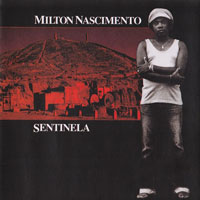 Selten habe ich ein Album mit einer solchen stilistischen Bandbreite gehÃķrt,
das gleichzeitig einen solch geschlossenen Eindruck macht. HÃķhepunkt
und in gewisserweise "Kopfkino" stellt der fast 8minÞtige
Titelsong zu Beginn der B-Seite dar. Das kann man kaum mit Worten beschreiben
...
Selten habe ich ein Album mit einer solchen stilistischen Bandbreite gehÃķrt,
das gleichzeitig einen solch geschlossenen Eindruck macht. HÃķhepunkt
und in gewisserweise "Kopfkino" stellt der fast 8minÞtige
Titelsong zu Beginn der B-Seite dar. Das kann man kaum mit Worten beschreiben
...
(12.11.2012)

 Mehr ...
Mehr ...
This is a reissue of the original 1980 release, the first for Polygram after Milton Nascimento had left EMI. The album had the fundamental support of the melodic percussion of the Minas Gerais group Uakti, along with the usual robust orchestrations. Nascimento had a hit with "Canįão da América," but several songs must be mentioned for their strong melodic qualities, like the folklore-tinged "Peixinhos do Mar," "Sueņo Con Serpientes" (with Mercedes Sosa), Villa-Lobos' "Cantiga," and "Sentinela" (with singer Nana Caymmi showcasing her strong, personal voice timbre similar to Nascimento's, which serves wonderfully to convey the idea of religious devotion).
(by Alvaro Neder, All Music Guide)
|
| Egberto Gismonti: "Sol Do Meio Dia" (ECM, 1978) |
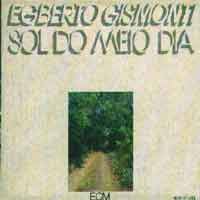 Eine
weitere feine ECM-Platte. Damals konnte man, einmal
auf den Geschmack gekommen, fast blind alles von dem Label kaufen (habe
ich natÞrlich nicht). Gismonti ist ein brasilianischer Gitarrist
und Pianist, der auf eigentÞmliche Weise Jazz, Klassik und die Musik
seiner Heimat (Bossa Nova, Indio-Musik) miteinander verbindet. Begleitet
wird er - wie (fast) immer - vom Perkussionisten Nana Vasconcelos,
gelegentlich unterstÞtzt von den Þblichen ECM-VerdÃĪchtigen
Ralph Towner, Collin Walcott und Jan Garbarek. Eine
weitere feine ECM-Platte. Damals konnte man, einmal
auf den Geschmack gekommen, fast blind alles von dem Label kaufen (habe
ich natÞrlich nicht). Gismonti ist ein brasilianischer Gitarrist
und Pianist, der auf eigentÞmliche Weise Jazz, Klassik und die Musik
seiner Heimat (Bossa Nova, Indio-Musik) miteinander verbindet. Begleitet
wird er - wie (fast) immer - vom Perkussionisten Nana Vasconcelos,
gelegentlich unterstÞtzt von den Þblichen ECM-VerdÃĪchtigen
Ralph Towner, Collin Walcott und Jan Garbarek. |
| Hermeto Pascoal: "Slaves Mass" (Warner, 1977) |
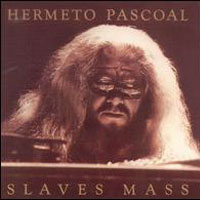 Hermeto spielt so ziemlich alle Instrumente mit Tasten (hier: Klavier,
Fender Rhodes, Hammond B-3, Hohner D6 und Melodica) oder Saiten
(hier: 6 und 12saitige Akustikgitarre) bzw. solche zum Hineinblasen (hier:
QuerflÃķte, Sopransaxofon, BlockflÃķte und natÞrlich die Melodica) und singt.
Dies ist wohl sein erstes Album in den USA und im weiteren Sinne kann
man das auch als Jazz bezeichnen. Produziert von seinen Landsleuten Flora
Purim und Airto Moreira, seinem alten Partner aus dem legendÃĪren
Quarteto Novo, der hier auch zusammen mit
Ron Carter die ausgezeichnete Rhythmusgruppe bildet.
Hermeto spielt so ziemlich alle Instrumente mit Tasten (hier: Klavier,
Fender Rhodes, Hammond B-3, Hohner D6 und Melodica) oder Saiten
(hier: 6 und 12saitige Akustikgitarre) bzw. solche zum Hineinblasen (hier:
QuerflÃķte, Sopransaxofon, BlockflÃķte und natÞrlich die Melodica) und singt.
Dies ist wohl sein erstes Album in den USA und im weiteren Sinne kann
man das auch als Jazz bezeichnen. Produziert von seinen Landsleuten Flora
Purim und Airto Moreira, seinem alten Partner aus dem legendÃĪren
Quarteto Novo, der hier auch zusammen mit
Ron Carter die ausgezeichnete Rhythmusgruppe bildet.
(14.02.2009)

 Mehr ...
Mehr ...
Not strictly a jazz album in the strict sense (it was originally issued as part of the Masters of MPB on LP in 1977), Slaves Mass has strong compositional themes among its seven tracks. The maestro Hermeto Pascoal plays everything from flutes, soprano saxophone, guitar, Fender Rhodes, acoustic piano and clavinet on this set, and enlists help from Ron Carter, Airto, Flora Purim, Raul DeSouza, David Maro and others. "Mixing Pot," is the opener and an anomaly in that it is a vanguard fusion tune where Pascoal really digs in and improvises. It also features the only appearance on this set of Alphonso Johnson on electric bass. In "Missa Dos Escravos," the title track, Pascoal's emblematic pig gives his first growls in a song dominated by Brazilian Indian references. Wonderfully and intricately composed, it centers around folk tropes. "Chorinho Para Ele" is a beautiful and modern choro with a somewhat challenging glissando bridge that really proposed new directions for the traditional genre. "Aquela Valsa" is a beautiful six/eight theme that turns into a samba with a beautiful trombone solo by DeSouza. "Cannon" is an utterly improvisational piece that meanders and winds around Pascoal's flute solo. Atonalism dominates the piano solo in "Escuta Meu Piano," which also presents bits and pieces of different styles (like baião) and folk songs. Hot samba improvisation is found in "Geléia de Cereja," that slips and slides through a variety of schema and dynamic changes without much internal focus, but it is a compelling bit of creative anarchy nonetheless in that it displays Pascoal's full range of restless musical and textural impulses as well as a beautiful soprano solo. Slaves Mass was finally issued on CD by Collectables in the United States in 2005.
(by Alvaro Neder & Thom Jurek, All Music Guide)
|
| Flora Purim: "Open Your Eyes, You Can Fly" (Milestone, 1976) |
 Eigentlich kein lupenreines Brasilien-Album, denn es wurde in den USA
mit vielen amerikanischen Spitzenmusikern aufgenommen, aber selten habe
ich Flora, Airto und Hermeto so toll
zusammen in einer Band gehÃķrt! Und dann gibt es auch noch ein Gastspiel
von Egberto Gismonti.
Eigentlich kein lupenreines Brasilien-Album, denn es wurde in den USA
mit vielen amerikanischen Spitzenmusikern aufgenommen, aber selten habe
ich Flora, Airto und Hermeto so toll
zusammen in einer Band gehÃķrt! Und dann gibt es auch noch ein Gastspiel
von Egberto Gismonti.
Als ich das Album letzte Woche als sehr gut erhaltene Originalpressung
im tollen Klappcover beim Normal-RÃĪumungsverkauf in KÃķln
in den HÃĪnden hielt, war ich noch Þberzeugt, dass ich das Album
als CD oder Kassettenkopie bereits zu Hause hÃĪtte und habe nur wegen
des guten Preises zugegriffen. Zu hause stellte ich fest, dass ich das
Album mit einem anderen verwechselt hatte und kann nun doch ein mir bisher
unbekanntes Werk vÃķllig neu geniessen. Die brasilianische SÃĪngerin
hat sich auf diesem Album mit einer absoluten Spitzenband umgeben: Gatte
Airto Moreira, Roberto Silva und "Ndugu" Chancler
an Schlagzeug und Perkussion, Hermeto Pascoal an
FlÃķte und Piano, George Duke an den Keyboards, Gitarrist David
Amaro und Bassist Alphonso Johnson. Ausserdem ist bei einigen
Titeln auch noch Ron Carter dabei.
Diese Musik vereint das beste aus Brasilien und den USA, immer mit guten
Liedern aus der Feder von Purim und Pascoal,
aber auch dreimal von Chic Corea, auf dessen Album Return
To Forever Purim und Moreira ja auch schon auf der Originalversion
von "Sometime Ago" zu hÃķren sind.
(28.02.2010)

 Mehr ...
Mehr ...
As an original member of Chick Corea's group Return to Forever, Purim subsequently drew praise as a solo act. Recording for the jazz label Milestone since 1973, Purim's sensual and strong voice was singular enough to withstand the pitfalls that hampered the work of many Latin jazz fusion artists. Open Your Eyes You Can Fly represents a commercial breakthrough, and has the artist again supplemented by adventurous players and top-notch songwriting. The best of the three Chick Corea tracks is the title song. With it's emotive and stinging guitar solo from David Amaro, it features Purim at her most accessible and charming. The remake of "Sometime Ago" has one of Corea's more accessible melodies, as Purim turns in one of her more sweet and fulfilling vocals. The melodic and soothing "San Francisco River" has the artist writing solely with frequent Corea collaborator Neville Potter on the evocative track. Despite the great work here, Open Your Eyes You Can Fly, lacks consistency. But with the great talents assembled and great voice, it's easy to overlook that fact. Hermeto Pascoal's "Andei (I Walked)" has a great synthesizer solo from George Duke and a flute solo from Pascoal. "Ina's Song (Trip to Bahia)" features Purim singing in Portuguese, starting off slow but then enlivened by her passion filled vocalizations. Produced by jazz producer Orrin Keepnews, this features the artist more lucid and joyful than some of her other work. For the reason it is recommended.
(by Jason Elias, All Music Guide)
|
| Milton Nascimento: "Geraes" (Emi/Odeon, 1976) |
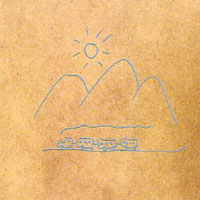 Ein
Tipp von Mauricio
Villarinho KÃķrber, dem Inhaber des wunderbaren Plattenladens
Copacabana Records in NÞrnberg, der eine schier ÞberwÃĪltigende
Auswahl an schwarzem Gold aus Brasilien anbietet. Sein Lieblinxalbum von
Milton ist natÞrlich "Clube Da Esquina",
wo ich mich voll anschlieÃen kann, aber dieses ebenfalls
vorzÞgliche, in Europa kaum bekannte Album (wenig spÃĪter nahm
er in den USA das bei uns bekanntere "Milton" auf!) habe ich
dann doch noch eingepackt. Kleines Schmankerl: das groÃe Foto im
Inneren des Covers zeigt das begeisterte Publikum bei einem Freiluftkonzert
in den HÞgeln des Bundesstaates Geraes, wo auch der jugendliche KÃķrber
unter all den brasilianischen Hippies zu erkennen ist! Eine schÃķne
Geschichte und ein tolles Album! Ein
Tipp von Mauricio
Villarinho KÃķrber, dem Inhaber des wunderbaren Plattenladens
Copacabana Records in NÞrnberg, der eine schier ÞberwÃĪltigende
Auswahl an schwarzem Gold aus Brasilien anbietet. Sein Lieblinxalbum von
Milton ist natÞrlich "Clube Da Esquina",
wo ich mich voll anschlieÃen kann, aber dieses ebenfalls
vorzÞgliche, in Europa kaum bekannte Album (wenig spÃĪter nahm
er in den USA das bei uns bekanntere "Milton" auf!) habe ich
dann doch noch eingepackt. Kleines Schmankerl: das groÃe Foto im
Inneren des Covers zeigt das begeisterte Publikum bei einem Freiluftkonzert
in den HÞgeln des Bundesstaates Geraes, wo auch der jugendliche KÃķrber
unter all den brasilianischen Hippies zu erkennen ist! Eine schÃķne
Geschichte und ein tolles Album!
(21.06.2013) |
| Jorge Ben: "Ãfrica Brasil" (Philips, 1976) |
 Das
ist eines der besten Funkalben aus den 70ern, das ich kenne. SchÃķne Rhythmusgitarren
in der Art, wie sie auch auf Tim Buckleys "Greetings
From L.A." zu hÃķren sind. Bestes Lied: "Taj Mahal"
- vielleicht, weil es das einzige ist, das ich irgendwoher schon kannte. Das
ist eines der besten Funkalben aus den 70ern, das ich kenne. SchÃķne Rhythmusgitarren
in der Art, wie sie auch auf Tim Buckleys "Greetings
From L.A." zu hÃķren sind. Bestes Lied: "Taj Mahal"
- vielleicht, weil es das einzige ist, das ich irgendwoher schon kannte.
(05.03.2009)
Platz67im Rolling Stone!
|
| Tom ZÃĐ: "Estudando O Samba" (Continental, 1975) |
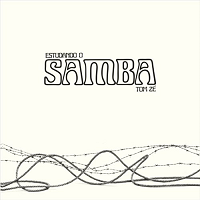 Ich hatte schon seit lÃĪngerem vor, mich in die Musik von Tom ZÃĐ hineinzuhÃķren. Den Anfang mache ich
mit diesem Klassiker aus den 70ern, kÞrzlich wiederverÃķffentlicht beom coolen Londoner Label
Mr. Bongo.
Ich hatte schon seit lÃĪngerem vor, mich in die Musik von Tom ZÃĐ hineinzuhÃķren. Den Anfang mache ich
mit diesem Klassiker aus den 70ern, kÞrzlich wiederverÃķffentlicht beom coolen Londoner Label
Mr. Bongo.
(30.03.2019)
Platz35im Rolling Stone!
|
| Elis Regina & Antonio Carlos Jobim: "Elis & Tom" (Philips, 1974) |
 Brasiliens
bester Songschreiber und beste SÃĪngerin zusammen auf einem Album. Gigantisch. Brasiliens
bester Songschreiber und beste SÃĪngerin zusammen auf einem Album. Gigantisch.
(14.02.2009)
Platz11im Rolling Stone!
|
| "Dom Um Romao" (Muse, 1974) |
 Einer
der besten Schlagwerker Brasiliens, vielleicht sogar weltweit (er spielte
nicht nur bei Sergio Mendes Brasil 66, sondern
auch bei Weather Report und auf der Sinatra/Jobim-Platte!)
mit seinem SolodebÞt (auf jeden Fall seine erste US-Platte!). Jazz
und Samba finden wunderbar zusammen. Einer
der besten Schlagwerker Brasiliens, vielleicht sogar weltweit (er spielte
nicht nur bei Sergio Mendes Brasil 66, sondern
auch bei Weather Report und auf der Sinatra/Jobim-Platte!)
mit seinem SolodebÞt (auf jeden Fall seine erste US-Platte!). Jazz
und Samba finden wunderbar zusammen.
(31.07.2016) |
| Gal Costa: "India" (Philips, 1973) |
 Zusammen mit Caetano Veloso und Gilberto Gil
war die SÃĪngerin zuvor an dem bahnbrechenden Album TropicÃĄlia - Ou Panis
Et Circensis beteiligt. ZugegebenermaÃen ist mir das Album zuerst wegen des zu Zeiten der
brasilianischen MilitÃĪrdiktatur gewagten Covers aufgefallen, aber ich mag es dann doch letztendlich
vor allem aus musikalischen GrÞnden, denn es kommt leicht folkloristisch, fast jazzig daher: auf spÃĪteren
Alben hat sich die Lady dann auch wieder mehr an normalerer Popmusik orientiert.
Zusammen mit Caetano Veloso und Gilberto Gil
war die SÃĪngerin zuvor an dem bahnbrechenden Album TropicÃĄlia - Ou Panis
Et Circensis beteiligt. ZugegebenermaÃen ist mir das Album zuerst wegen des zu Zeiten der
brasilianischen MilitÃĪrdiktatur gewagten Covers aufgefallen, aber ich mag es dann doch letztendlich
vor allem aus musikalischen GrÞnden, denn es kommt leicht folkloristisch, fast jazzig daher: auf spÃĪteren
Alben hat sich die Lady dann auch wieder mehr an normalerer Popmusik orientiert.
(10.11.2018)

 Mehr ...
Mehr ...
ïŧŋ
With Ãndia, Gal Costa completely abandoned the absurd, screaming guitars and wild drumming for some of the lushest, most sophisticated, and most complex arrangements of her career. Her voice is clear and inviting as always, sitting perfectly with the strings, accordions, horns, reeds, and percussion that swirl around, effortlessly punctuating the romance in every track. With Gilberto Gil alongside on acoustic guitar and musical director, the arrangements definitely glow with his polyphonic personality, but these songs have a feel all their own -- sounding as if they blossomed out of necessity and the sharp edge of elegance. Ãndia seems as if it were conceived with ideas walled off to past influences and future aspirations, holding a timeless quality, leaving one to wonder if Costa and Gil were at all aware of what they were producing while it was happening or if they were completely swept up in the magic of the moment. Even though the hugely influential Tropicalia movement was over by the time of this release, Ãndia unquestionably shows that Costa's inventiveness was still unfolding and impulsive and should be considered by the wave of Tropicalia collectors as a worthy addition to the assortment of recordings in that it shows how a major player in that movement transferred her ambitions to a completely different direction without forsaking her class or drive.
(by Gregory McIntosh, All Music Guide)
|
| Antonio Carlos Jobim: "Jobim" (Verve, 1973) |
 Warnung: die Platte ist mit einem groÃen Orchester aufgenommen! Sehr viele
Geigen! Also nix fÞr harte Rock'n'Roller. Eher fÞr Freunde
schÃķner Melodien. Und die gibt's bei Tom Jobim, einem
der besten Songschreiber populÃĪrer Musik, den es je gab (no
kidding!), natÞrlich ÃĐn masse!
Warnung: die Platte ist mit einem groÃen Orchester aufgenommen! Sehr viele
Geigen! Also nix fÞr harte Rock'n'Roller. Eher fÞr Freunde
schÃķner Melodien. Und die gibt's bei Tom Jobim, einem
der besten Songschreiber populÃĪrer Musik, den es je gab (no
kidding!), natÞrlich ÃĐn masse!
|
| Edu Lobo: "Edu Lobo (Missa Breve)" (1973) |
 Ein
weiteres, ausgezeichnetes Album eines der besten brasilianischen Songschreiber! Ein
weiteres, ausgezeichnetes Album eines der besten brasilianischen Songschreiber!
(24.02.2009) |
| Milton Nascimento: "Milagre Dos Peixes" (Odeon, 1973) |
 (07.04.2019)
(07.04.2019)
Platz63im Rolling Stone!

 Mehr ...
Mehr ...
ïŧŋ
Die Platte gilt als Klassiker brasilianischer Musik, von dem sich unzÃĪhlige Musiker inspirieren lieÃen. Und Pat Metheny wird man erst dann richtig verstehen, wenn man sich diese Platte zu GemÞte gefÞhrt hat.
(S. Thielmann, Stereoplay, 10 / 88)
One of Milton Nascimento's most experimental albums, Milagre Dos Peixes was originally released in 1974. Accompanied by the Som ImaginÃĄrio, Nascimento presented this album in a theater show in Rio and SÃĢo Paulo, with orchestra, and the result live recorded and released on a double album called Milagre Dos Peixes Ao Vivo. In one of the worst periods of military dictatorship, all lyrics were systematically censored, the reason why the album is instrumental. Not entirely, to be sure. He can be heard crying "Eu TÃī Cansado" (I Am Tired), and he also sings the lyrics of "Sacramento," having the boy Nico Borges delivering "Pablo" with that mixture, so dear to Nascimento, of a poor boy's ingenuity filled with a religious aura. It can be said that this album was especially suited for the talents of NanÃĄ Vasconcellos, who adds so much life to it. A must-have classic.
(by Alvaro Neder, All Music Guide)
|
| Marcos Valle: "Previsao Do Tempo" (Odeon, 1973) |
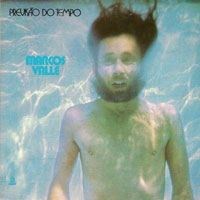 Lost & Found!
Lost & Found!
(03.03.2013)

 Mehr ...
Mehr ...
Mit den Texten auf Englisch und Portugiesisch. Zehn Jahre, nachdem das Debüt von Marcos Valle (Samba Demais") Liebhaber brasilianischer Musik mit dem unglaublichen Talent der Valle-Brüder bekannt machte, half eine neue Richtung und eine neue Backing Band dem Sänger dabei, seine musikalische Palette auszuweiten.
Groovy Funk und Jazz-Fusion, die Hilfe der Band Azimuth (später Azymuth), Synthies, Fender Rhodes und elektronische Sounds ließen den Samba, Bossa Nova und Baiao von Valle zusammen mit der Inspiration aus schwarzer amerikanischer Musik und dem Psych Rock früherer Alben neue Dimensionen erschließen. Obwohl sich Valle nicht komplett vom Sound seiner Vergangenheit entfernte, bringen der Gesang, die Grooves und die tiefgründigen Songs auf Previsao Do Tempo" den Hörer dazu, sich frei zu fühlen und nachzudenken.
Previsao Do Tempo" erschien ursprünglich 1973 und mauserte sich schnell zum Liebling der Valle-Jünger. Neue und alte Fans werden den einfachen Zugang zu diesem ehemals kaum zu findenden brasilianischen Klassiker lieben.
Previsao Do Tempo" ist ein Highlight in der Valle-Diskographie und ein willkommener Neuzugang in jeder südamerikanisch angehauchten Plattensammlung. File after Os Mutantes and before Caetano Veloso.
While Garra had seen all of Marcos Valle's talented parts -- songwriting, production, singing, and performing -- coalesce into the most beautiful whole ever seen in Brazilian music, Previsão do Tempo represented a slight pulling back from those lofty heights. Easygoing and relaxed where Garra had been nearly giddy with joy, the album still didn't lack for career-topping moments -- most of them due to the sunny groove produced by Valle with his backing band (soon to break away and form the boundary-pushing Azymuth). With Valle on Fender Rhodes and Jose Roberto Bertrami on Mini-Moog and ARP, the album is more electronic than electric, but with soloists as talented as these, and a lifetime of musical instincts to draw on, the results are absolutely pristine. (Only Stevie Wonder was capable of coaxing the same type of warm, fluid grooves from his coterie of synthesizers, and integrating them so flawlessly into his productions.) As could be expected, narrative songwriting takes a backseat. In its place are loose, aqueous, funk-filled jams with synth and electric bass leading the way. Garra is still the peak of Marcos Valle's '70s output, but Previsão do Tempo is its own masterpiece, one where a listener plays connect-the-dots to hear the beauty inside.
(by John Bush, All Music Guide)
|
| "Beto Guedes - Danilo Caymmi - Novelli - Toninho Horta" (EMI/Odeon, 1973) |
 Vier
Mausiker der zweiten Reihe fanden sich zu diesem Projekt zsammen und liefern
eine spannende Mischung aus Brasilien und Rock: Gitarrist Beto Guedes,
FlÃķtist Danilo Caymmi, Bassist Novelli und Gitarrist
Toninho Horta. FÞr Freunde des "Clube
Da Esquina". Vier
Mausiker der zweiten Reihe fanden sich zu diesem Projekt zsammen und liefern
eine spannende Mischung aus Brasilien und Rock: Gitarrist Beto Guedes,
FlÃķtist Danilo Caymmi, Bassist Novelli und Gitarrist
Toninho Horta. FÞr Freunde des "Clube
Da Esquina".
(01.08.2013) |
| Caetano Veloso: "AraÃ§ÃĄ Azul" (Philips, Nov. 1972) |
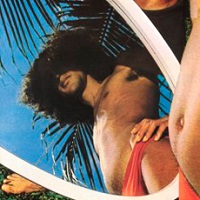
(19.01.2021)
Platz97im Rolling Stone!

 Mehr ...
Mehr ...
AraÃ§ÃĄ Azul marks the end of Caetano Veloso's pop- and rock-oriented phase made up by his previous four studio albums. AraÃ§ÃĄ Azul is also the most experimental and "difficult" album that Veloso has ever made, and it bears few similarities to his earlier recordings. Many people who bought the album when it was newly released had expected it to be a natural and similar follow-up to 1972's Transa. After having listened to it, many of people got so disappointed with AraÃ§ÃĄ Azul that they actually went back to the stores where they had bought it and demanded a refund. On the other hand, AraÃ§ÃĄ Azul was very much acclaimed by critics. Typical tracks on the album are the fascinating "De Conversa," which doesn't have a melody or real lyrics, and the playful "Gilberto Misterioso." Another good track is the psychedelic, almost punk-styled "Eu Quero Essa Mulher." There is also the delicate and beautiful "JÚla/Moreno" and the equally beautiful "Tu Me Acostumbraste," with lyrics in Spanish. These last two songs perhaps give a hint of what Veloso would soon produce on '70s masterpieces like JÃģia, Bicho, and Cinema Transcendental. As a whole, though, this album, with all its experimentalism and sound effects, probably isn't something that one would put on while having friends visit, but for a fan of experimental music or for someone in the right mood, it's a very good record.
(by Philip JandovskÃ―, All Music Guide)
|
| "Lô Borges " (EMI, 1972) |

1972 war Lô Borges im zarten Alter von 20 Jahren zusammen mit
seinem Jugendfreund Milton Nascimento im "Clube
Da Esquina". Kurz danach nahm er auch sein titelloses DebÞtalbum
auf, wo man deutlich erkennen kann, dass er fÞr den Stil dieses
Meisterwerks mindestens genauso wichtig war wie sein viel bekannterer
Kumpel Milton.
(01.04.2012)
Ein Þberragend gutes Album, obwohl ich kein Wort von dem verstehe,
was da gesungen wird! Obwohl es mit immerhin 15 Liedern nur eine knappe
halbe Stunde lang ist, wÞrde ich die Platte in die Reihe der grandiosen
Singer/Songwriter Alben des Jahres 1972 mit Beatles, Jazz und Folkelementen,
wie zum Beispiel "Big Star #1",
einordnen.
(13.04.2012)

 Mehr ...
Mehr ...
Reminiscent of the Clube da Esquina album he made the same year with Brazilian superstar Milton Nascimento, Lô Borges' 1972 solo debut proves that his influence on Nascimento was quite strong. The recording is texturally lush and dreamy, at times urgent and bizarre, and filled with the fantastic and intricate guitar playing one would expect of Borges after hearing his dazzling work with Nascimento. His vocal arrangements are lavish, often similar to the vocal qualities of George Harrison's All Things Must Pass, and his instrumental arrangements are just plain confounding. Piano phrases mash in and out of control over the unorthodox yet clever progressions; polyphonic percussion interlocks with jazzed-out organ lines and thoughtful, melodic bass work. Occasionally, a string section will fall into place, fulfilling the album's decorative quota, and the whole construction becomes watertight. It is truly stunning to pick apart the timbre of individual instruments and realize how necessary and meticulous each part is in the overall presentation. Borges is one of those arrangers who can build up a music bed with miles of depth and construct a wall of sound, yet keep the overall concept in crisp focus. No layer of the instrumentation seems to ever become obscured by another, nor does any part seem unnecessary, and so much is going on rhythmically and melodically that it demands full attention. The remarkable quality of Brazil's musical culture to seamlessly integrate as many outside influences into one place is well represented here. Many western textures, such as soul, rock, jazz, and pop, are absorbed into the picture with fervor and grace rarely executed in the world of western music. "Não Foi Nada" illustrates this particularly well, but the melting-pot sentiment echoes through all of Borges' performances here.
(by Gregory McIntosh, All Music Guide)
Originally released in 1972, Lo Borges' solo debut is a stunning piece of post-bossa nova Brazilian pop music. Combining influences ranging from soul, jazz, pop, psychedelic, and bossa nova with brilliant musicianship and wild arrangements, Lo Borges is one of the finest Brazilian records of the 1970s, if not ever. Borges emerged out of the Clube de Esquina musical collective, from the state of Minas Gerais, along with Milton Nascimento, a movement that rivaled the brilliance of the more well known Tropicalismo. Absolutely brilliant and available on CD in the USA for the first time ever.
|
| Astrud Gilberto: "Now" (Perception, 1972) |
 [Joao Gilberto]
[Joao Gilberto]

 Mehr ...
Mehr ...
ïŧŋ
Two years after her underrated album on CTI Records, Astrud Gilberto's follow-up is her first attempt to be taken seriously, not as a singer -- she had that covered -- but as a songwriter, at a time when simply singing standards was seen as lacking. Her four songs on this ten-song album show she has a way with a melody, though obviously influenced by countrymen Milton Nascimento and Jorge Ben, and her producer Eumir Deodato. "Gingele" and "Zigy Zigy Za" are exactly the kind of riff-based tropicalismo that Ben and company were making popular around this time. "Take It Easy My Brother Charlie" is probably her best song here (covered over 20 years later by Kahimi Karie), though it is Ben who often gets the writing credit (here it's listed as Gilberto and associate producer David Jordan). Very few concessions are made to America; only "Daybreak (Walking Out of Yesterday)" comes from the pop world, with instrumentation and sound coming from south of the equator.
(by Ted Mills, All Music Guide)
|
| Caetano Veloso: "Transa" (Philips, 1972) |

(28.12.2018)
Platz10im Rolling Stone!

 Mehr ...
Mehr ...
ïŧŋ
Released in 1972, Transa was recorded by Caetano Veloso during his exile in London, England, shortly before his return to Brazil. The sound of '70s electric rock predominates, fused with Brazilian rhythms and percussion, berimbau sounds, and his own violÃĢo playing. Several lyrics in English, and also in Portuguese, carefully avoid direct reference to politics, which may be found disguised in all songs, especially in the melancholic and depressed images of the poem by GregÃģrio de Matos, "Triste Bahia," for which Veloso wrote the music. "It's a Long Way" also makes ciphered references to the political situation and was broadly played in the '70s. The broad use of pontos de capoeira (music used for accompaniment of capoeira, a martial art developed by Brazilian slaves as a resistance against the whites) can also be understood in that sense. The album also has "Mora na Filosofia," a classic and beautiful samba by Monsueto that scandalized people with its rock rendition.
(by Alvaro Neder, All Music Guide)
|
| Sergio Mendes & Brasil 66: "Foursider" (A&M, 1972) |
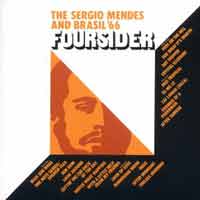 Ein
Klassiker aus der Hochphase der Popmusik! "Foursider" ist ein
Greatest-Hits-Doppelalbum mit Aufnahmen aus den spÃĪten 60ern, das
heute noch eindrucksvoll demonstriert, wie zeitlos diese Mischung aus
Bossa Nova, Quasi-Jazz und Easy Listening-Pop ist, mit welcher der brasilianische
Pianist Sergio Mendes damals weltweit Erfolg hatte. Dieses Konzept
erlaubte ihm, Pop-Originale von Joni Mitchell ("Chelsea Morning"),
den Beatles ("A Little Help From My Friends", "Fool
On The Hill" und "Norwegian Wood"), Burt Bacharach
("Look Of Love"), Buffalo Springfield ("For What
It's Worth"), Otis Redding ("The Dock Of The Bay")
und J.J. Cale ("After Midnight") ohne BrÞche neben
brasilianisches Material von Jorge Ben ("Mas
Que Nada"), Joao Gilberto und Tom Jobim ("Samba
De Uma Nota So", "Vou Te Contar") zu stellen. Ein
Klassiker aus der Hochphase der Popmusik! "Foursider" ist ein
Greatest-Hits-Doppelalbum mit Aufnahmen aus den spÃĪten 60ern, das
heute noch eindrucksvoll demonstriert, wie zeitlos diese Mischung aus
Bossa Nova, Quasi-Jazz und Easy Listening-Pop ist, mit welcher der brasilianische
Pianist Sergio Mendes damals weltweit Erfolg hatte. Dieses Konzept
erlaubte ihm, Pop-Originale von Joni Mitchell ("Chelsea Morning"),
den Beatles ("A Little Help From My Friends", "Fool
On The Hill" und "Norwegian Wood"), Burt Bacharach
("Look Of Love"), Buffalo Springfield ("For What
It's Worth"), Otis Redding ("The Dock Of The Bay")
und J.J. Cale ("After Midnight") ohne BrÞche neben
brasilianisches Material von Jorge Ben ("Mas
Que Nada"), Joao Gilberto und Tom Jobim ("Samba
De Uma Nota So", "Vou Te Contar") zu stellen. |
| Milton Nascimento & Lô Borges: "Clube Da Esquina" (EMI, 1972) |

Ende der 60er Jahre, autoritÃĪres MilitÃĪrregime, Belo Horizonte,
Hauptstadt des Bundesstaates Minas Gerais, eine Gruppe junger Freunde,
die sich fÞr die Jugendrevolte in der westlichen Welt begeistern.
Ihr Chef: ein dÞnner Schwarzer, der mehrere Instrumente perfekt
beherrscht und eine auffÃĪllige Stimme besitzt: Bituca,
spÃĪter berÞhmt als Milton Nascimento.
Mit dabei sind der Keyboarder Wagner Tiso, die Poeten Fernando
Brant und Ronaldo Bastos, der Gitarrist Toninho Horta,
der Kontrabassist Beto Guedes, die BrÞder Marcio
und Lo Bôrges und andere Komponisten und
Musiker. Jazz und Rock vermischen sich mit Bossa Nova und anderen brasilianischen
Stilen. Der Club wird in ganz Brasilien berÞhmt, seine Platten
mit dem Label 'Clube da Esquina' verkaufen sich Þberall
und prÃĪgen eine Generation.
Das Album ist ein Klassiker der brasilianischen Popmusik und ein guter
Einstieg fÞr jeden, der bisher keinen Zugang zu dieser Musik hatte.
Ich hatte gerade frisch ein Buch Þber brasilianische Musik verschlungen
("The Brazilian Sound" von Chris McGowan und Ricardo
Pessanha, Hannibal 1991) als ich dieses Doppelalbum auf einer CD
wiederverÃķffentlicht fÞr schlappe DM 13,95 bei Zweitausendeins
entdeckte und natÞrlich sofort zuschlug. Es handelt sich tatsÃĪchlich
um eine gelungene Verbindung von Brasilien und Europa (Beatles vor allem).
Ich kannte sogar ein Lied: "Cravo E Canela", ich weià aber
leider nicht mehr woher!
Die mir bekannte Version von "Cravo E Canela" stammt von
Flora Purim, zu finden auf ihrem tollen Liveabum "500 Miles".
(01.04.2012)
Platz7im Rolling Stone!

 Mehr ...
Mehr ...
| "Unsere Musik drückte unsere Revolte aus, aber
auch unsere Liebe und die Lust an der Schönheit. Wir verbreiteten eine
demokratische Kultur und waren gegen Hass und Gewalt. Wir suchten die Harmonie
und die Öffnung zur Welt, die wir als unser Heimat betrachteten. 1972
erschien unsere erste LP, ein gewaltiger Erfolg". (Fernando Brant)
|
|
"Flamencogitarren und Keltenklänge, Sambarhythmen
und Salsagrooves, orientalische Arabesken und "Ethno-Punk" --
das eklektische Label Hemisphere präsentiert nicht die Musik der westlichen,
sondern der restlichen Welt. Etwa den letzten Konzertmitschnitt von Argentiniens
Tango-Virtuosen Astor Piazzolla oder die Neuauflage der beiden Clube Da
Esquina-Alben von Milton Nascimento ein Vierteljahrhundert nach ihrer Erstveröffentlichung.
Nascimento, 1942 in Rio geboren und als schwarzes Adoptivkind bei einer
weißen Familie in der Provinz Minas Gerais aufgewachsen, gehört
zu den bekanntesten Sängern Südamerikas. Nicht nur seine engelsgleiche
Stimme trägt den Hörer in andere Sphären, auch sein Kompositionstalent
weckte weltweit Bewunderung. Selten hat sich ein schwarzer Musiker stilistisch
den europäischen Bands so weit angenähert wie er. Dabei schuf
Milton seinen eigenen Stil: Eine geniale Mixtur aus Bossa Nova und Brit-Pop,
Klassik und Jazz, Folklore und Chanson. Seine Songwriterqualitäten
entfalten sich unübertroffen in seinem faszinierendsten Projekt: Das
erste Album mit dem Clube Da Esquina, dem "Club von der (Straßen-)Ecke"
erschien 1972, eine Neuauflage dieses Bandprojekts mit Freunden und Gleichgesinnten
unter dem Titel Club Da Esquina 2 folgte 1978. Beide Doppelalben gehören
heute zu den Klassikern der brasilianischen Popmusik. Experimentell, avantgardistisch
(auch für heutige Verhältnisse) und symphonisch präsentiert
dieses Meisterwerk trotz des deutlichen Einflusses europäischer Vorbilder
wie Pink Floyd oder Beatles Musik, wie sie nur von einem Lateinamerikaner
gemacht werden kann. Mehrheitlich melancholische Titel wie "O Trem
Azul" oder "San Vicente" konterkarieren die ausgelassene
Fröhlichkeit des südamerikanischen Karnevals. Die Neuauflage des
Clube Da Esquina stellt auch Klangfetischisten zufrieden. Die Mastertapes
wurden 1995 in den Londoner Abbey Road Studios neu abgemischt." (Wolfgang
Zwack, Amazon) |
|
|
This is the CD reissue of a classic double LP recorded in 1972 by Milton
Nascimento and Lô Borges. The album had orchestrations of Eumir
Deodato and Wagner Tiso under the conduction of the renowned clarinetist/composer/orchestrator
Paulo Moura. The title Clube da Esquina is related to the gang of mineiros
(people from the Minas Gerais state) that populate this release, either
singing compositions or vocal/instrumental performances, like Nascimento
and Borges themselves: Wagner Tiso, Beto Guedes, Milton Guedes, Tavito,
Toninho Horta, Márcio Borges, Ronaldo Bastos, and Fernando Brant,
among others. The album covers a great number of Clube da Esquina hits,
like "Tudo Que Você Podia Ser," "Cais," "O
Trem Azul," "Caravo E Canela," "Um Girassol da Cor
do Seu Cabelo," "San Vicente," "Clube da Esquina No.
2," and so many others, with the competent backing of some of the
best musicians in Brazil, including bassist Luiz Alves and percussionist
Robertinho Silva. A must-have. (by Alvaro Neder, AMG)
|
|
| Jorge Ben: "Ben" (Philips, 1972) |

|
| Os Novos Baianos: "Acabou Chorare" (Som Livre, 1972 * Mr. Bongo, Okt. 2015) |
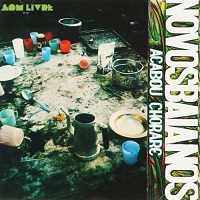 Das ist nach Meinung des Rolling Stone das beste Album aus Brasilien. Da bin ich natÞrlich
neugierig geworden ...
Das ist nach Meinung des Rolling Stone das beste Album aus Brasilien. Da bin ich natÞrlich
neugierig geworden ...
(27.04.2019)
Platz1im Rolling Stone!

 Mehr ...
Mehr ...
ïŧŋ
Os Novos Baianos was an important group in Brazilian music in the '60s and '70s -- from which came several successful solo artists: Moraes Moreira, Baby Do Brasil (then Baby Consuelo), Pepeu Gomes (a virtuoso in rock guitar and choro mandolin), and Paulinho Boca de Cantor. Other support musicians for their recordings included here had already constituted a band called A Cor Do Som, which also had some international success playing electric choro. This is their second album, released in 1972. The work displays a strong influence from JoÃĢo Gilberto, with whom they had been together in the preceding year (clearly felt in Moraes' "Acabou Chorare"). But it is not related to bossa nova in any way, consisting of explorations of the group's compositions in acoustic and electric settings, with freshness and originality. The album has some important songs, including "Brasil Pandeiro," a classic by Assis Valente rejected by Carmem Miranda that deals with the appreciation for Brazilian music by American people; "Preta Pretinha"; "Acabou Chorare"; and "Besta ÃĐ Tu."
(by Alvaro Neder, All Music Guide)
|
| Marcos Valle: "Vento Sul" (Odeon, 1972) |
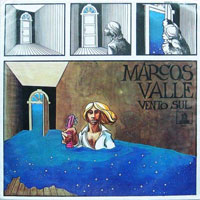 Lost & Found!
Lost & Found!
(09.03.2013)

 Mehr ...
Mehr ...
During the hot Brazilian summer of 1971, Marcos and Paulo Sergio Valle, along with their significant others and six additional couples, rented a few modest fisherman shacks in the small village of Búzios to escape from Rio's more populated beaches. The focus was making music and soul searching, as was the practice for affluent young hippies back then. They stayed for two months. "I wanted to go in a new direction," says Marcos looking back. "I wanted to try out a rock influence and to risk a little bit more." Shifting away from the studio musicians used on 1971's Garra, Vento Sul (translation "South Wind") was a rewarding collaboration with Brazilian progressive rockers O Terįo. Originally released in 1972, Vento Sul not only channeled the Búzios beach bum vibe, but also manifested a floating dream like psychedelic sound. Any way you spin it, we at Light In The Attic are extremely proud to present Vento Sul as part of our four-album Marcos Valle reissue campaign. Consisting of an ambitious string of early 1970s landmark studio sessions (sympathetic in spirit to Stevie Wonder and Marvin Gaye's game changing work from the same era) and released on LP, Vento Sul features extensive liner notes by San Francisco-based writer Allen Thayer (Wax Poetics) with exclusive interview content and song-by-song breakdown from Marcos himself. Fans new and old will finally have easy breezy access to these once hard-to-find Brazilian classics. Elevated by a strong union between Valle and O Terįo, Vento Sul'smagical spell of an album is a welcome addition to any South American friendly record collection and sits proudly with the best of Brazil. File after Os Mutantes and before Caetano Veloso.
Für heutige Ohren fällt diese exotische Mischung aus Flöten, E-Gitarren, Gainsbourg-Bass und entrückten Satzgesängen, die ebenso viele Kanten wie schwungvolle Rundungen aufweist, eigentümlich unvermittelt aus Zeit und Raum.
(stereoplay, März 2013)
When Marcos Valle recorded 1972's Vento Sul, he'd been a wildly successful, well-established songwriter, producer, and recording artist for nearly a decade, furthering the horizons of bossa nova and samba in the pre-MPB era. Due to that success, each successive recording brought higher expectations. In the face of mounting pressure, Valle dropped out for a bit, took a vacation, and in the process wrote the music for the album that was to become his hardest left turn to that point. Nothing could have prepared listeners for what transpired on Vento Sul (translation: South Wind). Even after the revolution tropicalia had wrought, this album was radical. The set was composed by Valle and brother Paulo Sérgio Valle in Buzios, then a mellow, out-of-the-way beach town that offered young people great surfing and a cosmic communal hippie vibe provided by the Valles and 14 companions who had taken the two-month summer retreat with them. When Valle returned to Rio, he sought to re-create the laid-back dreamy collaborative atmosphere of Buzios in the studio. He'd been backed live by Brazilian psychedelic, proto-prog rockers O Terįo (translation: The Rosary), who included drummer and future guitar hero Vinicius Cantuária. He also employed arrangers Ian Guest and Hugo Bellard and studio aces such as guitarist Claudio Guimarães, drummer Robertinho Silva, and flutist Paulo Guimarães. Some of the music here retains undeniable elements of both bossa and samba ("Malena," "Rosto Barbado," and even the tripped-out "Paisagem de Mariana"), but they are wrapped in expansive psychedelic rock and baroque pop textures. Art rock makes its presence known in opener "Revoluįão Orgânica," with its contrasting hyper flute and hard rock guitar -- but make no mistake, this is not tropicalia; if anything it reflects the influence of O Terįo most, and here too, samba makes its voice known in the bridge. There are Pet Sounds-era Beach Boys sounds, textures, and harmonies throughout, but best heard on cuts such as "Mi Hermoza" (even with its mean electric guitar breaks) and the instrumental "Bôdas de Sangu." "Democústico" is a hallucinatory, political, spoken word number, with phased wah-wah guitars, flutes, harpsichord, and Latin percussion. The title track, by contrast, with its layered piano, guitars, and stretched-to-the-breaking-point waltz rhythm, is so dreamy, spacious, romantic, and sparse, it's the set masterpiece. Vento Sul was greeted with hostility by Valle fans and critics alike, but time has proven that criticism unfounded. It remains one of Valle's most provocative albums, but it's also one of his most beautiful, mysterious, and enduring ones.
(by Thom Jurek, All Music Guide)
|
| "Arthur Verocai" (Continental, 1972) |
 Das SolodebÞt des brasilianischen Gitarristen Arthur Verocai
ist zwar nur knapp unter 30 Minuten lang, aber voll mit groÃartiger
Musik, irgendwo zwischen Brasilien, Funk, Folk und Avantgarde. GastsÃĪnger,
Streicher und BlÃĪser in Perfektion - dazu eine rockige Rhythmusgruppe,
bei der man ihre sÞdamerikanische Herkunft (meist) erkennen kann.
Eine Entdeckung Þber eine Coverversion des letzten Liedes, "Karina",
durch die Neuaufnahme des schwedischen Trompeters Goran
Kafjes.
Das SolodebÞt des brasilianischen Gitarristen Arthur Verocai
ist zwar nur knapp unter 30 Minuten lang, aber voll mit groÃartiger
Musik, irgendwo zwischen Brasilien, Funk, Folk und Avantgarde. GastsÃĪnger,
Streicher und BlÃĪser in Perfektion - dazu eine rockige Rhythmusgruppe,
bei der man ihre sÞdamerikanische Herkunft (meist) erkennen kann.
Eine Entdeckung Þber eine Coverversion des letzten Liedes, "Karina",
durch die Neuaufnahme des schwedischen Trompeters Goran
Kafjes.
(18.08.2013)

 Mehr ...
Mehr ...
Das megarare Album des aussergewöhnlichen Komponisten und Arrangeurs Artur Verocai von 1972 ist wieder erhältlich! Das Album ist mit einer Mischung aus Funk Einflüssen, Folk Anleihen, jazzartigen Soli, zwanzigköpfigem Streichorchester, elektronischen Klängen und Soundtrackästhetik ein echtes Meisterwerk. Für Fans von Shuggie Otis, Jorge Ben oder Tim Maia!
Arthur Verocai's long-lost solo LP straddles the continents to fuse Brazilian tropicalia with American funk, yielding a shimmering, dreamlike mosaic of sound that both celebrates and advances the creative spirit. Employing a dizzyingly lush 20-piece string section, stiletto-sharp bursts of brass, and electric piano melodies that twinkle like stars, Verocai's heady productions draw on folk, jazz, and pop traditions from both sides of the equator to make music that is both immediately familiar and quite unlike anything else you've ever experienced. While its sun-kissed arrangements and insistent rhythms clearly evoke its Brazilian origins, Arthur Verocai nevertheless seems to exist somewhere far outside of space and time.
(by Jason Ankeny, All Music Guide)
|
| Sergio Mendes & Brasil 66: "Stillness" (A&M, 1971) |
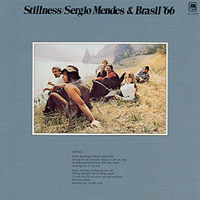 Das letzte Album der "Brasil '66"-Truppe ist mir inzwischen
das liebste der Band - vielleicht, weil es so klingt, als hÃĪtte Mendes
nicht mehr versucht, Hits zu produzieren, sondern einfach nur gute Musik
zu machen? Man kÃķnnte aufgrund des Covers oder der hÃĪufig eingesetzten
12saitigen Akustikgitarre (von Oscar Castro Neves?) sogar von Folkrock
sprechen. DafÞr spricht auch die Liedauswahl, z.B. "For What It's
Worth" von Buffalo Springfield
oder "Chelsea Morning" von Joni
Mitchell. Im nÃĪchsten Jahr gab es dann die Band "Brasil '77",
die aber bei weitem nicht mehr so erfolgreich war, die ich mir aber leider
auch noch nicht anhÃķren konnte. Das kÃķnnte aber glatt mein nÃĪchstes brasilianischen
"Forschungsprojekt" sein!
Das letzte Album der "Brasil '66"-Truppe ist mir inzwischen
das liebste der Band - vielleicht, weil es so klingt, als hÃĪtte Mendes
nicht mehr versucht, Hits zu produzieren, sondern einfach nur gute Musik
zu machen? Man kÃķnnte aufgrund des Covers oder der hÃĪufig eingesetzten
12saitigen Akustikgitarre (von Oscar Castro Neves?) sogar von Folkrock
sprechen. DafÞr spricht auch die Liedauswahl, z.B. "For What It's
Worth" von Buffalo Springfield
oder "Chelsea Morning" von Joni
Mitchell. Im nÃĪchsten Jahr gab es dann die Band "Brasil '77",
die aber bei weitem nicht mehr so erfolgreich war, die ich mir aber leider
auch noch nicht anhÃķren konnte. Das kÃķnnte aber glatt mein nÃĪchstes brasilianischen
"Forschungsprojekt" sein!
(12.04.2009)

 Mehr ...
Mehr ...
Stillness is a concept album the title tune opens and closes it in moody stillness and a transition piece all at once, for Sergio Mendes seemed to be searching for a viable way out of the Brasil '66 formula. Indeed, "Righteous Life," using a different L.A. rhythm section, is really a folk-rock record, a good one, and a far cry from the bossa-propelled '60s. So is the funky voodoo cover of Stephen Stills' "For What It's Worth" in its own way, though the old Brasil '66 sound does come in very handy in a superb treatment of another folk-rock song, Joni Mitchell's "Chelsea Morning." Yet Mendes also experiments with different, more authentically Brazilian rhythm patterns in a brilliantly propulsive rendition of Gilberto Gil's "Viramundo" and a lovely Oscar Castro-Neves/Sebastiao Neto tone poem, "Celebration of the Sunrise." This would also be Lani Hall's farewell to Sergio Mendes, leaving the band in mid-album on the way to becoming Mrs. Herb Alpert and starting a solo career, to be replaced by the Brazilian Gracinha Leporace, who is now Mrs. Sergio Mendes. Overlooked in its day, Stillness is the great sleeper album of Sergio Mendes' first A&M period.
(by Richard S. Ginell, All Music Guide)
|
| Os Mutantes: "Jardim Eletrico" (Polydor, 1971) |
 Das vierte Album in vier Jahren der besten brasilianischen Rockband. Die
Band wird immer besser und immer verrÞckter. Besonders schÃķn finde ich
am Schluss die Neuaufnahme von Caetano Velosos
"Baby", das sie schon mal mit Gal Costa auf dem Album
"TropicÃĄlia - Ou Panis Et Circensis"
eingespielt hatten, dieses mal von Rita Lee auf English gesungen.
Das vierte Album in vier Jahren der besten brasilianischen Rockband. Die
Band wird immer besser und immer verrÞckter. Besonders schÃķn finde ich
am Schluss die Neuaufnahme von Caetano Velosos
"Baby", das sie schon mal mit Gal Costa auf dem Album
"TropicÃĄlia - Ou Panis Et Circensis"
eingespielt hatten, dieses mal von Rita Lee auf English gesungen.
(15.04.2009)
Platz72im Rolling Stone!

 Mehr ...
Mehr ...
Jardim Elétrico is a natural follow-up to Os Mutantes's previous effort, A Divina Comédia Ou Ando Meio Desligado and a step further away from the '60s psychedelics that characterized the groups first two albums. Some consider Jardim Elétrico to be the beginning of the decline of Os Mutantes, but the album is very popular among the fans of the group. One of the absolute highlights of the album is the humorous "El Justiciero," which features Spanish lyrics and also some Spanish-style guitar play. Other great songs are "Tecnicolor," which has lyrics in English, the melodious and slightly Beatlesque "Virgínia," and "Tudo, Tudo, Tudo," a song that features a bluesy mouth harmonica. On these and other tracks on the album, the music of Os Mutantes is just as playful and creative as ever. On the whole, this is a very enjoyable album that will almost certainly appeal to any fan of the group. The casual listener, though, will probably be better off starting with one of the group's three first albums. It may be worth noting that five of the songs on Jardim Elétrico were really recorded in France in 1970 to appear on the album Tecnicolor, which aimed at the international market, but wasn't released until the year 2000. To get hold of these songs, Jardim Elétrico is definitely a better choice than Tecnicolor.
(by Philip Jandovský, All Music Guide)
|
| Chico Buarque: "Construção" (Philips, 1971) |
 Ein weiterer der vielen groÃartigen Singer/Songwriter aus Brasilien
mit einem seiner besten Album.
Ein weiterer der vielen groÃartigen Singer/Songwriter aus Brasilien
mit einem seiner besten Album.
(23.12.2012)
Platz3im Rolling Stone!

 Mehr ...
Mehr ...
Chico Buarque's fifth album for Philips is a classic, where nearly all the songs became hits. Buarque was featured in an acoustic setting, almost completely aloof from the tropicália movement (the courageous orchestration of Construįão is very reminiscent of the influential work by Rogério Duprat). He delved into the Brazilian tradition of sambas and romantic or doleful songs, coming up with "Deus Lhe Pague" and "Construįão," both having strong lyrics subliminally criticizing the military dictatorship; "Cotidiano," existentially thematic, revolving around the man-woman relationship routine; "Olha Maria" (written with Tom Jobim and Vinícius de Moraes), a sad separation farewell; "Samba de Orly," a reference to the French airport and city that became paradigms of the exiled Brazilians; "Valsinha," a beautiful love story; and other immortal songs in which the genius of the composer meets sensitively and reverently the heart of the Brazilian feel.
(by Alvaro Neder, All Music Guide)
|
| Marcos Valle: "Garra" (Odeon, 1971) |
 Lost & Found!
Lost & Found!
(03.03.2013)

 Mehr ...
Mehr ...
Der Nachfolger zum selbstbetitelten 1970er Album des brasilianischen Sängers, Songwriters und Musikers Marcos Valle, Garra, nimmt eine gesellschaftlich-wachsame Haltung ein, die hier mit einem verspielten Mix aus Samba, Bossa Nova, Baiao (einem rhythmischen Beat aus der ländlichen Nordosten Brasiliens), schwarzer amerikanischer Musik und psychedelischem Rock gewürzt wird.
Marcos und sein lyrisch begabter Bruder Paulo nahmen das Album mit einigen der besten Studiomusiker Brasiliens auf Garra ist ihr politisch deutlichstes Werk. Aufgenommen zwischen den Session für Seifenoper Soundtracks, mit denen Valle sein Geld verdiente, provozierte das Album wissentlich die staatlich Zensur. Unglücklicherweise kamen einige von Valles Zeitgenossen nicht so ungeschoren davon wie er und wurden für ihre politisch fragwürdigen Inhalte entweder ins Exil geschickt (wie die Ikonen des Tropicalia Gilberto Gil und Caetano Veloso) oder mussten in die USA oder nach Europa flüchten.
Garra erschien ursprünglich 1971 und verzückte mit dem Rare Groove Klassiker Wanda Vidal, der noch Jahre nach der ursprünglichen Veröffentlichung von britischen, europäischen und japanischen Musikfans hochgelobt wurde. Inmitten einer aufregenden Aufstellung von Instrumenten verbirgt sich ein ernsthafter Kern.
Tempering his funkier inclinations to create a Baroque masterpiece of easy listening Brazilian pop, Marcos Valle recorded the most entertaining album of his career, and perhaps the best Brazilian pop album of all time. Garra begins with the elegant "Jesus Meu Rei," with a magisterial men's choir echoing Valle's sentiments while textured piano and organ complete the rich sonic palette. Second track "Com Mais de 30," only the first of several ingenious transitions, offers a light, breezy alternative, bouncing back and forth from main melody to an excellent bridge. Indeed, nearly every song has a bridge as strong as -- or stronger than -- the main melody, and Valle proves himself a master at weaving together the various studio musicians at his disposal. Valle moves briskly and assuredly from piano lines to acoustic guitar and back for "Com Mais de 30," combines flutes and a Mellotron for a tight bridge on the title track, and coaxes all manner of emotions from a symphonic orchestra -- hushed yet gradually building strings, bleating brass -- for the unabashed "Black Is Beautiful." Every song is excellent, most in the easy-pop vein of Samba '68. "Wanda Vidal," "Vinte e Seis Anos de Vida Normal," and the perfectly done closer, "O Cafona," are seamless blends of funk and easy listening; the last features a rangy bassline, organ, and wah-wah guitar working together with handclaps and separated men's and women's backing choruses while Valle breathily repeats words and phrases several times before climaxing at the end of nearly every line. Continually besting symphonic seducers from Esquivel to Brian Wilson, Marcos Valle recorded his masterpiece with Garra.
(by John Bush, All Music Guide)
|
| "Caetano Veloso" (Philips, 1971) |
 Bereits
das dritte titellose Album, aufgenommen im Londoner Exil und auch grÃķÃtenteils in Englisch gesungen. Bereits
das dritte titellose Album, aufgenommen im Londoner Exil und auch grÃķÃtenteils in Englisch gesungen.
(16.12.2018)

 Mehr ...
Mehr ...
ïŧŋ
One look at the doleful expression that Caetano Veloso wears on the cover of his third self-titled album from 1971 and it's clear that the listener is in for a bummer. It's a dead-eyed look that says, "Friend, sit down, have a drink, and listen to my weary tale." And a weary homesick tale it is, for the man who only a few years earlier had been one of the catalysts in a revolution that sent the Brazilian music world on the psychedelic Beatles-lovin' roller coaster of Tropicalia was now living in the U.K. in a government-imposed exile. Gone are the Day-Glo flashes of his earlier albums, replaced by the realism of a revolutionary whose dreams have been shuttered. If there was any doubt to the depths of his melancholy, Veloso clears it up right away with "A Little More Blue," reflecting on being thrown in jail and declaring that his exile is worse than his Brazilian imprisonment. Even more dismal may be the lovesick tribute to his sister, "Maria Bethânia," which plainly spells out his physical and emotional disconnection. It's not all so dismal, though; there are upbeat songs as well, like the acknowledged classic "London, London" and the lone Portuguese-sung track, "Asa Branca." There are Brazilian touches in the drums and Veloso's phrasing, but the album is more in the tradition of downer folk classics like Bob Dylan's Blood on the Tracks and Tim Buckley's Happy Sad. If that seems like heavy company, then seek out this emotionally rich and complex work by an artist who doesn't merely stand on the shoulders of giants -- he is one of the giants.
by Wade Kergan
|
| Bossa Rio: "Alegria!" (Blue Thumb, 1970) |
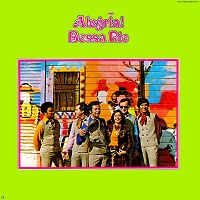 [Sergio Mendes & Brasil 66]
[Sergio Mendes & Brasil 66]

 Mehr ...
Mehr ...
ïŧŋ
In a discussion on the old blog about groups similar to Sergio Mendes & Brasil '66 , the first name that came up was of course the Sergio Mendes produced Bossa Rio. If you're a bit familiar with Brazilian music you will see that this is a kind of 'supergroup'. Members are from left to right (on the upper cover): Osmar Milito (keys), Manfredo Fest (keys), Ronald Mesquita (drums), Gracinha Leporace (vocals), Pery Ribeiro (vocals) and Octavio Bailly Jr. (bass). Milito was replaced by Dwight Dickerson (piano) for the second album.
Probably none of these names were familiar with North American audiences at the time and consequently the personnal is not credited on the album covers, but all of them played important roles in Brazilian music:
Octavio Bailly already was a member of the first Bossa Rio group (Sergio Mendes' Bossa Rio Sextet) and as such took part in the famous Carnegie Hall concert in 1962 as well as recording with Cannonball Adderley. He and Ronald Mesquita functioned as the second rhythm section for Luiz Carlos Vinhas' Bossa Tres. The Bossa Tres not only accompanied Pery Ribeiro on his album Reencontro, crooner and trio also stayed in Mexico between 1966 and 1968 performing and recording as Gemini 5 (with Leny Andrade). Shortly after his stay with Bossa Rio, Mesquita would do two great albums that perfectly transplanted the Brasil'66/Bossa Rio style into the 1970s (Bresil 72 and Ronie e Central do Brasil).
Pery Ribeiro could already look back on a ten year career as a crooner with several succesful albums for the Brazilian market, among them Pery ÃĐ todo bossa, the album that featured the first recording of Garota de Ipanema.
Manfredo Fest was a great blind jazz pianist who's albums from the 1960s are worth checking out for fans of jazz samba, while records like Brazilian Dorian Dream from 1976 are cult items among admirers of jazz fusion.
Osmar Milito is best known for his work for the Telenovelas (soap operas) as well as a handful of pop records similar in style to Marcos Valle.
Gracinha Leporace would become the singer for Brasil '77 and Mrs Mendes. She and her brother Fernando had done two albums with the protest group Groupo Manifesto. We will meet Fernando here soon, too, since he recorded a wonderful pop/psych album with the group Vox Populi.
The music's a well-balanced mix of contemporary Brazilian and North American tunes, wisely avoiding songs which were already recorded by Brasil' 66. The one exception being Wave, the only Tom Jobim piece here, which is taken at a slower pace than the Brasil '66 version.
Jorge Ben provides three of the "hardest" and grooviest pieces, all of which get worthy treatments and are definitely highlights. Edu Lobo, Milton Nascimento, Caetano Veloso and Marcos Valle are all represented with one song, but while Milton's Cancao do Sal is a quite obvious choice (and another highlight), Lobo's Veleiro is a rarely covered song. Bossa Rio's take is remarkably different from it's original version, which can be heard on Edu e Bethania.
It's easy to guess that the lyrics of For Your Love Now, the English language take of Marcos Valle's Mustang cor de Sangue ("Blood-colored Mustang"), bear no resemblance at all to the original words. This set of English lyrics is another questionable effort from Mr Norman Gimble, who unfortunately "translated" many Brazilian classics. The music is excellent nonetheless.
Since i never cared for Caetano Veloso, i'm not familiar with the original version ofToday, Tomorrow (Boa Palavra), but Gracinha's singing is especially delicate here.
Lennon/McCartney were as inevitable as Bacharach/David. It's arguable that we need another version of Eleanor Rigby, while Blackbird, one of the few gentle moments on the White Album, get's a surprisingly dynamic treatment. Do you know the Way to San Jose is a personal favourite from the Bacharach book and doesn't dissapoint.
The weakest moments, at least for this listener, are those where older standards are treated, like Day by Day or The Night has a thousand Eyes. Somehow they just don't seem to click. I always felt similar about Brasil '66' takes of tunes from the great American songbook.
|
| JoÃĢo Donato: "A Bad Donato" (Blue Thumb, 1970) |
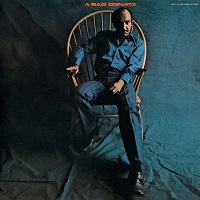
Platz76im Rolling Stone!

 Mehr ...
Mehr ...
Auf diesem 1970 entstandenen Album lieà der brasilianische Pianist JoÃĢo Donato seine Bossa-Nova-Wurzeln hinter sich, um mit der CrÃĻme de la crÃĻme der in Los Angeles ansÃĪssigen Sessionmusiker eine eklektische Mischung aus Funk, Fusion und psychedelischem Rock und Pop einzuspielen. Der brasilianische Rolling Stone zÃĪhlte ÂŧA Bad DonatoÂŦ 2007 zu den Âŧ100 besten Alben der brasilianischen MusikÂŦ.
|
| Antonio Carlos Jobim: "Stone Flower" (CTI, 1970) |
 A Cool Smoker from Brazil!
A Cool Smoker from Brazil!
(31.07.2016)

 Mehr ...
Mehr ...
Zum Bossa Nova schien fast alles gesagt zu sein, als um 1970 die Szene auf zwei Jahrzehnte Musizierstil aus der Synthese von Samba und Cool-Jazz Elementen zurückblickte. Experimentierfreudige Musiker wie Luis Bonfa, Baden Powell, Charly Byrd, João und Astrud Gilberto und der Saxofonist Stan Getz gaben der neuen Sache Feuer wie Sentiment. Allen voran steht Carlos Antonio Jobim, der seine Ohrwürmer wie das tickende und schiebende Stück ŧDesafinadoŦ und den genialisch eintönigen ŧOne Note SambaŦ auf Weltreise schickte.
Dass es für den Mann aus Ipanema noch immer viel zu sagen gab, zeigt dieses Album, das Jobims kreatives Profil auf dem Höhepunkt seine Reife abbildet. Bereits im ersten Titel, in dem Urbie Green an der Posaune ŧTereza My LoveŦ in den reinsten und höchsten Tönen besingt, wird spürbar, dass die Spätlese des Bossa den stilbildenden Rhythmus weitaus feingliedriger strukturiert als die tanzfiebrige Frühreife. Gleichsam mit glänzenden Gold- und Silberfäden werden die Melodien rhythmisch umwoben, verdichtete Klangwellen bleiben duftig und zart. Und doch lassen die Akteure auch die Samba-Pferde von der Leine, wenn es im Latin-Klassiker ŧBrazilŦ knackig klöppelt.
Klangzauberer Deodato als Arrangeur und Dirigent und Rudy van Gelder an der Audio-Technik runden diese LP zu einem Meisterstück des Bossa-Repertoires, womit nun wirklich alles gesagt sein sollte.
ŧStone FlowerŦ - Antonio Carlos Jobim (p, el-p, v, voc, g); Joe Farrell (ss); Urbie Green (tb); Hubert Laws (fl); Eumir Deodato (g, arr, cond); Harry Lookofsky (v); Ron Carter (b); Airto Moreira, Everaldo Ferreira (perc); João Palma (dr)
ŧHerrlich.Ŧ (Good Times, April / Mai 2015)
ŧ... dieses perfekt gepresste 180-Gramm-Reissue bringt den alten Zauber, der wie der Soundtrack jener Epoche wirkt, ins Heute hinüber.Ŧ
(Stereo, Juli 2015)
|
| "Marcos Valle" (Odeon, 1970) |
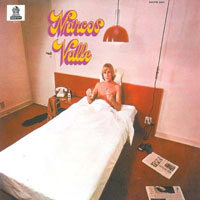 Lost & Found!
Lost & Found!
(23.03.2013)

 Mehr ...
Mehr ...
Der Nachfolger zum selbstbetitelten 1970er Album des brasilianischen Sängers, Songwriters und Musikers Marcos Valle, Garra, nimmt eine gesellschaftlich-wachsame Haltung ein, die hier mit einem verspielten Mix aus Samba, Bossa Nova, Baiao (einem rhythmischen Beat aus der ländlichen Nordosten Brasiliens), schwarzer amerikanischer Musik und psychedelischem Rock gewürzt wird.
Marcos und sein lyrisch begabter Bruder Paulo nahmen das Album mit einigen der besten Studiomusiker Brasiliens auf Garra ist ihr politisch deutlichstes Werk. Aufgenommen zwischen den Session für Seifenoper Soundtracks, mit denen Valle sein Geld verdiente, provozierte das Album wissentlich die staatlich Zensur. Unglücklicherweise kamen einige von Valles Zeitgenossen nicht so ungeschoren davon wie er und wurden für ihre politisch fragwürdigen Inhalte entweder ins Exil geschickt (wie die Ikonen des Tropicalia Gilberto Gil und Caetano Veloso) oder mussten in die USA oder nach Europa flüchten.
Garra erschien ursprünglich 1971 und verzückte mit dem Rare Groove Klassiker Wanda Vidal, der noch Jahre nach der ursprünglichen Veröffentlichung von britischen, europäischen und japanischen Musikfans hochgelobt wurde. Inmitten einer aufregenden Aufstellung von Instrumenten verbirgt sich ein ernsthafter Kern.
Tempering his funkier inclinations to create a Baroque masterpiece of easy listening Brazilian pop, Marcos Valle recorded the most entertaining album of his career, and perhaps the best Brazilian pop album of all time. Garra begins with the elegant "Jesus Meu Rei," with a magisterial men's choir echoing Valle's sentiments while textured piano and organ complete the rich sonic palette. Second track "Com Mais de 30," only the first of several ingenious transitions, offers a light, breezy alternative, bouncing back and forth from main melody to an excellent bridge. Indeed, nearly every song has a bridge as strong as -- or stronger than -- the main melody, and Valle proves himself a master at weaving together the various studio musicians at his disposal. Valle moves briskly and assuredly from piano lines to acoustic guitar and back for "Com Mais de 30," combines flutes and a Mellotron for a tight bridge on the title track, and coaxes all manner of emotions from a symphonic orchestra -- hushed yet gradually building strings, bleating brass -- for the unabashed "Black Is Beautiful." Every song is excellent, most in the easy-pop vein of Samba '68. "Wanda Vidal," "Vinte e Seis Anos de Vida Normal," and the perfectly done closer, "O Cafona," are seamless blends of funk and easy listening; the last features a rangy bassline, organ, and wah-wah guitar working together with handclaps and separated men's and women's backing choruses while Valle breathily repeats words and phrases several times before climaxing at the end of nearly every line. Continually besting symphonic seducers from Esquivel to Brian Wilson, Marcos Valle recorded his masterpiece with Garra.
(by John Bush, All Music Guide)
|
| "Bossa Rio" (A&M, 1969) |
 [Alegria!]
[Alegria!]

 Mehr ...
Mehr ...
ïŧŋ
In a discussion on the old blog about groups similar to Sergio Mendes & Brasil '66 , the first name that came up was of course the Sergio Mendes produced Bossa Rio. If you're a bit familiar with Brazilian music you will see that this is a kind of 'supergroup'. Members are from left to right (on the upper cover): Osmar Milito (keys), Manfredo Fest (keys), Ronald Mesquita (drums), Gracinha Leporace (vocals), Pery Ribeiro (vocals) and Octavio Bailly Jr. (bass). Milito was replaced by Dwight Dickerson (piano) for the second album.
Probably none of these names were familiar with North American audiences at the time and consequently the personnal is not credited on the album covers, but all of them played important roles in Brazilian music:
Octavio Bailly already was a member of the first Bossa Rio group (Sergio Mendes' Bossa Rio Sextet) and as such took part in the famous Carnegie Hall concert in 1962 as well as recording with Cannonball Adderley. He and Ronald Mesquita functioned as the second rhythm section for Luiz Carlos Vinhas' Bossa Tres. The Bossa Tres not only accompanied Pery Ribeiro on his album Reencontro, crooner and trio also stayed in Mexico between 1966 and 1968 performing and recording as Gemini 5 (with Leny Andrade). Shortly after his stay with Bossa Rio, Mesquita would do two great albums that perfectly transplanted the Brasil'66/Bossa Rio style into the 1970s (Bresil 72 and Ronie e Central do Brasil).
Pery Ribeiro could already look back on a ten year career as a crooner with several succesful albums for the Brazilian market, among them Pery ÃĐ todo bossa, the album that featured the first recording of Garota de Ipanema.
Manfredo Fest was a great blind jazz pianist who's albums from the 1960s are worth checking out for fans of jazz samba, while records like Brazilian Dorian Dream from 1976 are cult items among admirers of jazz fusion.
Osmar Milito is best known for his work for the Telenovelas (soap operas) as well as a handful of pop records similar in style to Marcos Valle.
Gracinha Leporace would become the singer for Brasil '77 and Mrs Mendes. She and her brother Fernando had done two albums with the protest group Groupo Manifesto. We will meet Fernando here soon, too, since he recorded a wonderful pop/psych album with the group Vox Populi.
The music's a well-balanced mix of contemporary Brazilian and North American tunes, wisely avoiding songs which were already recorded by Brasil' 66. The one exception being Wave, the only Tom Jobim piece here, which is taken at a slower pace than the Brasil '66 version.
Jorge Ben provides three of the "hardest" and grooviest pieces, all of which get worthy treatments and are definitely highlights. Edu Lobo, Milton Nascimento, Caetano Veloso and Marcos Valle are all represented with one song, but while Milton's Cancao do Sal is a quite obvious choice (and another highlight), Lobo's Veleiro is a rarely covered song. Bossa Rio's take is remarkably different from it's original version, which can be heard on Edu e Bethania.
It's easy to guess that the lyrics of For Your Love Now, the English language take of Marcos Valle's Mustang cor de Sangue ("Blood-colored Mustang"), bear no resemblance at all to the original words. This set of English lyrics is another questionable effort from Mr Norman Gimble, who unfortunately "translated" many Brazilian classics. The music is excellent nonetheless.
Since i never cared for Caetano Veloso, i'm not familiar with the original version ofToday, Tomorrow (Boa Palavra), but Gracinha's singing is especially delicate here.
Lennon/McCartney were as inevitable as Bacharach/David. It's arguable that we need another version of Eleanor Rigby, while Blackbird, one of the few gentle moments on the White Album, get's a surprisingly dynamic treatment. Do you know the Way to San Jose is a personal favourite from the Bacharach book and doesn't dissapoint.
The weakest moments, at least for this listener, are those where older standards are treated, like Day by Day or The Night has a thousand Eyes. Somehow they just don't seem to click. I always felt similar about Brasil '66' takes of tunes from the great American songbook.
Highly sought on vinyl by bossa nova fans, this debut album from this short-lived sextet (not to be confused with Sergio Mendes' Bossa Rio Sextet) seems to suggest a theory: the more handshakes away from Herb Alpert, the better and more authentic the music. Bossa Rio was discovered and produced by Mendes, who in turn was brought into the A&M fold by Alpert. Despite three Brasil '66-ish sounding covers of American hits ("Day by Day," "Up, Up, and Away," and "Do You Know the Way to San Jose"), Bossa Rio stick to tunes from Antonio Carlos Jobim, Jorge Ben, Caetano Veloso, and Milton Nascimento, keeping with their roots (as Mendes and Brasil '66 progressed, the American chart covers took over their albums). Lead vocalist Gracinha Laporace has a clear, gentle tone, perfect for their mellow versions of "Wave" and "Cancao do Sal (Sultry Song)." Organist Manfredo Fest puts the devil in the details, giving a giddy feel to "Nana" and "Today, Tomorrow," coaxing similar sounds out of his Hammond as, strangely enough, Soft Machine's Mike Ratledge. A wonderful album for fans of commercial bossa nova, now available on Japanese import CD only.
(by Ted Mills, All Music Guide)
|
| "Gal Costa" (Philips, 1969) |
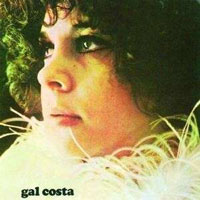 Ein frÞhes Meisterwerk des Tropicalia. Caetano
Veloso und Gilberto Gil sind als SÃĪnger
und vor allem Songschreiber mit dabei. Auf meiner Reissue-LP gibt es zwar
keine Liste der Musiker, aber ich glaube, Sergio Dias von Os
Mutantes heraushÃķren zu kÃķnnen.
Ein frÞhes Meisterwerk des Tropicalia. Caetano
Veloso und Gilberto Gil sind als SÃĪnger
und vor allem Songschreiber mit dabei. Auf meiner Reissue-LP gibt es zwar
keine Liste der Musiker, aber ich glaube, Sergio Dias von Os
Mutantes heraushÃķren zu kÃķnnen.
(11.05.2014)
Platz80im Rolling Stone!

 Mehr ...
Mehr ...
ïŧŋ
Originally released in 1969, Gal Costa's second solo album is one of the finest releases to come out of Brazil's Tropicalia movement. Featuring songwriting and vocal help from Caetano Veloso and Gilberto Gil, Gal Costa flows effortlessly between shredding psychedelia and smooth bossa nova. An essential record for anyone that appreciates the far reaches of Brazilian popular music. Includes the classic tracks "Baby" and "Nao Identificado."
It is easy to see why Gal Costa is so well-received by the Brazilian masses when she has such delightful recordings as these under her belt. Added period charm lies in the numerous psych effects and fuzz guitars that pepper this release. Costa's young vocal work is so full and inviting -- it can be a bit of a surprise when she rears back and turns out a lackadaisical growl. The album begins with a Caetano Veloso song ("Nao Identificado") that starts with a whirr of psychedelic effects before launching into a beautifully arranged mid-paced ballad. The strings flutter and aid Costa's already warm and sensuous vocal work. Certain tracks, like "Sebastiana," sound like Costa recorded the vocals in the bottom of the well, but this is OK. This track also features Gilberto Gil at the end, engaging Costa in what sounds like some sort of heated, happy exchange. The centerpiece of the album is most certainly "Baby," written by Veloso (who also jumps in on the vocal duties). Costa's echoing vocal pours out the melody carefully while the strings glide and swirl along. This song was one of the few chosen for the influential Tropicalia: Panis et Circenses album. Equally marked by fuzz guitar freakouts as it is with dreamy bossa nova, this record is one of the jewels in the crown of Tropicalia, as well as pop music in general.
(by Jon Pruett, All Music Guide)
|
| Edu Lobo: "Cantiga De Longe" (Elenco, 1969) |
 Ein
weiterer ausgezeichneter SÃĪnger/Gitarrist und Autor aus der Generation
nach Jobim. Ich kenne noch nicht viele Alben von ihm,
aber dieses gefÃĪllt mir in seiner sparsamen, jazzigen Art besonders gut.
Mit Hermeto Pascoal und Airto Moreira. Da
kann eigentlich auch nichts schief gehen! Ein
weiterer ausgezeichneter SÃĪnger/Gitarrist und Autor aus der Generation
nach Jobim. Ich kenne noch nicht viele Alben von ihm,
aber dieses gefÃĪllt mir in seiner sparsamen, jazzigen Art besonders gut.
Mit Hermeto Pascoal und Airto Moreira. Da
kann eigentlich auch nichts schief gehen!
(14.02.2009) |
| Milton Nascimento: "Courage" (A&M/CTI, 1969) |
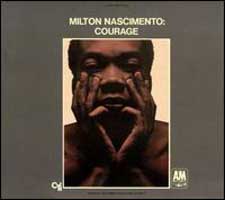 Zum ersten Mal nimmt der brasilianische SÃĪnger und Gitarrist in den
USA bei einem Jazzlabel auf. An den Tasteninstrumenten findet man die
prominentesten Begleiter: Herbie Hancock, sehr "banddienlich"
spielend, am Piano und Eumir Deodato an der Orgel. GewÃķhnungsbedÞrftig
fÞr viele sind sicherlich die fÞr eine Creed Taylor-Produktion
aber typischen Geigen. Egal, ob man sowas nun mag - das ist eine ganz
vorzÞgliche Platte, die dem Brasilien-Unkundigen den ersten Schritt
in eine neue musikalische Welt ermÃķglicht.
Zum ersten Mal nimmt der brasilianische SÃĪnger und Gitarrist in den
USA bei einem Jazzlabel auf. An den Tasteninstrumenten findet man die
prominentesten Begleiter: Herbie Hancock, sehr "banddienlich"
spielend, am Piano und Eumir Deodato an der Orgel. GewÃķhnungsbedÞrftig
fÞr viele sind sicherlich die fÞr eine Creed Taylor-Produktion
aber typischen Geigen. Egal, ob man sowas nun mag - das ist eine ganz
vorzÞgliche Platte, die dem Brasilien-Unkundigen den ersten Schritt
in eine neue musikalische Welt ermÃķglicht.
(26.03.2006)

 Mehr ...
Mehr ...
|
Milton Nascimento's first album for North American ears, recorded at Van Gelder Studios in New Jersey under the watchful eye and discerning ear of Creed Taylor, is a masterpiece, a gorgeously executed tour through his early songs. Backed beautifully by Eumir Deodato's lush orchestrations and a clutch of sidemen from the Taylor stable (including Herbie Hancock, Airto Moreira and Hubert Laws), Nascimento unveils one first-class tune after another, many of which would ignite a rush of cover versions. Among the songs North Americans heard for the first time were "Vera Cruz," "Tres Pontas," "Morro Velho," the scatted "Catavento," and the intensely moving "Bridges (Travessia)" -- the latter which launched Nascimento's name on the world music scene. Singing in English, Portuguese and often, no words at all, Nascimento's odd yet masculine and expressive baritone stands out like a moaning foghorn from the smooth A&M/Taylor sonic formula, a haunting combination. This was Nascimento before tropicalismo, when he latched onto the tail end of the bossa nova movement and quickly became one of its most inspired performers and songwriters. To some admirers, Courage remains his best record, period.
(by Richard S. Ginell, All Music Guide)
|
|
| "Caetano Veloso" (Philips, 1969) |
 Bereits
das zweite titellose Album und bisher das einzige, welches ich vom Meister gehÃķrt
habe. Tolle Musik, irgendwo zwischen Bossa-LÃĪssigkeit und verrÞckten Hippie-Experimenten.
Davon kann ich im Moment gar nicht genug bekommen! Bereits
das zweite titellose Album und bisher das einzige, welches ich vom Meister gehÃķrt
habe. Tolle Musik, irgendwo zwischen Bossa-LÃĪssigkeit und verrÞckten Hippie-Experimenten.
Davon kann ich im Moment gar nicht genug bekommen!
(14.02.2009)

 Mehr ...
Mehr ...
|
by Alvaro Neder
This second Caetano Veloso solo LP was recorded in June 1969, when Veloso
and Gilberto Gil were behind the bars of the military dictatorship. The
albums (Gil also recorded his own) were devised in part to provide them
with a connection to the outside world through which authorities would
be discouraged of attempting some violence against them. The voices were
unsophisticatedly recorded with the sole backing of their own violões
and a metronome, and the arrangements added later in the studio, which
was an indigenous and competent subversion of the basics of production,
especially if you take into consideration the available technology at
that time. The general tone of this album is coherent with the depressing
moment Veloso and the rest of the country were going through. The English
lyrics of his "The Empty Boat" have several strong images of
desperation and sadness, and "Irene" has been largely misunderstood
-- especially the verse "quero ver Irene rir" (I want to see
Irene laughing). "Irene" was the "name" of a machine
gun owned by Tenório Cavalcanti (a robber somewhat celebrated by
leftists at the time). His fado "Os Argonautas" represents implicitly
the aspiration that, as Portugal had got ridden of Salazar (in the precedent
year by a stroke), Brazil could also got rid of its dictatorship. The
superbly modern arrangements of Rogério Duprat and the songs "Não
Identificado," "Acrilírico," and "Marcianita,"
on the other hand, contribute to the anarchic, chaotic, and psychedelic
setting of tropicália in which make part the rustic fuzzed-out
guitars. But maybe the most important thing here is the evident artistic
sincerity felt throughout the album: it is when the listener feels himself
as a voyeur, peeping through the artist's deepest emotions.
|
|
| "Caetano Veloso" (Philips, 1968) |
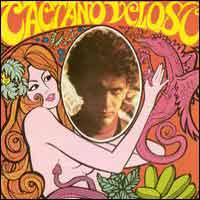 KÞrzlich gab es mal wieder eine erschwingliche Neuauflage von Caetanos erstem Soloalbum auf Vinyl.
Ein absoluter Klassiker. Da konnte ich natÞrlich nicht wiederstehen.
KÞrzlich gab es mal wieder eine erschwingliche Neuauflage von Caetanos erstem Soloalbum auf Vinyl.
Ein absoluter Klassiker. Da konnte ich natÞrlich nicht wiederstehen.
(30.07.2018)
Platz37im Rolling Stone!

 Mehr ...
Mehr ...
|
by Alvaro Neder
The first Caetano Veloso solo album was recorded in 1967. Soon after
the III FMPB, where Veloso took fourth place with "Alegria, Alegria,"
he and his group (which would soon constitute the tropicália movement)
were news, dividing opinions concerning the group's interest in fusing
Brazilian music with international pop culture, lysergic psychedelia,
generalized irreverence, and whatever crossed their minds. The arrangements
were done by three classically trained composers, fully committed to the
most adventurous experiments in modern music: Júlio Medaglia, Damiano
Cozzella, and Sandino Hohagen. Veloso's concept was that the album should
surpass the Beatles' Sgt. Pepper's, being also very Brazilian and, at
the same time, international. The record has immortal classics, such as
"Clarice," "Soy Loco Por Ti América" (Gilberto
Gil/Capinam), composed under the effect of the recent death of Che Guevara,
"Superbacana," "Tropicália," and "Alegria,
Alegria." The rest of the album has had less success but consists
of excellent tracks that remain modern until today. "Tropicália,"
the title track, was an unnamed song when its recording began. By suggestion
of the then photographer Luís Carlos Barreto, Veloso used the same
name of an installation by the visual artist Hélio Oiticica, which
was composed by a labyrinth made with plants and birds conducing to a
television set. The suggestion was accepted -- and the tropicália
was born.
|
|
| "Os Mutantes" (Polydor, 1968) |
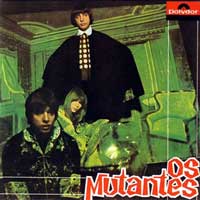 Lost And Found!
Lost And Found!
(12.06.2004)
Platz9im Rolling Stone!

 Mehr ...
Mehr ...
| "Tropicalia upstarts Os Mutantes's 1968 debut is one
of the most playful rock records of its time--and given that it arrived
in the year of the "White Album" and We're Only in It for the
Money, that's really saying something. Screaming acid-rock guitars, quick-cut
rhythmic shifts, sound effects, jazzy vocal harmonies, and a giddy nod to
"Peppermint Twist" all have their places here. When one member
loudly slurps to punctuate a line about ice cream, it's a moment that defines
a movement's whole giddy aesthetic." (Rickey Wright) |
|
| "Gilberto Gil" (Philips, 1968) |
 Sein zweites Soloabum nahm Gil zusammen mit Os Mutantes
auf, mit denen er schon bei "TropicÃĄlia - Ou
Panis Et Circensis" zusammemgearbeitet hatte. Ein ausgezeichnete
Mischung aus Beatles und Brasilien.Fast schon zu "rockig" fÞr
das heimische Publikum.
Sein zweites Soloabum nahm Gil zusammen mit Os Mutantes
auf, mit denen er schon bei "TropicÃĄlia - Ou
Panis Et Circensis" zusammemgearbeitet hatte. Ein ausgezeichnete
Mischung aus Beatles und Brasilien.Fast schon zu "rockig" fÞr
das heimische Publikum.
(09.05.2013)
Platz78im Rolling Stone!

 Mehr ...
Mehr ...
Gilberto Gil's second album is packed with some of the best songs of his career jubilant pop extravaganzas like "Domingo No Parque," "Pega a Voga, Cabeludo," and "Frevo Rasgado" that were equally inspired by the irresistible, brassy bombast of Carnaval and intelligent rock & roll from America and Britain. Even more than the other tropicalistas, though, Gil blends his rock and native influences seamlessly, resulting in songs like "Ęle Falava Nisso Todo Dia" that chart an intriguing fusion of Brazilian and British Invasion (before he breaks into Portuguese for the first verse, the intro sounds exactly like a few early Rolling Stones productions). Gil's occasional backing band, the teenage tropicalia breakouts known as Os Mutantes, join in on the feel-good Brazilian pop anthem "Domingou." Enjoyable and never as experimental as his work would soon become, Gilberto Gil 1968 is one of the best tropicalia albums ever released.
(by John Bush, All Music Guide)
|
| Sergio Mendes & Brasil 66: "Fool On The Hill" (A&M, 1968) |


 Mehr ...
Mehr ...
Having hit upon another smash formula -- cover versions of pop/rock hits backed by lavish strings, a simplified bossa nova rhythm, and the leader's piano comping -- Sergio Mendes & Brasil '66 produced two more chart-busting singles, again turning to the Beatles for sustenance with the title track (number six) and Simon & Garfunkel for "Scarborough Fair" (number 16). But again, the bulk of the album was dominated by Brazilians, and by one in particular: the hugely gifted Edu Lobo, whose dramatic "Casa Forte" and infectious "Upa, Neguinho" were the best of his four songs. The tracks were longer now, the string-laden ballads (arranged by Dave Grusin) more lavish and moody, and Lani Hall emerged as the vocal star of the band, eclipsing her new partner, Karen Philipp (although Hall is upstaged on "Lapinha" by future Brasil '77 member Gracinha Leporace). Even though he had become thoroughly embedded in the consciousness of mainstream America, Mendes still managed to have it three ways, exposing first-class tunes from little-known Brazilian talent, garnering commercial hits, and also making some fine records. Cultural note: the striking foldout cover art, depicting Brasil '66 at sunset seated on top of a nude woman, somehow made it past the uptight censors of the day and no doubt boosted sales; it was Mendes' highest-charting album at number three.
(by Richard S. Ginell, All Music Guide)
|
| "TropicÃĄlia - Ou Panis Et Circensis" (Philips, 1968) |
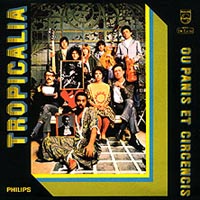 Die Album gilt als der Beginn des brasilianischen Musikstils "Tropicalia",
der brasilianische (Bossa Nova, Samba) und anglo-amerikanische (Jazz,
Blues, Rock) Popmusik zusammenbrachte. Alles war erlaubt. Entsprechend
bunt diese Mischung, angerÞhrt von Caetano Veloso,
Gilberto Gil, Gal Costa,
Os Mutantes und anderen.
Die Album gilt als der Beginn des brasilianischen Musikstils "Tropicalia",
der brasilianische (Bossa Nova, Samba) und anglo-amerikanische (Jazz,
Blues, Rock) Popmusik zusammenbrachte. Alles war erlaubt. Entsprechend
bunt diese Mischung, angerÞhrt von Caetano Veloso,
Gilberto Gil, Gal Costa,
Os Mutantes und anderen.
(04.02.2009)
Platz2im Rolling Stone!

 Mehr ...
Mehr ...
This is the compilation that helped to define the sound of Tropicalia, a Brazilian label whose artists made huge and influential strides in creating exotic pop that was as influenced by psychedelia as it was by samba, bossa nova, and more traditional South American genres. Tropicália not only includes tracks from the label's most important acts (Gilberto Gil, Os Mutantes, Caetano Veloso, Gal Costa), but presents a large number of collaborations between these artists, many of which are simply amazing. Given the fact that many of the original Tropicalia releases have not been reissued or are not widely available, the compilation stands as a near-definitive package for the sound, and a great opportunity for anyone unfamiliar with the artists to experience an amazing and hugely important genre.
(by Nitsuh Abebe, All Music Guide)
Ursprünglich 1969 veröffentlicht, ist dieses Album eines der wichtigsten in der musikalischen sowie politischen Geschichte Brasiliens. Durch ihren im musikalischen Gewand verpackten politischen Protest gegen das damalige, brasilianische Regime fanden sich Gilberto Gil und Caetano veloso erst im Gefängnis und später im britischen Exil wieder.
|
| Marcos Valle: "Samba '68" (Verve, 1968) |
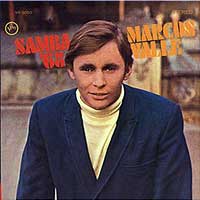 Nachdem 1966 der Organist Walter Wanderley seinen "Summer
Samba" (auch bekannt als "So Nice", kennt jeder aus meiner
Generation und der davor!) zum Hit in den USA machte, bekam auch der Autor
Marcos Valle dort seine Chancen als Interpret. "Samba '68"
ist nach meinem Wissensstand bereits das zweite US-Album, durchgÃĪngig
in Englisch gesungen, mit einer Neuauflage vom "Summer Samba".
Ein guter Einstieg in Valles Musik fÞr Leute, die ansonsten vielleicht
wenig mit brasilianischer Popmusik anfangen kÃķnnen.
Nachdem 1966 der Organist Walter Wanderley seinen "Summer
Samba" (auch bekannt als "So Nice", kennt jeder aus meiner
Generation und der davor!) zum Hit in den USA machte, bekam auch der Autor
Marcos Valle dort seine Chancen als Interpret. "Samba '68"
ist nach meinem Wissensstand bereits das zweite US-Album, durchgÃĪngig
in Englisch gesungen, mit einer Neuauflage vom "Summer Samba".
Ein guter Einstieg in Valles Musik fÞr Leute, die ansonsten vielleicht
wenig mit brasilianischer Popmusik anfangen kÃķnnen.
(03.02.2013)

 Mehr ...
Mehr ...
Samba '68 is a vibrant set of Brazilian pop, indebted to bossa nova and samba but undeniably Americanized for a domestic audience. The result is a joyous album throughout that wears its dated sound quite well. Valle interprets eleven of his own songs, including Brazilian standards like "Chup Chup, I Got Away," "Batucada" and "So Nice (Summer Samba)," as well as new tracks like "Crickets Sing for Anamaria" and "The Answer." The vocal harmonies of his wife (the Anamaria of the song title) provide a beautiful counterpoint to Valle's voice on several tracks, making Samba '68 one of the best Brazilian crossovers of the 1960s.
(by John Bush, All Music Guide)
|
| Antonio Carlos Jobim: "Wave" (A&M/CTI, Okt. 1967) |
 Der
Bossa Nova-Boom in den USA und anderen Gegenden auÃerhalb Brasiliens war
eigentlich schon vorbei (z.B. "Getz/Gilberto"
von 1963 mit dem "Girl From Ipanema"), aber gelegentlich wurden
noch solche Klassealben wie dieses vom Komponisten der meisten Bossa-Klassiker
verÃķffentlicht. Den Titelsong "Vou Te Contar" (portugiesisch
fÞr "Wave") sollte eigentlich jeder kennen, der sich ein
bisschen mit Jazz bzw. "Easy Listening" beschÃĪftigt hat.
Beim ersten HÃķren sind vielleicht die zuckersÞÃen Geigen von Arrangeur
Claus Ogermann (ein Deutscher in den USA) fÞr die Ohren von
Rock/Pop-HÃķrern -vorsichtig ausgedrÞckt- gewÃķhnungsbedÞrftig,
waren aber damals fÞr viele "leichte" Jazz-Produktionen,
gerade auch auf dem Label CTI des sehr dominanten Produzenten Creed
Taylor, sehr typisch. Und kriegen die tollen Songs von Tom Jobim natÞrlich
nicht kaputt. AuÃerdem spielen solche Topjazzleute in der Band wie Ron
Carter am Kontrabass oder Dom Um Romao am Schlagzeug, die eigentlich
Þber jeder Kritik erhaben sind. Der
Bossa Nova-Boom in den USA und anderen Gegenden auÃerhalb Brasiliens war
eigentlich schon vorbei (z.B. "Getz/Gilberto"
von 1963 mit dem "Girl From Ipanema"), aber gelegentlich wurden
noch solche Klassealben wie dieses vom Komponisten der meisten Bossa-Klassiker
verÃķffentlicht. Den Titelsong "Vou Te Contar" (portugiesisch
fÞr "Wave") sollte eigentlich jeder kennen, der sich ein
bisschen mit Jazz bzw. "Easy Listening" beschÃĪftigt hat.
Beim ersten HÃķren sind vielleicht die zuckersÞÃen Geigen von Arrangeur
Claus Ogermann (ein Deutscher in den USA) fÞr die Ohren von
Rock/Pop-HÃķrern -vorsichtig ausgedrÞckt- gewÃķhnungsbedÞrftig,
waren aber damals fÞr viele "leichte" Jazz-Produktionen,
gerade auch auf dem Label CTI des sehr dominanten Produzenten Creed
Taylor, sehr typisch. Und kriegen die tollen Songs von Tom Jobim natÞrlich
nicht kaputt. AuÃerdem spielen solche Topjazzleute in der Band wie Ron
Carter am Kontrabass oder Dom Um Romao am Schlagzeug, die eigentlich
Þber jeder Kritik erhaben sind.
Platz92im Rolling Stone!
|
| Tamba 4: "We Are The Sea" (A&M/CTI, 1967) |
 Bisher
bekannt als Tamba Trio ist das hier anscheinend die Premiere als
Quartett beim US-Label CTI von Produzent Creed Taylor. Zu Pianist
Luiz Eca, Bassist/FlÃķtist Bebeto und Trommler Rubens
Ohana kam noch Bassist/Gitarrist Donio Ferreira hinzu. Im perfekten
Rudy-van-Gelder-Klang wird eine wunderbare Mischung aus Jazz und
Bossa Nova, Gesangs- und InstrumentalstÞcken, geboten. Die Vinylausgabe
habe ich vor wenigen Tagen zu einem unverschÃĪmt gÞnstigen Kurs
im Copacabana-Laden in NÞrnberg entdeckt. Bisher
bekannt als Tamba Trio ist das hier anscheinend die Premiere als
Quartett beim US-Label CTI von Produzent Creed Taylor. Zu Pianist
Luiz Eca, Bassist/FlÃķtist Bebeto und Trommler Rubens
Ohana kam noch Bassist/Gitarrist Donio Ferreira hinzu. Im perfekten
Rudy-van-Gelder-Klang wird eine wunderbare Mischung aus Jazz und
Bossa Nova, Gesangs- und InstrumentalstÞcken, geboten. Die Vinylausgabe
habe ich vor wenigen Tagen zu einem unverschÃĪmt gÞnstigen Kurs
im Copacabana-Laden in NÞrnberg entdeckt.
(30.06.2013) |
| "Frank Albert Sinatra & Antonio Carlos Jobim" (Reprise, 1967) |
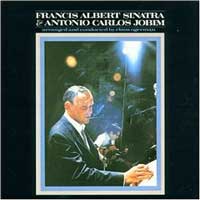 Meine erste Sinatra-Platte - und sehr wahrscheinlich nicht meine letzte!
Die Stimme von FrÃĪnkieboy und die Songs von Tom
(der auch ein bisschen mitsingt) - zusammen unschlagbar.
Meine erste Sinatra-Platte - und sehr wahrscheinlich nicht meine letzte!
Die Stimme von FrÃĪnkieboy und die Songs von Tom
(der auch ein bisschen mitsingt) - zusammen unschlagbar.

 Mehr ...
Mehr ...
|
"Das Talent des brasilianischen Musikers Antonio Carlos
Jobim wurde der Welt im Jahre 1959 offenbart, als er und Luis Bonfa die
Musik zu dem Film Orfeo Negro komponierten. Titel wie "A Felicidade"
und "Desafinado" riefen die Bossa-Nova-Bewegung der frühen
60er hervor, die zum Beispiel auch Stan Getz, Charlie Byrd und Miles Davis
inspirierte. Auf diesem Album findet man Jobim und Sinatra, die zusammen
Stücke wie "The Girl From Ipanema" und "How Insensitive"
singen.
Drei Standards -- "Change Partners" von Irving Berlin, "I
Concentrate On You" von Cole Porter und "Baubles, Bangles, And
Beads" von Robert Wright, George Forrest und Alexander Borodin --
runden das Programm der sieben Jobim Stücke ab. Diese CD bietet einen
wunderbaren Einblick in lateinamerikanische Melodien und Rhythmen, die
von zwei Meistern des lockeren Swings dargeboten werden." (Stanley
Booth, Amazon.de)
"Das kühlste und zugleich kürzeste Album
Sinatras ist das von Claus Ogerman arrangierte Treffen "Francis Albert
Sinatra & Antonio Carlos Jobim". Die superben Bearbeitungen Ogermans
bilden den idealen Rahmen für das elegante Songmaterial, das vorwiegend
aus der Feder des brasilianischen Erfolgskomponisten Jobim stammt, der
auch als Sänger mitwirkt." (Stereoplay)
|
|
| "Quarteto Novo" (EMI/Odeon, 1967) |
 Dieses Album, das einzige der Band, kann man als eines der wichtigsten
brasilianischen Jazzalben bezeichnen - auch wenn es nicht purer Jazz ist,
sondern eine damals vÃķllig neue oder zumindest eigenstÃĪndige
Mischung aus typischen brasilianischer Musik (Bossa Nova, Samba, etc.)
und nordamerikanischem Jazz. Zwei der beteiligten Musiker erlangten danach
Weltruhm: zu Perkussionist Airto Moreira muss man nicht mehr viel
sagen. Multinstrumentalist Hermeto Pascoal begeistert
hier "nur" auf der QuerflÃķte und mit gelegentlichem Pianospiel.
Dazu kommen die beiden Gitarristen Theo de Barros (auch am Kontrabass
zu hÃķren) und Heraldo do Monte, Þber die ich aber weiter
nichts weiÃ.
Dieses Album, das einzige der Band, kann man als eines der wichtigsten
brasilianischen Jazzalben bezeichnen - auch wenn es nicht purer Jazz ist,
sondern eine damals vÃķllig neue oder zumindest eigenstÃĪndige
Mischung aus typischen brasilianischer Musik (Bossa Nova, Samba, etc.)
und nordamerikanischem Jazz. Zwei der beteiligten Musiker erlangten danach
Weltruhm: zu Perkussionist Airto Moreira muss man nicht mehr viel
sagen. Multinstrumentalist Hermeto Pascoal begeistert
hier "nur" auf der QuerflÃķte und mit gelegentlichem Pianospiel.
Dazu kommen die beiden Gitarristen Theo de Barros (auch am Kontrabass
zu hÃķren) und Heraldo do Monte, Þber die ich aber weiter
nichts weiÃ.
(04.11.2008)

 Mehr ...
Mehr ...
|
The sole album by the legendary Quarteto Novo was released by the Odeon label in 1967 and was accorded various coveted Brazilian artistic prizes, including the Troféu Roquette Pinto and the Troféu Imprensa. The band was made up of four now legendary Brazilian musicians: percussionist Airto Moreira; bassist, guitarist, and violinist Theo de Barros; guitarist, violinist, violist, and sometimes banjo player Heraldo do Monte (these three musicians all being members of the previous Trio Novo); and later arrival Hermeto Pascoal. Coming from the northeastern part of the nation, all of these men were intimately familiar with baião music, the danceable rhythmic style comprised of a syncopated 2/4 time signature that could be played on the double-skinned zabumba drum and harmonic and melodic structures written around a Lydian flat seventh scale; it is derived from the tuning of the pífano flute, which has a raised fourth and flattened seventh. The chord structure is based on a dominant seventh. And while the style is not well-known outside Brazil, it nonetheless influenced a host of popular songwriters in America, England, and Europe, who scored hits with tunes utilizing the style's elements. (A couple of examples are the Burt Bacharach tune "Do You Know the Way to San Jose?" and "Save the Last Dance for Me," written by Doc Pomus and Mort Schulman and recorded by the Drifters.) Quarteto Novo and their patron and songwriting collaborator Geraldo Vandré had a deep, some would say obsessional, interest in American bebop; combine them and you have something very special indeed. Though in many ways, these eight songs sound somewhat quaint to undisciplined in the 21st century, the opposite is actually quite true. This meld of styles and the deep interest in subtle yet innovative rhythmic interplay, counterpoint, and taut song structures are to this day quite revolutionary.
The soulfulness at the heart of this music is a far cry from the breeziness of bossa nova, and there are no lyrics. Instead, on tunes like "Fica Mal com Deus," a 12-string guitar, a nylon-string guitar, and the pífano flute of Pascoal all enter in a head line like a bop composition. Within a chorus, the flute moves to a different melody, guitars accent two different parts of the rhythm, and Airto allows timekeeping and rhythmic invention to flow toward the melody instead of framing its outside. The listener is completely caught up in the joy and drama of the tune this also goes for the much more intricate and haunting "Canto Geral," which begins much more slowly but quickly weaves a pair of melodic intricacies together and frames them with a samba feel, which is stretched and cast off as three voices wordlessly create a third melody in the middle as a bridge, followed by a minor seventh interlude that is utterly forlorn before the pastoral open country feel returns. Amazing! The set closes with the popping "Vim de Sant'Ana," where piano, double bass, nylon-string guitars, and Airto's percussion magic are woven inseparably with a contrapuntal Wes Montgomery swinging soul-styled melody. Over its five minutes the track changes considerably, moving from one mode to another with seamless transitions until the listener is left breathless by its end. This record is difficult to find at times, and keeps getting reissued on CD in small batches. Look for it. One can hear so many things in this music that deserve a place on the sacred shelf. One can think of producers like Creed Taylor and his original idea for CTI and know he heard this music; one can hear the very foundation of Egberto Gismonti's music inside this record; and it can also be credited with much of the killer '70s jazz and Brazilian fusions that occurred on records by everyone from Joe Farrell and Chick Corea to Gary Burton and Freddie Hubbard. And then there are those brilliant albums by Airto, Dom Um Romão, Flora Purim, and so many others that came directly from the sounds displayed here so generously and ingeniously.
(by Thom Jurek, All Music Guide)
|
|
| Sergio Mendes & Brasil 66: "Equinox" (A&M, 1967) |
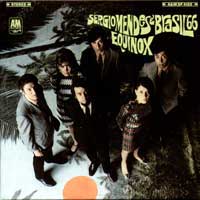
Ist das Jazz? Bossa Nova? Oder bloà "Easy Listening"? VÃķllig egal!
Ich habe an diesen "Cocktail-Sound" noch ganz lebhafte Kindheitserinnerungen:
Ich hatte als kleiner Bub immer die kostenlose Fernsehzeitschrift bei
Radio Neu am Friedrichsfelder Marktplatz abgeholt, worin auch
immer eine Hitparade zu finden war, in der immer zu viel James Last
und Freddie Quinn und zu wenig Beatles vorkamen, aber
eben auch dieser Mr. Mendes, der mir damals natÞrlich Þberhaupt
nichts sagte. Vor ein paar Jahren entdeckte ich dann auf dem Soundtrack
"I Shot Andy Warhol" das Lied "Mais Que Nada", von
dem ich mal behaupte, dass es wohl jeder aus meiner und der Generation
davor kennen mÞsste. Schnell habe ich mir dann den Sampler "Foursider"
besorgt, auf dem Beatles-, Buffalo Springfield- und Joni Mitchell-Songs
ein Cocktail-Jazz-Gewand verpasst bekamen und manche Bossa-Nova-Klassiker
(viel von Tom Jobim, aber eben auch Jorge
Bens "Mais Que Nada") dem nordamerikanischen/europÃĪischen
Publikum nÃĪher gebracht wurden.
Und jetzt habe ich mir das 2. Album der Band als WiederverÃķffentlichung
in der Verve-Jazzserie mit einem wunderschÃķnen, der alten A&M-LP
nachempfundenen Pappcover besorgt. Die Band (auÃer Sergio noch drei
Musiker an Bass, Schlagzeug und Perkussion und zwei SÃĪngerinnen)
macht auf dem Cover doch wohl einen extrem coolen Eindruck, nicht war?
Man hat fast den Eindruck, hier wÞrde der Zustand des "Coolseins"
gerade erfunden. Und entsprechend ist auch die Musik!
(14.02.2004)

 Mehr ...
Mehr ...
"Maybe, and thats really saying something. After he
founded Brasil 66, a number of critics and others accused him of selling
out to the pop music market, but honestly, I think the mix in this album
of jazz/pop/Brasilian music in this album is probably about 40/30/30. Mendes
plays a mean jazz piano, and his blocky piano chords sound like Vince Guaraldi
backed by a bossa nova beat.
Everything on this album works. The songs are wonderful and well chosen.
The arrangements sparkle. "Constant Rain" always makes me laugh
because the lyrics are so sad while the delivery is upbeat and cheerful.
On this album, Mendes temporarily dropped the Beatles cover songs and instead
chose Cole Porter "Night and Day" and Michel Legrands "Watch
What Happens." Theres also a trio of Jobim songs including one of the
first vocal versions of "Wave" (in Portugese) and some more obscure
but equally fine Brazilian tunes." (namenlos aus dem WWW) |
|
| Astrud Gilberto: "Beach Samba" (Verve, 1967) |
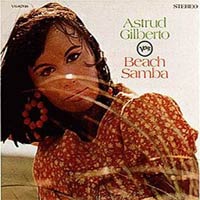 Das
"Girl From Ipanema" darf hier natÞrlich nicht fehlen. Kann sein,
dass das hier nicht ihr bestes Album ist, aber ich hab es und ich mag
es sehr. Total kitschig, aber wunderbar. Mit dabei eine leicht abgefahrene
Version von Tim Hardins "Misty Roses". Das
"Girl From Ipanema" darf hier natÞrlich nicht fehlen. Kann sein,
dass das hier nicht ihr bestes Album ist, aber ich hab es und ich mag
es sehr. Total kitschig, aber wunderbar. Mit dabei eine leicht abgefahrene
Version von Tim Hardins "Misty Roses". |
| Wanda de Sah: "Softly!" (Capitol, Aug. 1965) |
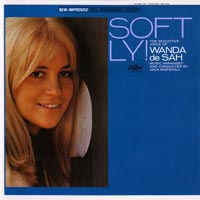 Ich gebe zu, dass mich die Optik und nicht die Musik auf die brasilianische
SÃĪngerin Wanda de Sah (spÃĪter nannte sie sich nur noch Wanda
SÃĄ), aufmerksam gemacht hat. Aber letztendlich ist es doch dieser
wunderbare Bossa Nova-Klang , der mich Þberzeugt hat. Dies ist ihr
US-SolodebÞt, nachdem sie bereits auf "Brasil
'65" vom Sergio Mendes Trio mitgewirkt hatte, meist in
englisch gesungen. FÞnf Lieder vom Meister Jobim.
Ich gebe zu, dass mich die Optik und nicht die Musik auf die brasilianische
SÃĪngerin Wanda de Sah (spÃĪter nannte sie sich nur noch Wanda
SÃĄ), aufmerksam gemacht hat. Aber letztendlich ist es doch dieser
wunderbare Bossa Nova-Klang , der mich Þberzeugt hat. Dies ist ihr
US-SolodebÞt, nachdem sie bereits auf "Brasil
'65" vom Sergio Mendes Trio mitgewirkt hatte, meist in
englisch gesungen. FÞnf Lieder vom Meister Jobim.
(04.12.2008)

 Mehr ...
Mehr ...
|
Although she was already a veteran songwriter and recording artist, Wanda de Sah was pegged as "the new thing" by American marketing executives during her stint in Sergio Mendes' first pop incarnation, Brazil '65. Although that group wasn't popular it was actually a new collective, Brazil '66, that gained fame she was soon signed by Capitol for a record and assigned to arranger Jack Marshall (who had played guitar on many sessions and written the chart for Peggy Lee's "Fever" as well as The Munsters theme). The material came from the Brazilian songbook, at least the parts of it already familiar to Americans (including some Brazil '65 songs as well as Jobim and Getz/Gilberto standards). Although Astrud Gilberto is a touchpoint for Wanda de Sah, she didn't have the same candle power; her singing is more subdued and slightly more intricate, but no more melodic or winsome. The arrangements are about as good as could be expected from a Capitol studio group in the mid-'60s cool and professional, and surprisingly in-tune with the Brazilian "touch.
(by John Bush, All Music Guide)
|
|
| The Sergio Mendes Trio feat. Wanda de Sah: "Brasil '65" (Capitol, Mai 1965) |
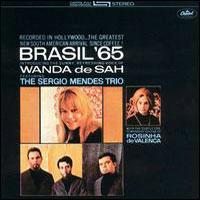 Dieses
Album stellt quasi den (noch nicht ganz so erfolgreichen Prototypen fÞr
Sergion Mendes & Brasil '66 dar. Mit dabei neben seinen beiden Begleitern
aus dem Jazztrio (Bassist Sebastiano Neto und Schlagzeuger Chico
Batera) sind die SÃĪngerin Wanda de Sah, die
Gitarristin Rosinha de Valencia und der amerikanische Saxofonist
und FlÃķtist Bud Shank. Dieses
Album stellt quasi den (noch nicht ganz so erfolgreichen Prototypen fÞr
Sergion Mendes & Brasil '66 dar. Mit dabei neben seinen beiden Begleitern
aus dem Jazztrio (Bassist Sebastiano Neto und Schlagzeuger Chico
Batera) sind die SÃĪngerin Wanda de Sah, die
Gitarristin Rosinha de Valencia und der amerikanische Saxofonist
und FlÃķtist Bud Shank. |
| Stan Getz/Joao Gilberto: "Getz/Gilberto" (Verve, Okt. 1963) |
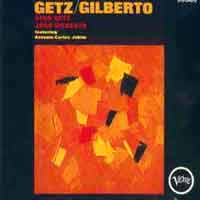 Diese
Platte war damals ein echtes Ereignis: zum ersten mal kam es vor einer breiten
Ãffentlichkeit zur Verbindung von Jazz und Bossa Nova. Der US-amerikanische
Saxofonist Stan Getz und der brasilianische SÃĪnger und Gitarrist
Joao Gilberto schufen eine wunderbare Kombination dieser beiden
Welten. Unverzichtbar dabei der brasilianische Komponist und Pianist Antonio
Carlos Jobim, dessen Lieder den BÃĪrenanteil des Albums ausmachen:
"Girl From Ipanema", "Corcovado", "Desafinado"
und weitere. "Ipanema" wurde sogar zum Welthit und prÃĪsentiert
als Besonderheit Joao Gilbertos Ehefrau Astrud Gilberto,
damals eigentlich keine professionelle SÃĪngerin, die nur gebeten
wurde, Jobims portugiesische Texte als Demo in englisch zu singen, da
ihr Mann die englische Sprache nicht beherrschte. Das Ergebnis war so
Þberzeugend, dass ihr Gesang fÞr "Ipanema" und ein
anderes Lied in der Endversion belassen wurden. Leider hat man fÞr
die gekÞrzte Singleversion sogar Joao´s portugiesisch gesungene
Strophen herausgeschnitten, wodurch "Ipanema" alleine zu Astruds
Hit wurde! Diese
Platte war damals ein echtes Ereignis: zum ersten mal kam es vor einer breiten
Ãffentlichkeit zur Verbindung von Jazz und Bossa Nova. Der US-amerikanische
Saxofonist Stan Getz und der brasilianische SÃĪnger und Gitarrist
Joao Gilberto schufen eine wunderbare Kombination dieser beiden
Welten. Unverzichtbar dabei der brasilianische Komponist und Pianist Antonio
Carlos Jobim, dessen Lieder den BÃĪrenanteil des Albums ausmachen:
"Girl From Ipanema", "Corcovado", "Desafinado"
und weitere. "Ipanema" wurde sogar zum Welthit und prÃĪsentiert
als Besonderheit Joao Gilbertos Ehefrau Astrud Gilberto,
damals eigentlich keine professionelle SÃĪngerin, die nur gebeten
wurde, Jobims portugiesische Texte als Demo in englisch zu singen, da
ihr Mann die englische Sprache nicht beherrschte. Das Ergebnis war so
Þberzeugend, dass ihr Gesang fÞr "Ipanema" und ein
anderes Lied in der Endversion belassen wurden. Leider hat man fÞr
die gekÞrzte Singleversion sogar Joao´s portugiesisch gesungene
Strophen herausgeschnitten, wodurch "Ipanema" alleine zu Astruds
Hit wurde!
Platz70im Rolling Stone!
|
| Vinicius de Moraes & Odette Lara:"Vinicius & Odette Lara" (Elenco, 1963) |
 Ein Meisterwerk des Bossa Nova. Das Songschreiberteam Vinicius de Moraes
und Baden Powell liefert hier bei ihrer ersten Zusammenarbeit solche
Klassiker wie "Berimbau" und "Deixa".
Ein Meisterwerk des Bossa Nova. Das Songschreiberteam Vinicius de Moraes
und Baden Powell liefert hier bei ihrer ersten Zusammenarbeit solche
Klassiker wie "Berimbau" und "Deixa".
(13.01.2009)

 Mehr ...
Mehr ...
The poet/performer Vinicius de Moraes and the vocalist Odette Lara make a wonderful team, and
though their voices aren't heard together as much as they should be here, Vinicius & Odette
Lara is a warm, inviting collection. The dozen songs are all originals by de Moraes and old
friend Baden Powell, who also appears as a musician and usually present Lara and de Moraes
trading lines, or Lara taking the verses while de Moraes handles choruses. The breathtaking
"Samba Preludio" is one of the few actual duets; after a preface featuring a mournful de Moraes
over a sawing cello, Lara sings a few lines alone as well before the pair's voices intertwine
(even while they sing different lines). Moacyr Santos' arrangements range from Brazilian bossa
to string orchestra pop to anthemic soul-jazz, with plenty of trumpet and flute as well as a
warm cocktail piano and the usual sewing machine bossa percussion. On "Deve se Amor," playful
reeds and high-note trumpet accent a smooth, powerful vocal by Lara. It's a bit disconcerting
to hear a Brazilian vocal album without recognizing at least one standard, but Vinicius & Odette
Lara is a challenging, entertaining work of jazzy Brazilian pop.
(by John Bush, All Music Guide)
It was a different century, a different world. In 1963, a poet and an actress could open a label
(hat a responsibility!), singing song from a rand-new partnership, with arrangements from a
complete stranger, and create a classic. The poet was Vinicius de Moraes, and the actress was
Odette Lara, veterans of thousand musical nights. The new partnership was Baden Powell and
Vinicius de Moraes, with born standards like Deixa, Astronauta and Berimbau.
The arranger was none other than Moacir Santos. The Label was Elenco. Today we know that it
couldn't have gone wrong.
(Ruy Castro, liner notes)
|
| Luiz Bonfa: "Plays And Sings Bossa Nova" (Verve, 1963) |
 Vielleicht
nicht so bekannt wie Antonio Carlos Jobim ist
Luiz Bonfa aber trotzdem einer der wichtigsten Vertreter dieser
damals absolut trendmÃĪÃigen Musik aus Brasilien. Sowohl als SÃĪnger,
aber vor allem als Gitarrist, glÃĪnzt er hier. Am bekanntesten sind
wohl seine Kompositionen fÞr den Spielfilm "Black Orpheus"
von 1959: den "Samba De Orfeu" (hier leider nicht vertreten)
kennt garantiert jeder von Euch! Vielleicht
nicht so bekannt wie Antonio Carlos Jobim ist
Luiz Bonfa aber trotzdem einer der wichtigsten Vertreter dieser
damals absolut trendmÃĪÃigen Musik aus Brasilien. Sowohl als SÃĪnger,
aber vor allem als Gitarrist, glÃĪnzt er hier. Am bekanntesten sind
wohl seine Kompositionen fÞr den Spielfilm "Black Orpheus"
von 1959: den "Samba De Orfeu" (hier leider nicht vertreten)
kennt garantiert jeder von Euch! |
| Joao Gilberto: "Chega De Saudade" (Odeon, 1959) |
 Eines
der frÞhen Meisterwerke der Bossa Nova, das bereits zahlreiche Klassiker
des Genres enthÃĪlt, z.B. "Desafinado", "Felicidade"
und den Titelsong aus der Feder von Antonio Carlos Jobim,
"Manha De Carneval" von Luis Bonfa und
die eigenen Titel "Bim Bom" und "Ho Ba La La". Eines
der frÞhen Meisterwerke der Bossa Nova, das bereits zahlreiche Klassiker
des Genres enthÃĪlt, z.B. "Desafinado", "Felicidade"
und den Titelsong aus der Feder von Antonio Carlos Jobim,
"Manha De Carneval" von Luis Bonfa und
die eigenen Titel "Bim Bom" und "Ho Ba La La".
(24.03.2013)
Platz4im Rolling Stone!
|


 Mehr ...
Mehr ...

 Mehr ...
Mehr ...

 Mehr ...
Mehr ...

 Mehr ...
Mehr ...

 Mehr ...
Mehr ...

 Mehr ...
Mehr ...
 Diesen Musiker aus Brasilien habe ich erst vor wenigen Monaten fÞr mich entdeckt: eigentlich
mÞsste ich sagen: nett gemacht, aber das klingt ja alles wie bei Steely Dan!,
aber wenn ich in mich hineinhÃķre, dann bin ich total begeistert von dieser brasilianischen Transzendierung
der Kunst von Walter Becker & Donald Fagen. Ich freue mich schon kolossal auf das Konzert im November!
Diesen Musiker aus Brasilien habe ich erst vor wenigen Monaten fÞr mich entdeckt: eigentlich
mÞsste ich sagen: nett gemacht, aber das klingt ja alles wie bei Steely Dan!,
aber wenn ich in mich hineinhÃķre, dann bin ich total begeistert von dieser brasilianischen Transzendierung
der Kunst von Walter Becker & Donald Fagen. Ich freue mich schon kolossal auf das Konzert im November! Mehr ...
Mehr ...
 Fast zeitgleich mit Schlagzeuger Domenico Lancellotti hat auch Bassist
Alexandre Kassin, sein alter Bandkumpan aus "+2"-Tagen, sein neues Album bei
David Byrnes Label verÃķffentlicht ...
Fast zeitgleich mit Schlagzeuger Domenico Lancellotti hat auch Bassist
Alexandre Kassin, sein alter Bandkumpan aus "+2"-Tagen, sein neues Album bei
David Byrnes Label verÃķffentlicht ... Mehr ...
Mehr ...
 Ein virtuoss und spannendes Jazzquintett aus Brasilien! Statt der bei normalen JazzfÞnfern
Þblichen Frontline bestehend aus Tenorsaxofon und Trompete gibt es hier die 10saitige Mandoline
des Bandleaders und die virtuose chromatische Mundharmonika von Gabriel Grossi zu
hÃķren. Das Fundament darunter legen eine typisch brasilianische Bossa-Nova-Gitarre, sowie Schlagzeug und E-Bass.
Die Lieder stammen natÞrlich alle vom legendÃĪren Milton Nascimento,
der auch als singender Gast vorbeigeschaut hat. Das alles wurde vom ebenfalls legendÃĪren
MPS-Label aus dem Schwarzwald verÃķffentlicht. Ach ja - die CD kommt mit einer DVD daher,
auf der alle (?) Titel auch als Livemitschnitte aus dem Studio zu sehen und zu hÃķren sind.
Ein virtuoss und spannendes Jazzquintett aus Brasilien! Statt der bei normalen JazzfÞnfern
Þblichen Frontline bestehend aus Tenorsaxofon und Trompete gibt es hier die 10saitige Mandoline
des Bandleaders und die virtuose chromatische Mundharmonika von Gabriel Grossi zu
hÃķren. Das Fundament darunter legen eine typisch brasilianische Bossa-Nova-Gitarre, sowie Schlagzeug und E-Bass.
Die Lieder stammen natÞrlich alle vom legendÃĪren Milton Nascimento,
der auch als singender Gast vorbeigeschaut hat. Das alles wurde vom ebenfalls legendÃĪren
MPS-Label aus dem Schwarzwald verÃķffentlicht. Ach ja - die CD kommt mit einer DVD daher,
auf der alle (?) Titel auch als Livemitschnitte aus dem Studio zu sehen und zu hÃķren sind.
 Mehr ...
Mehr ...
 Etwas verwirrend ist fÞr mich, ob das neue Album "The Good Is A Big God" des
brasilianischen Schlagzeugers, SÃĪngers und Songschreibers Domenico (der Nachname blieb
bei bisherigen VerÃķffentlichungen weg) wirklich neu ist.
Neben dieser Ausgabe auf dem Label von Ex-Talking Head David Byrne gab es mit anderem
Titel (auf Portugisisch) und leicht geÃĪndertem Cover schon eine Version in Brazilien und Japan (!) im letzten Sommer.
Im Grunde kann uns das aber egal sein, denn (1.) gibt es jetzt wohl erstmalig eine Vinylausgabe
und (2.) beziehen sich beide Alternativtitel jeweils auf unterschiedliche Lieder der gleichen Platte,
die eben in Portugisisch oder in Englisch gesungen sind.
Etwas verwirrend ist fÞr mich, ob das neue Album "The Good Is A Big God" des
brasilianischen Schlagzeugers, SÃĪngers und Songschreibers Domenico (der Nachname blieb
bei bisherigen VerÃķffentlichungen weg) wirklich neu ist.
Neben dieser Ausgabe auf dem Label von Ex-Talking Head David Byrne gab es mit anderem
Titel (auf Portugisisch) und leicht geÃĪndertem Cover schon eine Version in Brazilien und Japan (!) im letzten Sommer.
Im Grunde kann uns das aber egal sein, denn (1.) gibt es jetzt wohl erstmalig eine Vinylausgabe
und (2.) beziehen sich beide Alternativtitel jeweils auf unterschiedliche Lieder der gleichen Platte,
die eben in Portugisisch oder in Englisch gesungen sind. Mehr ...
Mehr ...
 Ob jetzt Psychedelic Samba der passende Oberbegriff fÞr all die
tollen Bands und Einzelinterpretren auf dieser Zusammenstellung ist, das sei mal dahingestellt.
Mir bekannt war bisher auf jeden Fall nur Marcus Valle, der es mit seinem Lied leider
nicht auf die mit knapp Þber 12⎠recht gÞnstige Schallplatte, sondern nur auf die CD-Ausgabe geschafft
hat. Besonders gut gefiel mir noch die Band Sexy Fi, von der ich mir umgehend das
komplette Album besorgt habe ...
Ob jetzt Psychedelic Samba der passende Oberbegriff fÞr all die
tollen Bands und Einzelinterpretren auf dieser Zusammenstellung ist, das sei mal dahingestellt.
Mir bekannt war bisher auf jeden Fall nur Marcus Valle, der es mit seinem Lied leider
nicht auf die mit knapp Þber 12⎠recht gÞnstige Schallplatte, sondern nur auf die CD-Ausgabe geschafft
hat. Besonders gut gefiel mir noch die Band Sexy Fi, von der ich mir umgehend das
komplette Album besorgt habe ... Der
Titel sagt eigentlich alles ...
Der
Titel sagt eigentlich alles ... Der Sohn von Caetano Veloso mit seinem ersten
"echten" Soloalbum auf dem Label von David Byrne, nachdem
er zuvor mit der Band "+2" (Bassist Alexandre
Kassin und Schlagzeuger Domenico Lancelloti)
drei Alben verÃķffentlicht hatte, jeweils unter dem Namen eines der
drei Beteiligten (Moreno +2, Domenico +2
und Kassin +2).
Der Sohn von Caetano Veloso mit seinem ersten
"echten" Soloalbum auf dem Label von David Byrne, nachdem
er zuvor mit der Band "+2" (Bassist Alexandre
Kassin und Schlagzeuger Domenico Lancelloti)
drei Alben verÃķffentlicht hatte, jeweils unter dem Namen eines der
drei Beteiligten (Moreno +2, Domenico +2
und Kassin +2). Mehr ...
Mehr ...
 Rodrigo Amarante war mal bei der brasilianischen Rockband Los
Hermanos, ging dann in die USA, spielte dort mit Strokes-Drummer
Fabrizio Moretti und Binky
Shapiro unter dem Bandnamen Little
Joy ein Album ein und war als Begleiter von Devendra
Banhart unterwegs. Dies ist, soweit ich weiÃ, sein SolodebÞt,
aufgenommen in seiner neuen Wahlheimat. Die Coverabbildung ist Þbrigenz
kein Irrtum: das ist einfach das, was man sonst auf der InnenhÞlle
einer Platte findet. Das Optische kann man mÃķgen ...
das Musikalische muà man lieben, denn es bringt vÃķllig
eigenstÃĪndig das Beste aus Brasilien und Indie-Folk zusammen.
Rodrigo Amarante war mal bei der brasilianischen Rockband Los
Hermanos, ging dann in die USA, spielte dort mit Strokes-Drummer
Fabrizio Moretti und Binky
Shapiro unter dem Bandnamen Little
Joy ein Album ein und war als Begleiter von Devendra
Banhart unterwegs. Dies ist, soweit ich weiÃ, sein SolodebÞt,
aufgenommen in seiner neuen Wahlheimat. Die Coverabbildung ist Þbrigenz
kein Irrtum: das ist einfach das, was man sonst auf der InnenhÞlle
einer Platte findet. Das Optische kann man mÃķgen ...
das Musikalische muà man lieben, denn es bringt vÃķllig
eigenstÃĪndig das Beste aus Brasilien und Indie-Folk zusammen. Mehr ...
Mehr ...
 Diese Band um die SÃĪngerin Camilla Zamith und den Gitarristen und Produzenten Praxis
habe ich kÞrzlich auf der spannenden Kompilation "The Rough Guide To Psychedelic Samba"
vom englischen Label World Music Network entdeckt und wurde sofort hellhÃķrig.
Weil das scheinbar einzige Album der Band ebenfalls als CD fÞr kleines Geld zu ordern war habe ich schnell
zugegriffen und bin jetzt sehr angetan: Indie-Rock meets MÚsica Popular Brasileira.
Ach ja - aufgenommen wurde das Album in Chicago von John McEntire von der Band The Sea & Cake,
deren Sound ja gar nicht so weit weg von dem hier ist. Oder umgekehrt? Anyway!
Diese Band um die SÃĪngerin Camilla Zamith und den Gitarristen und Produzenten Praxis
habe ich kÞrzlich auf der spannenden Kompilation "The Rough Guide To Psychedelic Samba"
vom englischen Label World Music Network entdeckt und wurde sofort hellhÃķrig.
Weil das scheinbar einzige Album der Band ebenfalls als CD fÞr kleines Geld zu ordern war habe ich schnell
zugegriffen und bin jetzt sehr angetan: Indie-Rock meets MÚsica Popular Brasileira.
Ach ja - aufgenommen wurde das Album in Chicago von John McEntire von der Band The Sea & Cake,
deren Sound ja gar nicht so weit weg von dem hier ist. Oder umgekehrt? Anyway! Mehr ...
Mehr ...

 Mehr ...
Mehr ...

 Mehr ...
Mehr ...
 Bereits
das zweite Studioalbum der legendÃĪren brasilianischen Band nach dem
Live-Comeback von 2007. Sicherlich ein
blÃķdes Wortspiel im Titel und gewÃķhnungsbedÞrftiges Cover,
aber mit toller Musik, irgendwo zwischen Progrock, Hardrock und brasilianischer
Leichtigkeit. Erstmalig (bis auf eine Ausnahme, dem Gilberto Gil-Cover
"Eu Descobri") wird auf Englisch gesungen, was mir aber vÃķllig
egal ist. Sergio Dias ist ein wahrer Meister an der Gitarre, der
es hier auf intelligente Art und Weise krachen lÃĪsst.
Bereits
das zweite Studioalbum der legendÃĪren brasilianischen Band nach dem
Live-Comeback von 2007. Sicherlich ein
blÃķdes Wortspiel im Titel und gewÃķhnungsbedÞrftiges Cover,
aber mit toller Musik, irgendwo zwischen Progrock, Hardrock und brasilianischer
Leichtigkeit. Erstmalig (bis auf eine Ausnahme, dem Gilberto Gil-Cover
"Eu Descobri") wird auf Englisch gesungen, was mir aber vÃķllig
egal ist. Sergio Dias ist ein wahrer Meister an der Gitarre, der
es hier auf intelligente Art und Weise krachen lÃĪsst.  Ein schweres 1o-Zoll-Doppelalbum des brasilianischen
Trommlers Domenico Lancelloti, Partner von Moreno
Veloso und Alexandre Kassin im Trio "+2".
Ein schweres 1o-Zoll-Doppelalbum des brasilianischen
Trommlers Domenico Lancelloti, Partner von Moreno
Veloso und Alexandre Kassin im Trio "+2". Mehr ...
Mehr ...
 Der Meister der brasilianischen Musik hat es mit Þber 70 Lenzen nicht
mehr nÃķtig, Erwartungen der Kundschaft zu erfÞllen (hatte er
das je?). Auf "Abraçaço" wird richtig gerockt,
zwar nicht mit fetten GitarrenwÃĪnden wie bei Hardrockern, sondern
eher mit frickeligen Sachen wie bei Indie-Rockern. Verantwortlich dafÞr
ist die junge (?) brasilianische Rockband Bandacê. Meist
hÃķrt man nur, fast schon spartanisch, die 4 Instrumente der Beiteiligten
(E-Gitarre, Bass, Schlagzeug und gelegentliche Keyboards der drei "Jungspunde"
und Caetanos Akustikgitarre). Selten klingt's nach gewohntem Bossa Nova.
(Und trotzdem?) Sehr gut. Produziert von seinem Sohn Moreno.
Der Meister der brasilianischen Musik hat es mit Þber 70 Lenzen nicht
mehr nÃķtig, Erwartungen der Kundschaft zu erfÞllen (hatte er
das je?). Auf "Abraçaço" wird richtig gerockt,
zwar nicht mit fetten GitarrenwÃĪnden wie bei Hardrockern, sondern
eher mit frickeligen Sachen wie bei Indie-Rockern. Verantwortlich dafÞr
ist die junge (?) brasilianische Rockband Bandacê. Meist
hÃķrt man nur, fast schon spartanisch, die 4 Instrumente der Beiteiligten
(E-Gitarre, Bass, Schlagzeug und gelegentliche Keyboards der drei "Jungspunde"
und Caetanos Akustikgitarre). Selten klingt's nach gewohntem Bossa Nova.
(Und trotzdem?) Sehr gut. Produziert von seinem Sohn Moreno. Mehr ...
Mehr ...

 Mehr ...
Mehr ...
 Der Bassist und Produzent Alexandre Kassin war mir bereits als
Partner von Moreno Veloso in der Band "+2"
bekannt. Sein SolodebÞt verbindet auf grandiose Weise Indierock,
Funk und Brasilien. Die VerÃķffentlichung auf Vinyl stammt Þbrigenz
vom Label von Damon & Naomi!
Der Bassist und Produzent Alexandre Kassin war mir bereits als
Partner von Moreno Veloso in der Band "+2"
bekannt. Sein SolodebÞt verbindet auf grandiose Weise Indierock,
Funk und Brasilien. Die VerÃķffentlichung auf Vinyl stammt Þbrigenz
vom Label von Damon & Naomi! Mehr ...
Mehr ...
 "Estatica" gab's letztens als Vinylausgabe fÞr relativ
wenig Geld beim Online-HÃĪndler meines Vertrauens und hÃĪlt mindestens
den Standard von "Escape", ist vielleicht
sogar noch besser. Witzig sind besonders drei Keyboard-InstrumentalstÞcke,
die "1975", "1985" und "1995" heissen und
offensichtlich den typischen (Keyboard-)Sound des jeweiligen Jahrzehnts
einfangen sollen. Alle drei sind gelungen, aber am besten gefÃĪllt
mir als altem Sack natÞrlich "1975". Mit dabei als Gast
an der Gitarre ist Marcelo Camelo von Los Hermanos,
von denen man leider schon lange nichts mehr vernommen hat.
"Estatica" gab's letztens als Vinylausgabe fÞr relativ
wenig Geld beim Online-HÃĪndler meines Vertrauens und hÃĪlt mindestens
den Standard von "Escape", ist vielleicht
sogar noch besser. Witzig sind besonders drei Keyboard-InstrumentalstÞcke,
die "1975", "1985" und "1995" heissen und
offensichtlich den typischen (Keyboard-)Sound des jeweiligen Jahrzehnts
einfangen sollen. Alle drei sind gelungen, aber am besten gefÃĪllt
mir als altem Sack natÞrlich "1975". Mit dabei als Gast
an der Gitarre ist Marcelo Camelo von Los Hermanos,
von denen man leider schon lange nichts mehr vernommen hat.  Mehr ...
Mehr ...

 Mehr ...
Mehr ...
 Das
zweite Album dieser fantastischen brasilianischen SÃĪngerin knÞpft
nahtlos an das titellose DebÞt von 2006
an: mit Bossa-, Jazz und Rock-Gitarren, ComputerklÃĪngen, alten Analog-Keyboards
(VIEL MELLOTRON!!!) und vor allem ihrem wunderbaren Gesang. Man kann das
Þbrigenz auch geniessen, wenn man kein Wort Portugiesisch versteht!
Das
zweite Album dieser fantastischen brasilianischen SÃĪngerin knÞpft
nahtlos an das titellose DebÞt von 2006
an: mit Bossa-, Jazz und Rock-Gitarren, ComputerklÃĪngen, alten Analog-Keyboards
(VIEL MELLOTRON!!!) und vor allem ihrem wunderbaren Gesang. Man kann das
Þbrigenz auch geniessen, wenn man kein Wort Portugiesisch versteht!
 Mehr ...
Mehr ...
 Irgendwie kommt mir das Cover vom neuen Album der Tochter von Joao
Gilberto bekannt vor ... Genau, es erinnert irgendwie an "Beach
Samba" von Joaos Ex-Frau Astrud Gilberto. Keine
Ahnung, was ich davon halten soll.
Irgendwie kommt mir das Cover vom neuen Album der Tochter von Joao
Gilberto bekannt vor ... Genau, es erinnert irgendwie an "Beach
Samba" von Joaos Ex-Frau Astrud Gilberto. Keine
Ahnung, was ich davon halten soll. Soundtechnisch,
qualitativ und stilistisch weicht das neue Album von Luciana Souza
nicht vom VorgÃĪnger "The New Bossa Nova"
von 2007 ab. Allerdings verzichtet sie inzwischen weitestgehend auf Fremdmaterial
bekannter Autoren und hat die Songs fast alle mit Ehemann, Produzent und
Bassist Larry Klein geschrieben. Eine kleine, feine CD.
Soundtechnisch,
qualitativ und stilistisch weicht das neue Album von Luciana Souza
nicht vom VorgÃĪnger "The New Bossa Nova"
von 2007 ab. Allerdings verzichtet sie inzwischen weitestgehend auf Fremdmaterial
bekannter Autoren und hat die Songs fast alle mit Ehemann, Produzent und
Bassist Larry Klein geschrieben. Eine kleine, feine CD.
 Ein weiteres Album, das den 50. Geburtstag von der Bossa Nova feiert:
wer kann das besser als Milton Nascimento, zusammen
mit dem Jobim Trio, das aus dem Sohn (Gitarrist Paulo
Jobim) und dem Enkel (Pianist Daniel Jobim)
von Antonio Carlos Jobim, sowie Schlagzeuglegende
Paulo Braga besteht? Akustische Bossa Nova mit starken
Jazzakzenten auf allerhÃķchstem Niveau und mit den allerbesten Songs.
Wenig Þberraschend stammen 8 von 14 Liedern vom Meister Antonio
Carlos Jobim, aber es sind eher unbekannte und unverbrauchte Sachen,
vielleicht mit der Ausnahme von "Chega De Sausade", dem ersten
Bossa-"Hit" von Joao Gilberto von 1958. Dazu
kommen weitere gute Lieder von Nascimento (u. a. vom legendÃĪren Album
"Clube Da Esquina" von 1972)
Ein weiteres Album, das den 50. Geburtstag von der Bossa Nova feiert:
wer kann das besser als Milton Nascimento, zusammen
mit dem Jobim Trio, das aus dem Sohn (Gitarrist Paulo
Jobim) und dem Enkel (Pianist Daniel Jobim)
von Antonio Carlos Jobim, sowie Schlagzeuglegende
Paulo Braga besteht? Akustische Bossa Nova mit starken
Jazzakzenten auf allerhÃķchstem Niveau und mit den allerbesten Songs.
Wenig Þberraschend stammen 8 von 14 Liedern vom Meister Antonio
Carlos Jobim, aber es sind eher unbekannte und unverbrauchte Sachen,
vielleicht mit der Ausnahme von "Chega De Sausade", dem ersten
Bossa-"Hit" von Joao Gilberto von 1958. Dazu
kommen weitere gute Lieder von Nascimento (u. a. vom legendÃĪren Album
"Clube Da Esquina" von 1972)
 Mehr ...
Mehr ...
 Die
SÃĪngerin Maria da Mata fiel mir zum ersten Mal auf der Bossa
Nova-Platte von Till BrÃķnner
auf. Auf ihrem eigenen Album geht es aber wesentlich moderner zur Sache
- auch nicht schlecht!
Die
SÃĪngerin Maria da Mata fiel mir zum ersten Mal auf der Bossa
Nova-Platte von Till BrÃķnner
auf. Auf ihrem eigenen Album geht es aber wesentlich moderner zur Sache
- auch nicht schlecht! Die erste Anschaffung als Nachwirkung auf die neue Till
BrÃķnner-CD: Luciana Souza ist Brasilianerin und legt hiermit
ihr erstes englisch gesungenes Album vor. Es ist auch kein reines Bossa-Nova-Album,
sondern liegt genauso wie "Rio"
von Till BrÃķnner im Spannungsfeld von Jazz / Pop / Brasilien.
Die Lieder selber sind meist nicht ganz so bekannt, stammen aber fast
alle von den besten Songschreibern der "etwas gesetzteren Generation":
Leonard Cohen, Randy Newman,
James Taylor (der sogar bei seinem "Never Die Young"
mitsingt), Brian Wilson (das gÃķttliche "God Only Knows"
von Pet Sounds!), Joni Mitchell,
Steely Dan und Sting. Nur eine Nummer von Elliot Smith
passt da generationstechnisch nicht so ganz hinein, fÃĪllt aber nicht
unangenehm auf. Insgesamt eine sehr schÃķne CD von einer groÃen SÃĪngerin,
die ich bis vor kurzem noch gar nicht kannte!
Die erste Anschaffung als Nachwirkung auf die neue Till
BrÃķnner-CD: Luciana Souza ist Brasilianerin und legt hiermit
ihr erstes englisch gesungenes Album vor. Es ist auch kein reines Bossa-Nova-Album,
sondern liegt genauso wie "Rio"
von Till BrÃķnner im Spannungsfeld von Jazz / Pop / Brasilien.
Die Lieder selber sind meist nicht ganz so bekannt, stammen aber fast
alle von den besten Songschreibern der "etwas gesetzteren Generation":
Leonard Cohen, Randy Newman,
James Taylor (der sogar bei seinem "Never Die Young"
mitsingt), Brian Wilson (das gÃķttliche "God Only Knows"
von Pet Sounds!), Joni Mitchell,
Steely Dan und Sting. Nur eine Nummer von Elliot Smith
passt da generationstechnisch nicht so ganz hinein, fÃĪllt aber nicht
unangenehm auf. Insgesamt eine sehr schÃķne CD von einer groÃen SÃĪngerin,
die ich bis vor kurzem noch gar nicht kannte! Brasiliens beste Rockband kehrte nach Þber 30 Jahren auf die BÞhne
zurÞck und spielte im Londoner Konzertsaal "Barbican Theatre"
ein grandioses Konzert, das hier auf CD und DVD vorliegt. Ich habe in
den letzten Jahren kaum eine Konzert-DVD gesehen, die mich ÃĪhnlich
begeistert hat. Þbrigenz eine sehr gÞnstige Zufallsentdeckung
aus der Grabbelkiste im 2nd-Hand-Shop. Da strahlt der Schatzsucher in
mir.
Brasiliens beste Rockband kehrte nach Þber 30 Jahren auf die BÞhne
zurÞck und spielte im Londoner Konzertsaal "Barbican Theatre"
ein grandioses Konzert, das hier auf CD und DVD vorliegt. Ich habe in
den letzten Jahren kaum eine Konzert-DVD gesehen, die mich ÃĪhnlich
begeistert hat. Þbrigenz eine sehr gÞnstige Zufallsentdeckung
aus der Grabbelkiste im 2nd-Hand-Shop. Da strahlt der Schatzsucher in
mir. Mehr ...
Mehr ...
 Als
dritter Teil der "+2"-Trilogie hier nun die Platte des Bassisten,
Gitarristen und Produzenten Alexandre Kassin, unterstÞtzt
natÞrlich von seinen Partnern Moreno Veloso
und Domenico Lancelotti, sowie zahlreichen weiteren
Musikern. Am Ende der CD gibt es noch drei zusÃĪtzliche (?) Lieder,
die zusammen mit John McEntire von Tortoise
und Sean O'Hagen von den High
Llamas aufgenommen wurden. Das sind natÞrlich erstklassige Referenzen
und kÃķnnen durch das Ergebnis klar bestÃĪtigt werden.
Als
dritter Teil der "+2"-Trilogie hier nun die Platte des Bassisten,
Gitarristen und Produzenten Alexandre Kassin, unterstÞtzt
natÞrlich von seinen Partnern Moreno Veloso
und Domenico Lancelotti, sowie zahlreichen weiteren
Musikern. Am Ende der CD gibt es noch drei zusÃĪtzliche (?) Lieder,
die zusammen mit John McEntire von Tortoise
und Sean O'Hagen von den High
Llamas aufgenommen wurden. Das sind natÞrlich erstklassige Referenzen
und kÃķnnen durch das Ergebnis klar bestÃĪtigt werden. Diese junge Dame liefert uns eine wunderbare Mischung aus Samba, Reggae,
Bossa und Pop. Akustische KlÃĪnge vereint mit Computerbeats, dazu klasse
BlÃĪsersÃĪtze. Bob Marleys "Concrete Jungle" wird Þberzeugend
gecovert.
Diese junge Dame liefert uns eine wunderbare Mischung aus Samba, Reggae,
Bossa und Pop. Akustische KlÃĪnge vereint mit Computerbeats, dazu klasse
BlÃĪsersÃĪtze. Bob Marleys "Concrete Jungle" wird Þberzeugend
gecovert. Mehr ...
Mehr ...
 Endlich habe ich auch Cibelles zweites Album zu Hause. Es macht beim ersten
HÃķren einen ziemlich komplexen Eindruck und ich werde wohl noch einen
Moment brauchen, um hier was TiefschÞrfendes zu sagen. Ach ja - Devendra
Banhart ist tatsÃĪchlich dabei und singt zusammen mit Cibelle sehr
schÃķn "London, London", einen Klassiker von Caetano
Veloso.
Endlich habe ich auch Cibelles zweites Album zu Hause. Es macht beim ersten
HÃķren einen ziemlich komplexen Eindruck und ich werde wohl noch einen
Moment brauchen, um hier was TiefschÞrfendes zu sagen. Ach ja - Devendra
Banhart ist tatsÃĪchlich dabei und singt zusammen mit Cibelle sehr
schÃķn "London, London", einen Klassiker von Caetano
Veloso.
 Mehr ...
Mehr ...
 "Los Hermanos", spanisch fÞr "Die BrÞder", ist eine
echte GitarrenROCKband. In ihrer Heimat Brasilien sind sie
eine groÃe Nummer, wÃĪhrend sie bei uns vÃķllig unbekannt sind. Entdeckt
habe ich sie kÞrzlich, weil einer der beiden SÃĪnger/Gitarristen, Rodrigo
Amarante, zusammen mit Fabrizio Moretti von den Strokes
gerade unter dem Namen Little Joy
eine hÞbsche kleine Folkplatte herausgebracht hat.
"Los Hermanos", spanisch fÞr "Die BrÞder", ist eine
echte GitarrenROCKband. In ihrer Heimat Brasilien sind sie
eine groÃe Nummer, wÃĪhrend sie bei uns vÃķllig unbekannt sind. Entdeckt
habe ich sie kÞrzlich, weil einer der beiden SÃĪnger/Gitarristen, Rodrigo
Amarante, zusammen mit Fabrizio Moretti von den Strokes
gerade unter dem Namen Little Joy
eine hÞbsche kleine Folkplatte herausgebracht hat.  Mehr ...
Mehr ...

 Mehr ...
Mehr ...
 Dieser SÃĪnger und Gitarristen war mir zwar schon mal als Begleiter von
Bebel Gilberto, Gilberto Gil und
Milton Nascimento untergekommen, aber ich habe ihn erst kÞrzlich
als SolokÞnstler fÞr mich entdeckt. "Natural" ist wohl seine erste VerÃķffentlichung
fÞr den internationalen Markt und zeichnet sich durch eine sehr gelungene Verbindung
von Alt (Bossa Nova) und Neu (Elektronik) aus. Normalerweise schreckt mich der Hinweis
"Programming" in der Besetzungsliste einer Platte ab. Hier wird das Computerschlagzeug
aber sehr organisch mit dem traditionellen Bossa-Nova-Instrumentarium (Akustikgitarre,
Kontrabass, QuerflÃķte, Perkussion) zusammengefÞhrt. Perfekt.
Dieser SÃĪnger und Gitarristen war mir zwar schon mal als Begleiter von
Bebel Gilberto, Gilberto Gil und
Milton Nascimento untergekommen, aber ich habe ihn erst kÞrzlich
als SolokÞnstler fÞr mich entdeckt. "Natural" ist wohl seine erste VerÃķffentlichung
fÞr den internationalen Markt und zeichnet sich durch eine sehr gelungene Verbindung
von Alt (Bossa Nova) und Neu (Elektronik) aus. Normalerweise schreckt mich der Hinweis
"Programming" in der Besetzungsliste einer Platte ab. Hier wird das Computerschlagzeug
aber sehr organisch mit dem traditionellen Bossa-Nova-Instrumentarium (Akustikgitarre,
Kontrabass, QuerflÃķte, Perkussion) zusammengefÞhrt. Perfekt.
 Mehr ...
Mehr ...
 Nach Moreno+2 ist Domenico+2 die zweite
Zusammenarbeit von Moreno Veloso, Alexandre
Kassin und Domenico Lancelotti, diesesmal
unter der FederfÞhrung vom Schlagzeuger und SÃĪnger ...
Nach Moreno+2 ist Domenico+2 die zweite
Zusammenarbeit von Moreno Veloso, Alexandre
Kassin und Domenico Lancelotti, diesesmal
unter der FederfÞhrung vom Schlagzeuger und SÃĪnger ... Mehr ...
Mehr ...
 Diese reizende und Þberaus talentierte junge Dame aus Sao Paulo/Brasilien
habe ich gerade erst bei YouTube entdeckt. Irgendwo zwischen Bossa
Nova, Jazz und Dancefloor. Selten habe ich eine moderne Produktion mit
Computerbeats und Soundeffekten gehÃķrt, die mir dermaÃen gut gefÃĪllt.
Woran das wohl liegt?
Diese reizende und Þberaus talentierte junge Dame aus Sao Paulo/Brasilien
habe ich gerade erst bei YouTube entdeckt. Irgendwo zwischen Bossa
Nova, Jazz und Dancefloor. Selten habe ich eine moderne Produktion mit
Computerbeats und Soundeffekten gehÃķrt, die mir dermaÃen gut gefÃĪllt.
Woran das wohl liegt? Mehr ...
Mehr ...
 Ein Bandprojekt von SÃĪnger und Multiinstrumentalist Moreno Veloso,
Bassist Alexandre Kassin und Schlagzeuger Domenico
Lancelloti , das auf ganz vorzÞgliche Weise in Hinblick auf Musikstil
und Technik das moderne mit dem alten Brasilien zusammenbringt. Beats
und Tropicalia schliessen sich nicht gegenseitig aus. Im Mittelpunkt stehen
aber immer Stimme und (meist) die Akustikgitarre von Moreno Veloso. Als
GÃĪste u.a. dabei: Papa Caetano Veloso, Daniel
Jobim und der Jazzpianist Joao Donato.
Ein Bandprojekt von SÃĪnger und Multiinstrumentalist Moreno Veloso,
Bassist Alexandre Kassin und Schlagzeuger Domenico
Lancelloti , das auf ganz vorzÞgliche Weise in Hinblick auf Musikstil
und Technik das moderne mit dem alten Brasilien zusammenbringt. Beats
und Tropicalia schliessen sich nicht gegenseitig aus. Im Mittelpunkt stehen
aber immer Stimme und (meist) die Akustikgitarre von Moreno Veloso. Als
GÃĪste u.a. dabei: Papa Caetano Veloso, Daniel
Jobim und der Jazzpianist Joao Donato. Mehr ...
Mehr ...
 Diese CD hatte ich mir bereits bei ihrer VerÃķffentlichung gekauft,
ohne damals schon vom Brasilien-Virus befallen zu sein. Zu hÃķren
gibt es anspruchsvolle, moderne brasilianische Popmusik mit EinflÞssen
von (natÞrlich) Samba und Bossa Nova, aber auch Jazz (Valle ist ein
ausgezeichneter Pianist!), Rock und sogar Dancefloor (so weit ich das
als Disco- und Tekno-Hasser als solchen Þberhaupt identifizieren
kann!). Erstaunlicherweise (?) passt alles gut zusammen.
Diese CD hatte ich mir bereits bei ihrer VerÃķffentlichung gekauft,
ohne damals schon vom Brasilien-Virus befallen zu sein. Zu hÃķren
gibt es anspruchsvolle, moderne brasilianische Popmusik mit EinflÞssen
von (natÞrlich) Samba und Bossa Nova, aber auch Jazz (Valle ist ein
ausgezeichneter Pianist!), Rock und sogar Dancefloor (so weit ich das
als Disco- und Tekno-Hasser als solchen Þberhaupt identifizieren
kann!). Erstaunlicherweise (?) passt alles gut zusammen. Ein richtig gutes und sehr abwechslungsreiches Album des Meisters, mit Bossa Nova-,
Rock-, Folk- und sogar gelegentlichen Hip-Hopp-Elementen, dazu groÃem Orchester, das mir bisher
entgangen ist und das ich kÞrzlich in der Grabbeliste
gefunden habe, wenn auch nur als CD. Wahrscheinlich gibt es auch gar keine Vinylversion,
wenn man mal auf das Erscheinungsdatum kurz nach der Jahrtausendwende achtet.
Ein richtig gutes und sehr abwechslungsreiches Album des Meisters, mit Bossa Nova-,
Rock-, Folk- und sogar gelegentlichen Hip-Hopp-Elementen, dazu groÃem Orchester, das mir bisher
entgangen ist und das ich kÞrzlich in der Grabbeliste
gefunden habe, wenn auch nur als CD. Wahrscheinlich gibt es auch gar keine Vinylversion,
wenn man mal auf das Erscheinungsdatum kurz nach der Jahrtausendwende achtet. Mehr ...
Mehr ...
 Mit "Tanto Tempo" hat die Tochter von Joao
Gilberto (aber nicht aus dessen Ehe mit Astrud
Gilberto) vor wenigen Jahren einen Klassiker geschaffen, der mit seiner
ZusammenfÞhrung von "klassischem" Bossa Nova und zeitgenÃķssischer
Elektronik sicherlich ein Vorbild fÞr andere KÞnstlerinnen wie Cibelle
und CÃĐu war.
Mit "Tanto Tempo" hat die Tochter von Joao
Gilberto (aber nicht aus dessen Ehe mit Astrud
Gilberto) vor wenigen Jahren einen Klassiker geschaffen, der mit seiner
ZusammenfÞhrung von "klassischem" Bossa Nova und zeitgenÃķssischer
Elektronik sicherlich ein Vorbild fÞr andere KÞnstlerinnen wie Cibelle
und CÃĐu war.
 Mehr ...
Mehr ...
 Eine
wunderbare neue Bossa Nova-Produktion aus Brasilien mit Songmaterial,
das weitestgehend vom groÃen Meister Antonio Carlos Jobim
geschrieben und von seinem Sohn Paulo (Gesang/Gitarre) und seinem
Enkel Daniel (Piano) und dem Ehepaar (?) Paula (Gesang)
und Jaques Morelenbaum (Cello) mit der Rhythmusgruppe Marcelo
Costa (Schlagzeug) und Zeca Assumpcao (Kontrabass) umgesetzt
wurde.
Eine
wunderbare neue Bossa Nova-Produktion aus Brasilien mit Songmaterial,
das weitestgehend vom groÃen Meister Antonio Carlos Jobim
geschrieben und von seinem Sohn Paulo (Gesang/Gitarre) und seinem
Enkel Daniel (Piano) und dem Ehepaar (?) Paula (Gesang)
und Jaques Morelenbaum (Cello) mit der Rhythmusgruppe Marcelo
Costa (Schlagzeug) und Zeca Assumpcao (Kontrabass) umgesetzt
wurde.  Diese CD steht schon ziemlich lange bei mir im Plattenschrank und war
schon lange nicht mehr im CD Player, aber neulich fiel mir der Name des
brasilianischen SÃĪngers, Songschreibers und Multiinstrumentalisten
(hauptsÃĪchlich an Gitarre und diversen Perkussionsinstrumenten) wieder
auf, weil er als Schlagzeuger in der Besetzungsliste von Marcos Valles
72er-Klassikers "Vento Sul" auftaucht.
Aufgenommen in New York mit ein paar interessanten GÃĪsten (u.a. Bill
Frisell, Laurie Anderson, Sean Lennon und Nana Vasconcelos)
entstand ein sehr modernes Album, das aber trotzdem klar in der Tradition
von Antonio Carlos Jobim steht.
Diese CD steht schon ziemlich lange bei mir im Plattenschrank und war
schon lange nicht mehr im CD Player, aber neulich fiel mir der Name des
brasilianischen SÃĪngers, Songschreibers und Multiinstrumentalisten
(hauptsÃĪchlich an Gitarre und diversen Perkussionsinstrumenten) wieder
auf, weil er als Schlagzeuger in der Besetzungsliste von Marcos Valles
72er-Klassikers "Vento Sul" auftaucht.
Aufgenommen in New York mit ein paar interessanten GÃĪsten (u.a. Bill
Frisell, Laurie Anderson, Sean Lennon und Nana Vasconcelos)
entstand ein sehr modernes Album, das aber trotzdem klar in der Tradition
von Antonio Carlos Jobim steht.  Mehr ...
Mehr ...

 Mehr ...
Mehr ...
 Gleich fÞnf Nascimento-Alben aus der jÞngeren Zeit 1994 bis
2002 bei den Warner-BrÞdern gibt es zurzeit fÞr wenig Geld im
Papp-Schuber zu erwerben, von denen ich hier beispielhaft das dritte Album
vorstellen mÃķchte: "Nascimento" wurde vom legendÃĪren
Warner-Hausproduzenten Russ Titelman in Szene gesetzt und hat diese
wunderbare Mischung von Jazz und Brasilien, die Milton immer wieder gerne
bringt.
Gleich fÞnf Nascimento-Alben aus der jÞngeren Zeit 1994 bis
2002 bei den Warner-BrÞdern gibt es zurzeit fÞr wenig Geld im
Papp-Schuber zu erwerben, von denen ich hier beispielhaft das dritte Album
vorstellen mÃķchte: "Nascimento" wurde vom legendÃĪren
Warner-Hausproduzenten Russ Titelman in Szene gesetzt und hat diese
wunderbare Mischung von Jazz und Brasilien, die Milton immer wieder gerne
bringt. Mehr ...
Mehr ...
 KÞrzlich fÞr relativ wenig Geld in der Grabbelkiste gefunden!
Ein schÃķnes Album, auf dem Milton seine eigenen Lieder abwechselnd
mit GesÃĪngen der Amazonas-Ureinwohner prÃĪsentiert.
KÞrzlich fÞr relativ wenig Geld in der Grabbelkiste gefunden!
Ein schÃķnes Album, auf dem Milton seine eigenen Lieder abwechselnd
mit GesÃĪngen der Amazonas-Ureinwohner prÃĪsentiert. Mehr ...
Mehr ...
 Ein schÃķnes SpÃĪtwerk des Meisters.
Ein schÃķnes SpÃĪtwerk des Meisters.
 Mehr ...
Mehr ...
 Selten habe ich ein Album mit einer solchen stilistischen Bandbreite gehÃķrt,
das gleichzeitig einen solch geschlossenen Eindruck macht. HÃķhepunkt
und in gewisserweise "Kopfkino" stellt der fast 8minÞtige
Titelsong zu Beginn der B-Seite dar. Das kann man kaum mit Worten beschreiben
...
Selten habe ich ein Album mit einer solchen stilistischen Bandbreite gehÃķrt,
das gleichzeitig einen solch geschlossenen Eindruck macht. HÃķhepunkt
und in gewisserweise "Kopfkino" stellt der fast 8minÞtige
Titelsong zu Beginn der B-Seite dar. Das kann man kaum mit Worten beschreiben
... Mehr ...
Mehr ...
 Eine
weitere feine ECM-Platte. Damals konnte man, einmal
auf den Geschmack gekommen, fast blind alles von dem Label kaufen (habe
ich natÞrlich nicht). Gismonti ist ein brasilianischer Gitarrist
und Pianist, der auf eigentÞmliche Weise Jazz, Klassik und die Musik
seiner Heimat (Bossa Nova, Indio-Musik) miteinander verbindet. Begleitet
wird er - wie (fast) immer - vom Perkussionisten Nana Vasconcelos,
gelegentlich unterstÞtzt von den Þblichen ECM-VerdÃĪchtigen
Ralph Towner, Collin Walcott und Jan Garbarek.
Eine
weitere feine ECM-Platte. Damals konnte man, einmal
auf den Geschmack gekommen, fast blind alles von dem Label kaufen (habe
ich natÞrlich nicht). Gismonti ist ein brasilianischer Gitarrist
und Pianist, der auf eigentÞmliche Weise Jazz, Klassik und die Musik
seiner Heimat (Bossa Nova, Indio-Musik) miteinander verbindet. Begleitet
wird er - wie (fast) immer - vom Perkussionisten Nana Vasconcelos,
gelegentlich unterstÞtzt von den Þblichen ECM-VerdÃĪchtigen
Ralph Towner, Collin Walcott und Jan Garbarek. Hermeto spielt so ziemlich alle Instrumente mit Tasten (hier: Klavier,
Fender Rhodes, Hammond B-3, Hohner D6 und Melodica) oder Saiten
(hier: 6 und 12saitige Akustikgitarre) bzw. solche zum Hineinblasen (hier:
QuerflÃķte, Sopransaxofon, BlockflÃķte und natÞrlich die Melodica) und singt.
Dies ist wohl sein erstes Album in den USA und im weiteren Sinne kann
man das auch als Jazz bezeichnen. Produziert von seinen Landsleuten Flora
Purim und Airto Moreira, seinem alten Partner aus dem legendÃĪren
Quarteto Novo, der hier auch zusammen mit
Ron Carter die ausgezeichnete Rhythmusgruppe bildet.
Hermeto spielt so ziemlich alle Instrumente mit Tasten (hier: Klavier,
Fender Rhodes, Hammond B-3, Hohner D6 und Melodica) oder Saiten
(hier: 6 und 12saitige Akustikgitarre) bzw. solche zum Hineinblasen (hier:
QuerflÃķte, Sopransaxofon, BlockflÃķte und natÞrlich die Melodica) und singt.
Dies ist wohl sein erstes Album in den USA und im weiteren Sinne kann
man das auch als Jazz bezeichnen. Produziert von seinen Landsleuten Flora
Purim und Airto Moreira, seinem alten Partner aus dem legendÃĪren
Quarteto Novo, der hier auch zusammen mit
Ron Carter die ausgezeichnete Rhythmusgruppe bildet. Mehr ...
Mehr ...
 Eigentlich kein lupenreines Brasilien-Album, denn es wurde in den USA
mit vielen amerikanischen Spitzenmusikern aufgenommen, aber selten habe
ich Flora, Airto und Hermeto so toll
zusammen in einer Band gehÃķrt! Und dann gibt es auch noch ein Gastspiel
von Egberto Gismonti.
Eigentlich kein lupenreines Brasilien-Album, denn es wurde in den USA
mit vielen amerikanischen Spitzenmusikern aufgenommen, aber selten habe
ich Flora, Airto und Hermeto so toll
zusammen in einer Band gehÃķrt! Und dann gibt es auch noch ein Gastspiel
von Egberto Gismonti. Mehr ...
Mehr ...
 Ein
Tipp von Mauricio
Villarinho KÃķrber, dem Inhaber des wunderbaren Plattenladens
Copacabana Records in NÞrnberg, der eine schier ÞberwÃĪltigende
Auswahl an schwarzem Gold aus Brasilien anbietet. Sein Lieblinxalbum von
Milton ist natÞrlich "Clube Da Esquina",
wo ich mich voll anschlieÃen kann, aber dieses ebenfalls
vorzÞgliche, in Europa kaum bekannte Album (wenig spÃĪter nahm
er in den USA das bei uns bekanntere "Milton" auf!) habe ich
dann doch noch eingepackt. Kleines Schmankerl: das groÃe Foto im
Inneren des Covers zeigt das begeisterte Publikum bei einem Freiluftkonzert
in den HÞgeln des Bundesstaates Geraes, wo auch der jugendliche KÃķrber
unter all den brasilianischen Hippies zu erkennen ist! Eine schÃķne
Geschichte und ein tolles Album!
Ein
Tipp von Mauricio
Villarinho KÃķrber, dem Inhaber des wunderbaren Plattenladens
Copacabana Records in NÞrnberg, der eine schier ÞberwÃĪltigende
Auswahl an schwarzem Gold aus Brasilien anbietet. Sein Lieblinxalbum von
Milton ist natÞrlich "Clube Da Esquina",
wo ich mich voll anschlieÃen kann, aber dieses ebenfalls
vorzÞgliche, in Europa kaum bekannte Album (wenig spÃĪter nahm
er in den USA das bei uns bekanntere "Milton" auf!) habe ich
dann doch noch eingepackt. Kleines Schmankerl: das groÃe Foto im
Inneren des Covers zeigt das begeisterte Publikum bei einem Freiluftkonzert
in den HÞgeln des Bundesstaates Geraes, wo auch der jugendliche KÃķrber
unter all den brasilianischen Hippies zu erkennen ist! Eine schÃķne
Geschichte und ein tolles Album! Das
ist eines der besten Funkalben aus den 70ern, das ich kenne. SchÃķne Rhythmusgitarren
in der Art, wie sie auch auf Tim Buckleys "Greetings
From L.A." zu hÃķren sind. Bestes Lied: "Taj Mahal"
- vielleicht, weil es das einzige ist, das ich irgendwoher schon kannte.
Das
ist eines der besten Funkalben aus den 70ern, das ich kenne. SchÃķne Rhythmusgitarren
in der Art, wie sie auch auf Tim Buckleys "Greetings
From L.A." zu hÃķren sind. Bestes Lied: "Taj Mahal"
- vielleicht, weil es das einzige ist, das ich irgendwoher schon kannte. Ich hatte schon seit lÃĪngerem vor, mich in die Musik von Tom ZÃĐ hineinzuhÃķren. Den Anfang mache ich
mit diesem Klassiker aus den 70ern, kÞrzlich wiederverÃķffentlicht beom coolen Londoner Label
Mr. Bongo.
Ich hatte schon seit lÃĪngerem vor, mich in die Musik von Tom ZÃĐ hineinzuhÃķren. Den Anfang mache ich
mit diesem Klassiker aus den 70ern, kÞrzlich wiederverÃķffentlicht beom coolen Londoner Label
Mr. Bongo. Brasiliens
bester Songschreiber und beste SÃĪngerin zusammen auf einem Album. Gigantisch.
Brasiliens
bester Songschreiber und beste SÃĪngerin zusammen auf einem Album. Gigantisch. Einer
der besten Schlagwerker Brasiliens, vielleicht sogar weltweit (er spielte
nicht nur bei Sergio Mendes Brasil 66, sondern
auch bei Weather Report und auf der Sinatra/Jobim-Platte!)
mit seinem SolodebÞt (auf jeden Fall seine erste US-Platte!). Jazz
und Samba finden wunderbar zusammen.
Einer
der besten Schlagwerker Brasiliens, vielleicht sogar weltweit (er spielte
nicht nur bei Sergio Mendes Brasil 66, sondern
auch bei Weather Report und auf der Sinatra/Jobim-Platte!)
mit seinem SolodebÞt (auf jeden Fall seine erste US-Platte!). Jazz
und Samba finden wunderbar zusammen. Zusammen mit Caetano Veloso und Gilberto Gil
war die SÃĪngerin zuvor an dem bahnbrechenden Album TropicÃĄlia - Ou Panis
Et Circensis beteiligt. ZugegebenermaÃen ist mir das Album zuerst wegen des zu Zeiten der
brasilianischen MilitÃĪrdiktatur gewagten Covers aufgefallen, aber ich mag es dann doch letztendlich
vor allem aus musikalischen GrÞnden, denn es kommt leicht folkloristisch, fast jazzig daher: auf spÃĪteren
Alben hat sich die Lady dann auch wieder mehr an normalerer Popmusik orientiert.
Zusammen mit Caetano Veloso und Gilberto Gil
war die SÃĪngerin zuvor an dem bahnbrechenden Album TropicÃĄlia - Ou Panis
Et Circensis beteiligt. ZugegebenermaÃen ist mir das Album zuerst wegen des zu Zeiten der
brasilianischen MilitÃĪrdiktatur gewagten Covers aufgefallen, aber ich mag es dann doch letztendlich
vor allem aus musikalischen GrÞnden, denn es kommt leicht folkloristisch, fast jazzig daher: auf spÃĪteren
Alben hat sich die Lady dann auch wieder mehr an normalerer Popmusik orientiert. Mehr ...
Mehr ...
 Warnung: die Platte ist mit einem groÃen Orchester aufgenommen! Sehr viele
Geigen! Also nix fÞr harte Rock'n'Roller. Eher fÞr Freunde
schÃķner Melodien. Und die gibt's bei Tom Jobim, einem
der besten Songschreiber populÃĪrer Musik, den es je gab (no
kidding!), natÞrlich ÃĐn masse!
Warnung: die Platte ist mit einem groÃen Orchester aufgenommen! Sehr viele
Geigen! Also nix fÞr harte Rock'n'Roller. Eher fÞr Freunde
schÃķner Melodien. Und die gibt's bei Tom Jobim, einem
der besten Songschreiber populÃĪrer Musik, den es je gab (no
kidding!), natÞrlich ÃĐn masse!
 Ein
weiteres, ausgezeichnetes Album eines der besten brasilianischen Songschreiber!
Ein
weiteres, ausgezeichnetes Album eines der besten brasilianischen Songschreiber! (07.04.2019)
(07.04.2019)
 Mehr ...
Mehr ...
 Lost & Found!
Lost & Found! Mehr ...
Mehr ...
 Vier
Mausiker der zweiten Reihe fanden sich zu diesem Projekt zsammen und liefern
eine spannende Mischung aus Brasilien und Rock: Gitarrist Beto Guedes,
FlÃķtist Danilo Caymmi, Bassist Novelli und Gitarrist
Toninho Horta. FÞr Freunde des "Clube
Da Esquina".
Vier
Mausiker der zweiten Reihe fanden sich zu diesem Projekt zsammen und liefern
eine spannende Mischung aus Brasilien und Rock: Gitarrist Beto Guedes,
FlÃķtist Danilo Caymmi, Bassist Novelli und Gitarrist
Toninho Horta. FÞr Freunde des "Clube
Da Esquina".
 Mehr ...
Mehr ...

 Mehr ...
Mehr ...

 Mehr ...
Mehr ...

 Mehr ...
Mehr ...
 Ein
Klassiker aus der Hochphase der Popmusik! "Foursider" ist ein
Greatest-Hits-Doppelalbum mit Aufnahmen aus den spÃĪten 60ern, das
heute noch eindrucksvoll demonstriert, wie zeitlos diese Mischung aus
Bossa Nova, Quasi-Jazz und Easy Listening-Pop ist, mit welcher der brasilianische
Pianist Sergio Mendes damals weltweit Erfolg hatte. Dieses Konzept
erlaubte ihm, Pop-Originale von Joni Mitchell ("Chelsea Morning"),
den Beatles ("A Little Help From My Friends", "Fool
On The Hill" und "Norwegian Wood"), Burt Bacharach
("Look Of Love"), Buffalo Springfield ("For What
It's Worth"), Otis Redding ("The Dock Of The Bay")
und J.J. Cale ("After Midnight") ohne BrÞche neben
brasilianisches Material von Jorge Ben ("Mas
Que Nada"), Joao Gilberto und Tom Jobim ("Samba
De Uma Nota So", "Vou Te Contar") zu stellen.
Ein
Klassiker aus der Hochphase der Popmusik! "Foursider" ist ein
Greatest-Hits-Doppelalbum mit Aufnahmen aus den spÃĪten 60ern, das
heute noch eindrucksvoll demonstriert, wie zeitlos diese Mischung aus
Bossa Nova, Quasi-Jazz und Easy Listening-Pop ist, mit welcher der brasilianische
Pianist Sergio Mendes damals weltweit Erfolg hatte. Dieses Konzept
erlaubte ihm, Pop-Originale von Joni Mitchell ("Chelsea Morning"),
den Beatles ("A Little Help From My Friends", "Fool
On The Hill" und "Norwegian Wood"), Burt Bacharach
("Look Of Love"), Buffalo Springfield ("For What
It's Worth"), Otis Redding ("The Dock Of The Bay")
und J.J. Cale ("After Midnight") ohne BrÞche neben
brasilianisches Material von Jorge Ben ("Mas
Que Nada"), Joao Gilberto und Tom Jobim ("Samba
De Uma Nota So", "Vou Te Contar") zu stellen.
 Mehr ...
Mehr ...

 Das ist nach Meinung des Rolling Stone das beste Album aus Brasilien. Da bin ich natÞrlich
neugierig geworden ...
Das ist nach Meinung des Rolling Stone das beste Album aus Brasilien. Da bin ich natÞrlich
neugierig geworden ... Mehr ...
Mehr ...
 Lost & Found!
Lost & Found! Mehr ...
Mehr ...
 Das SolodebÞt des brasilianischen Gitarristen Arthur Verocai
ist zwar nur knapp unter 30 Minuten lang, aber voll mit groÃartiger
Musik, irgendwo zwischen Brasilien, Funk, Folk und Avantgarde. GastsÃĪnger,
Streicher und BlÃĪser in Perfektion - dazu eine rockige Rhythmusgruppe,
bei der man ihre sÞdamerikanische Herkunft (meist) erkennen kann.
Eine Entdeckung Þber eine Coverversion des letzten Liedes, "Karina",
durch die Neuaufnahme des schwedischen Trompeters Goran
Kafjes.
Das SolodebÞt des brasilianischen Gitarristen Arthur Verocai
ist zwar nur knapp unter 30 Minuten lang, aber voll mit groÃartiger
Musik, irgendwo zwischen Brasilien, Funk, Folk und Avantgarde. GastsÃĪnger,
Streicher und BlÃĪser in Perfektion - dazu eine rockige Rhythmusgruppe,
bei der man ihre sÞdamerikanische Herkunft (meist) erkennen kann.
Eine Entdeckung Þber eine Coverversion des letzten Liedes, "Karina",
durch die Neuaufnahme des schwedischen Trompeters Goran
Kafjes. Mehr ...
Mehr ...
 Das letzte Album der "Brasil '66"-Truppe ist mir inzwischen
das liebste der Band - vielleicht, weil es so klingt, als hÃĪtte Mendes
nicht mehr versucht, Hits zu produzieren, sondern einfach nur gute Musik
zu machen? Man kÃķnnte aufgrund des Covers oder der hÃĪufig eingesetzten
12saitigen Akustikgitarre (von Oscar Castro Neves?) sogar von Folkrock
sprechen. DafÞr spricht auch die Liedauswahl, z.B. "For What It's
Worth" von Buffalo Springfield
oder "Chelsea Morning" von Joni
Mitchell. Im nÃĪchsten Jahr gab es dann die Band "Brasil '77",
die aber bei weitem nicht mehr so erfolgreich war, die ich mir aber leider
auch noch nicht anhÃķren konnte. Das kÃķnnte aber glatt mein nÃĪchstes brasilianischen
"Forschungsprojekt" sein!
Das letzte Album der "Brasil '66"-Truppe ist mir inzwischen
das liebste der Band - vielleicht, weil es so klingt, als hÃĪtte Mendes
nicht mehr versucht, Hits zu produzieren, sondern einfach nur gute Musik
zu machen? Man kÃķnnte aufgrund des Covers oder der hÃĪufig eingesetzten
12saitigen Akustikgitarre (von Oscar Castro Neves?) sogar von Folkrock
sprechen. DafÞr spricht auch die Liedauswahl, z.B. "For What It's
Worth" von Buffalo Springfield
oder "Chelsea Morning" von Joni
Mitchell. Im nÃĪchsten Jahr gab es dann die Band "Brasil '77",
die aber bei weitem nicht mehr so erfolgreich war, die ich mir aber leider
auch noch nicht anhÃķren konnte. Das kÃķnnte aber glatt mein nÃĪchstes brasilianischen
"Forschungsprojekt" sein! Mehr ...
Mehr ...
 Das vierte Album in vier Jahren der besten brasilianischen Rockband. Die
Band wird immer besser und immer verrÞckter. Besonders schÃķn finde ich
am Schluss die Neuaufnahme von Caetano Velosos
"Baby", das sie schon mal mit Gal Costa auf dem Album
"TropicÃĄlia - Ou Panis Et Circensis"
eingespielt hatten, dieses mal von Rita Lee auf English gesungen.
Das vierte Album in vier Jahren der besten brasilianischen Rockband. Die
Band wird immer besser und immer verrÞckter. Besonders schÃķn finde ich
am Schluss die Neuaufnahme von Caetano Velosos
"Baby", das sie schon mal mit Gal Costa auf dem Album
"TropicÃĄlia - Ou Panis Et Circensis"
eingespielt hatten, dieses mal von Rita Lee auf English gesungen. Mehr ...
Mehr ...
 Ein weiterer der vielen groÃartigen Singer/Songwriter aus Brasilien
mit einem seiner besten Album.
Ein weiterer der vielen groÃartigen Singer/Songwriter aus Brasilien
mit einem seiner besten Album. Mehr ...
Mehr ...
 Lost & Found!
Lost & Found! Mehr ...
Mehr ...
 Bereits
das dritte titellose Album, aufgenommen im Londoner Exil und auch grÃķÃtenteils in Englisch gesungen.
Bereits
das dritte titellose Album, aufgenommen im Londoner Exil und auch grÃķÃtenteils in Englisch gesungen. Mehr ...
Mehr ...

 Mehr ...
Mehr ...

 Mehr ...
Mehr ...
 A Cool Smoker from Brazil!
A Cool Smoker from Brazil! Mehr ...
Mehr ...
 Lost & Found!
Lost & Found! Mehr ...
Mehr ...

 Mehr ...
Mehr ...
 Ein frÞhes Meisterwerk des Tropicalia. Caetano
Veloso und Gilberto Gil sind als SÃĪnger
und vor allem Songschreiber mit dabei. Auf meiner Reissue-LP gibt es zwar
keine Liste der Musiker, aber ich glaube, Sergio Dias von Os
Mutantes heraushÃķren zu kÃķnnen.
Ein frÞhes Meisterwerk des Tropicalia. Caetano
Veloso und Gilberto Gil sind als SÃĪnger
und vor allem Songschreiber mit dabei. Auf meiner Reissue-LP gibt es zwar
keine Liste der Musiker, aber ich glaube, Sergio Dias von Os
Mutantes heraushÃķren zu kÃķnnen. Mehr ...
Mehr ...
 Ein
weiterer ausgezeichneter SÃĪnger/Gitarrist und Autor aus der Generation
nach Jobim. Ich kenne noch nicht viele Alben von ihm,
aber dieses gefÃĪllt mir in seiner sparsamen, jazzigen Art besonders gut.
Mit Hermeto Pascoal und Airto Moreira. Da
kann eigentlich auch nichts schief gehen!
Ein
weiterer ausgezeichneter SÃĪnger/Gitarrist und Autor aus der Generation
nach Jobim. Ich kenne noch nicht viele Alben von ihm,
aber dieses gefÃĪllt mir in seiner sparsamen, jazzigen Art besonders gut.
Mit Hermeto Pascoal und Airto Moreira. Da
kann eigentlich auch nichts schief gehen! Zum ersten Mal nimmt der brasilianische SÃĪnger und Gitarrist in den
USA bei einem Jazzlabel auf. An den Tasteninstrumenten findet man die
prominentesten Begleiter: Herbie Hancock, sehr "banddienlich"
spielend, am Piano und Eumir Deodato an der Orgel. GewÃķhnungsbedÞrftig
fÞr viele sind sicherlich die fÞr eine Creed Taylor-Produktion
aber typischen Geigen. Egal, ob man sowas nun mag - das ist eine ganz
vorzÞgliche Platte, die dem Brasilien-Unkundigen den ersten Schritt
in eine neue musikalische Welt ermÃķglicht.
Zum ersten Mal nimmt der brasilianische SÃĪnger und Gitarrist in den
USA bei einem Jazzlabel auf. An den Tasteninstrumenten findet man die
prominentesten Begleiter: Herbie Hancock, sehr "banddienlich"
spielend, am Piano und Eumir Deodato an der Orgel. GewÃķhnungsbedÞrftig
fÞr viele sind sicherlich die fÞr eine Creed Taylor-Produktion
aber typischen Geigen. Egal, ob man sowas nun mag - das ist eine ganz
vorzÞgliche Platte, die dem Brasilien-Unkundigen den ersten Schritt
in eine neue musikalische Welt ermÃķglicht. Mehr ...
Mehr ...
 Bereits
das zweite titellose Album und bisher das einzige, welches ich vom Meister gehÃķrt
habe. Tolle Musik, irgendwo zwischen Bossa-LÃĪssigkeit und verrÞckten Hippie-Experimenten.
Davon kann ich im Moment gar nicht genug bekommen!
Bereits
das zweite titellose Album und bisher das einzige, welches ich vom Meister gehÃķrt
habe. Tolle Musik, irgendwo zwischen Bossa-LÃĪssigkeit und verrÞckten Hippie-Experimenten.
Davon kann ich im Moment gar nicht genug bekommen! Mehr ...
Mehr ...
 KÞrzlich gab es mal wieder eine erschwingliche Neuauflage von Caetanos erstem Soloalbum auf Vinyl.
Ein absoluter Klassiker. Da konnte ich natÞrlich nicht wiederstehen.
KÞrzlich gab es mal wieder eine erschwingliche Neuauflage von Caetanos erstem Soloalbum auf Vinyl.
Ein absoluter Klassiker. Da konnte ich natÞrlich nicht wiederstehen. Mehr ...
Mehr ...
 Lost And Found!
Lost And Found! Mehr ...
Mehr ...
 Sein zweites Soloabum nahm Gil zusammen mit Os Mutantes
auf, mit denen er schon bei "TropicÃĄlia - Ou
Panis Et Circensis" zusammemgearbeitet hatte. Ein ausgezeichnete
Mischung aus Beatles und Brasilien.Fast schon zu "rockig" fÞr
das heimische Publikum.
Sein zweites Soloabum nahm Gil zusammen mit Os Mutantes
auf, mit denen er schon bei "TropicÃĄlia - Ou
Panis Et Circensis" zusammemgearbeitet hatte. Ein ausgezeichnete
Mischung aus Beatles und Brasilien.Fast schon zu "rockig" fÞr
das heimische Publikum. Mehr ...
Mehr ...

 Mehr ...
Mehr ...
 Die Album gilt als der Beginn des brasilianischen Musikstils "Tropicalia",
der brasilianische (Bossa Nova, Samba) und anglo-amerikanische (Jazz,
Blues, Rock) Popmusik zusammenbrachte. Alles war erlaubt. Entsprechend
bunt diese Mischung, angerÞhrt von Caetano Veloso,
Gilberto Gil, Gal Costa,
Os Mutantes und anderen.
Die Album gilt als der Beginn des brasilianischen Musikstils "Tropicalia",
der brasilianische (Bossa Nova, Samba) und anglo-amerikanische (Jazz,
Blues, Rock) Popmusik zusammenbrachte. Alles war erlaubt. Entsprechend
bunt diese Mischung, angerÞhrt von Caetano Veloso,
Gilberto Gil, Gal Costa,
Os Mutantes und anderen. Mehr ...
Mehr ...
 Nachdem 1966 der Organist Walter Wanderley seinen "Summer
Samba" (auch bekannt als "So Nice", kennt jeder aus meiner
Generation und der davor!) zum Hit in den USA machte, bekam auch der Autor
Marcos Valle dort seine Chancen als Interpret. "Samba '68"
ist nach meinem Wissensstand bereits das zweite US-Album, durchgÃĪngig
in Englisch gesungen, mit einer Neuauflage vom "Summer Samba".
Ein guter Einstieg in Valles Musik fÞr Leute, die ansonsten vielleicht
wenig mit brasilianischer Popmusik anfangen kÃķnnen.
Nachdem 1966 der Organist Walter Wanderley seinen "Summer
Samba" (auch bekannt als "So Nice", kennt jeder aus meiner
Generation und der davor!) zum Hit in den USA machte, bekam auch der Autor
Marcos Valle dort seine Chancen als Interpret. "Samba '68"
ist nach meinem Wissensstand bereits das zweite US-Album, durchgÃĪngig
in Englisch gesungen, mit einer Neuauflage vom "Summer Samba".
Ein guter Einstieg in Valles Musik fÞr Leute, die ansonsten vielleicht
wenig mit brasilianischer Popmusik anfangen kÃķnnen. Mehr ...
Mehr ...
 Der
Bossa Nova-Boom in den USA und anderen Gegenden auÃerhalb Brasiliens war
eigentlich schon vorbei (z.B. "Getz/Gilberto"
von 1963 mit dem "Girl From Ipanema"), aber gelegentlich wurden
noch solche Klassealben wie dieses vom Komponisten der meisten Bossa-Klassiker
verÃķffentlicht. Den Titelsong "Vou Te Contar" (portugiesisch
fÞr "Wave") sollte eigentlich jeder kennen, der sich ein
bisschen mit Jazz bzw. "Easy Listening" beschÃĪftigt hat.
Beim ersten HÃķren sind vielleicht die zuckersÞÃen Geigen von Arrangeur
Claus Ogermann (ein Deutscher in den USA) fÞr die Ohren von
Rock/Pop-HÃķrern -vorsichtig ausgedrÞckt- gewÃķhnungsbedÞrftig,
waren aber damals fÞr viele "leichte" Jazz-Produktionen,
gerade auch auf dem Label CTI des sehr dominanten Produzenten Creed
Taylor, sehr typisch. Und kriegen die tollen Songs von Tom Jobim natÞrlich
nicht kaputt. AuÃerdem spielen solche Topjazzleute in der Band wie Ron
Carter am Kontrabass oder Dom Um Romao am Schlagzeug, die eigentlich
Þber jeder Kritik erhaben sind.
Der
Bossa Nova-Boom in den USA und anderen Gegenden auÃerhalb Brasiliens war
eigentlich schon vorbei (z.B. "Getz/Gilberto"
von 1963 mit dem "Girl From Ipanema"), aber gelegentlich wurden
noch solche Klassealben wie dieses vom Komponisten der meisten Bossa-Klassiker
verÃķffentlicht. Den Titelsong "Vou Te Contar" (portugiesisch
fÞr "Wave") sollte eigentlich jeder kennen, der sich ein
bisschen mit Jazz bzw. "Easy Listening" beschÃĪftigt hat.
Beim ersten HÃķren sind vielleicht die zuckersÞÃen Geigen von Arrangeur
Claus Ogermann (ein Deutscher in den USA) fÞr die Ohren von
Rock/Pop-HÃķrern -vorsichtig ausgedrÞckt- gewÃķhnungsbedÞrftig,
waren aber damals fÞr viele "leichte" Jazz-Produktionen,
gerade auch auf dem Label CTI des sehr dominanten Produzenten Creed
Taylor, sehr typisch. Und kriegen die tollen Songs von Tom Jobim natÞrlich
nicht kaputt. AuÃerdem spielen solche Topjazzleute in der Band wie Ron
Carter am Kontrabass oder Dom Um Romao am Schlagzeug, die eigentlich
Þber jeder Kritik erhaben sind.
 Bisher
bekannt als Tamba Trio ist das hier anscheinend die Premiere als
Quartett beim US-Label CTI von Produzent Creed Taylor. Zu Pianist
Luiz Eca, Bassist/FlÃķtist Bebeto und Trommler Rubens
Ohana kam noch Bassist/Gitarrist Donio Ferreira hinzu. Im perfekten
Rudy-van-Gelder-Klang wird eine wunderbare Mischung aus Jazz und
Bossa Nova, Gesangs- und InstrumentalstÞcken, geboten. Die Vinylausgabe
habe ich vor wenigen Tagen zu einem unverschÃĪmt gÞnstigen Kurs
im Copacabana-Laden in NÞrnberg entdeckt.
Bisher
bekannt als Tamba Trio ist das hier anscheinend die Premiere als
Quartett beim US-Label CTI von Produzent Creed Taylor. Zu Pianist
Luiz Eca, Bassist/FlÃķtist Bebeto und Trommler Rubens
Ohana kam noch Bassist/Gitarrist Donio Ferreira hinzu. Im perfekten
Rudy-van-Gelder-Klang wird eine wunderbare Mischung aus Jazz und
Bossa Nova, Gesangs- und InstrumentalstÞcken, geboten. Die Vinylausgabe
habe ich vor wenigen Tagen zu einem unverschÃĪmt gÞnstigen Kurs
im Copacabana-Laden in NÞrnberg entdeckt. Meine erste Sinatra-Platte - und sehr wahrscheinlich nicht meine letzte!
Die Stimme von FrÃĪnkieboy und die Songs von Tom
(der auch ein bisschen mitsingt) - zusammen unschlagbar.
Meine erste Sinatra-Platte - und sehr wahrscheinlich nicht meine letzte!
Die Stimme von FrÃĪnkieboy und die Songs von Tom
(der auch ein bisschen mitsingt) - zusammen unschlagbar.
 Mehr ...
Mehr ...
 Dieses Album, das einzige der Band, kann man als eines der wichtigsten
brasilianischen Jazzalben bezeichnen - auch wenn es nicht purer Jazz ist,
sondern eine damals vÃķllig neue oder zumindest eigenstÃĪndige
Mischung aus typischen brasilianischer Musik (Bossa Nova, Samba, etc.)
und nordamerikanischem Jazz. Zwei der beteiligten Musiker erlangten danach
Weltruhm: zu Perkussionist Airto Moreira muss man nicht mehr viel
sagen. Multinstrumentalist Hermeto Pascoal begeistert
hier "nur" auf der QuerflÃķte und mit gelegentlichem Pianospiel.
Dazu kommen die beiden Gitarristen Theo de Barros (auch am Kontrabass
zu hÃķren) und Heraldo do Monte, Þber die ich aber weiter
nichts weiÃ.
Dieses Album, das einzige der Band, kann man als eines der wichtigsten
brasilianischen Jazzalben bezeichnen - auch wenn es nicht purer Jazz ist,
sondern eine damals vÃķllig neue oder zumindest eigenstÃĪndige
Mischung aus typischen brasilianischer Musik (Bossa Nova, Samba, etc.)
und nordamerikanischem Jazz. Zwei der beteiligten Musiker erlangten danach
Weltruhm: zu Perkussionist Airto Moreira muss man nicht mehr viel
sagen. Multinstrumentalist Hermeto Pascoal begeistert
hier "nur" auf der QuerflÃķte und mit gelegentlichem Pianospiel.
Dazu kommen die beiden Gitarristen Theo de Barros (auch am Kontrabass
zu hÃķren) und Heraldo do Monte, Þber die ich aber weiter
nichts weiÃ.
 Mehr ...
Mehr ...

 Mehr ...
Mehr ...
 Das
"Girl From Ipanema" darf hier natÞrlich nicht fehlen. Kann sein,
dass das hier nicht ihr bestes Album ist, aber ich hab es und ich mag
es sehr. Total kitschig, aber wunderbar. Mit dabei eine leicht abgefahrene
Version von Tim Hardins "Misty Roses".
Das
"Girl From Ipanema" darf hier natÞrlich nicht fehlen. Kann sein,
dass das hier nicht ihr bestes Album ist, aber ich hab es und ich mag
es sehr. Total kitschig, aber wunderbar. Mit dabei eine leicht abgefahrene
Version von Tim Hardins "Misty Roses". Ich gebe zu, dass mich die Optik und nicht die Musik auf die brasilianische
SÃĪngerin Wanda de Sah (spÃĪter nannte sie sich nur noch Wanda
SÃĄ), aufmerksam gemacht hat. Aber letztendlich ist es doch dieser
wunderbare Bossa Nova-Klang , der mich Þberzeugt hat. Dies ist ihr
US-SolodebÞt, nachdem sie bereits auf "Brasil
'65" vom Sergio Mendes Trio mitgewirkt hatte, meist in
englisch gesungen. FÞnf Lieder vom Meister Jobim.
Ich gebe zu, dass mich die Optik und nicht die Musik auf die brasilianische
SÃĪngerin Wanda de Sah (spÃĪter nannte sie sich nur noch Wanda
SÃĄ), aufmerksam gemacht hat. Aber letztendlich ist es doch dieser
wunderbare Bossa Nova-Klang , der mich Þberzeugt hat. Dies ist ihr
US-SolodebÞt, nachdem sie bereits auf "Brasil
'65" vom Sergio Mendes Trio mitgewirkt hatte, meist in
englisch gesungen. FÞnf Lieder vom Meister Jobim.
 Mehr ...
Mehr ...
 Dieses
Album stellt quasi den (noch nicht ganz so erfolgreichen Prototypen fÞr
Sergion Mendes & Brasil '66 dar. Mit dabei neben seinen beiden Begleitern
aus dem Jazztrio (Bassist Sebastiano Neto und Schlagzeuger Chico
Batera) sind die SÃĪngerin Wanda de Sah, die
Gitarristin Rosinha de Valencia und der amerikanische Saxofonist
und FlÃķtist Bud Shank.
Dieses
Album stellt quasi den (noch nicht ganz so erfolgreichen Prototypen fÞr
Sergion Mendes & Brasil '66 dar. Mit dabei neben seinen beiden Begleitern
aus dem Jazztrio (Bassist Sebastiano Neto und Schlagzeuger Chico
Batera) sind die SÃĪngerin Wanda de Sah, die
Gitarristin Rosinha de Valencia und der amerikanische Saxofonist
und FlÃķtist Bud Shank. Diese
Platte war damals ein echtes Ereignis: zum ersten mal kam es vor einer breiten
Ãffentlichkeit zur Verbindung von Jazz und Bossa Nova. Der US-amerikanische
Saxofonist Stan Getz und der brasilianische SÃĪnger und Gitarrist
Joao Gilberto schufen eine wunderbare Kombination dieser beiden
Welten. Unverzichtbar dabei der brasilianische Komponist und Pianist Antonio
Carlos Jobim, dessen Lieder den BÃĪrenanteil des Albums ausmachen:
"Girl From Ipanema", "Corcovado", "Desafinado"
und weitere. "Ipanema" wurde sogar zum Welthit und prÃĪsentiert
als Besonderheit Joao Gilbertos Ehefrau Astrud Gilberto,
damals eigentlich keine professionelle SÃĪngerin, die nur gebeten
wurde, Jobims portugiesische Texte als Demo in englisch zu singen, da
ihr Mann die englische Sprache nicht beherrschte. Das Ergebnis war so
Þberzeugend, dass ihr Gesang fÞr "Ipanema" und ein
anderes Lied in der Endversion belassen wurden. Leider hat man fÞr
die gekÞrzte Singleversion sogar Joao´s portugiesisch gesungene
Strophen herausgeschnitten, wodurch "Ipanema" alleine zu Astruds
Hit wurde!
Diese
Platte war damals ein echtes Ereignis: zum ersten mal kam es vor einer breiten
Ãffentlichkeit zur Verbindung von Jazz und Bossa Nova. Der US-amerikanische
Saxofonist Stan Getz und der brasilianische SÃĪnger und Gitarrist
Joao Gilberto schufen eine wunderbare Kombination dieser beiden
Welten. Unverzichtbar dabei der brasilianische Komponist und Pianist Antonio
Carlos Jobim, dessen Lieder den BÃĪrenanteil des Albums ausmachen:
"Girl From Ipanema", "Corcovado", "Desafinado"
und weitere. "Ipanema" wurde sogar zum Welthit und prÃĪsentiert
als Besonderheit Joao Gilbertos Ehefrau Astrud Gilberto,
damals eigentlich keine professionelle SÃĪngerin, die nur gebeten
wurde, Jobims portugiesische Texte als Demo in englisch zu singen, da
ihr Mann die englische Sprache nicht beherrschte. Das Ergebnis war so
Þberzeugend, dass ihr Gesang fÞr "Ipanema" und ein
anderes Lied in der Endversion belassen wurden. Leider hat man fÞr
die gekÞrzte Singleversion sogar Joao´s portugiesisch gesungene
Strophen herausgeschnitten, wodurch "Ipanema" alleine zu Astruds
Hit wurde!
 Ein Meisterwerk des Bossa Nova. Das Songschreiberteam Vinicius de Moraes
und Baden Powell liefert hier bei ihrer ersten Zusammenarbeit solche
Klassiker wie "Berimbau" und "Deixa".
Ein Meisterwerk des Bossa Nova. Das Songschreiberteam Vinicius de Moraes
und Baden Powell liefert hier bei ihrer ersten Zusammenarbeit solche
Klassiker wie "Berimbau" und "Deixa". Mehr ...
Mehr ...
 Vielleicht
nicht so bekannt wie Antonio Carlos Jobim ist
Luiz Bonfa aber trotzdem einer der wichtigsten Vertreter dieser
damals absolut trendmÃĪÃigen Musik aus Brasilien. Sowohl als SÃĪnger,
aber vor allem als Gitarrist, glÃĪnzt er hier. Am bekanntesten sind
wohl seine Kompositionen fÞr den Spielfilm "Black Orpheus"
von 1959: den "Samba De Orfeu" (hier leider nicht vertreten)
kennt garantiert jeder von Euch!
Vielleicht
nicht so bekannt wie Antonio Carlos Jobim ist
Luiz Bonfa aber trotzdem einer der wichtigsten Vertreter dieser
damals absolut trendmÃĪÃigen Musik aus Brasilien. Sowohl als SÃĪnger,
aber vor allem als Gitarrist, glÃĪnzt er hier. Am bekanntesten sind
wohl seine Kompositionen fÞr den Spielfilm "Black Orpheus"
von 1959: den "Samba De Orfeu" (hier leider nicht vertreten)
kennt garantiert jeder von Euch! Eines
der frÞhen Meisterwerke der Bossa Nova, das bereits zahlreiche Klassiker
des Genres enthÃĪlt, z.B. "Desafinado", "Felicidade"
und den Titelsong aus der Feder von Antonio Carlos Jobim,
"Manha De Carneval" von Luis Bonfa und
die eigenen Titel "Bim Bom" und "Ho Ba La La".
Eines
der frÞhen Meisterwerke der Bossa Nova, das bereits zahlreiche Klassiker
des Genres enthÃĪlt, z.B. "Desafinado", "Felicidade"
und den Titelsong aus der Feder von Antonio Carlos Jobim,
"Manha De Carneval" von Luis Bonfa und
die eigenen Titel "Bim Bom" und "Ho Ba La La".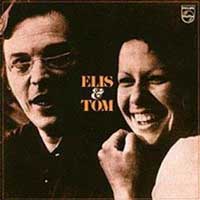
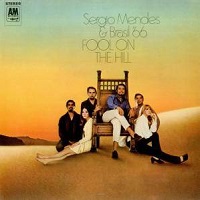

(2022-12-14)
Mein Album Numero Zwei fÞr 2023 kommt aus Brasilien!
(2022-12-28)